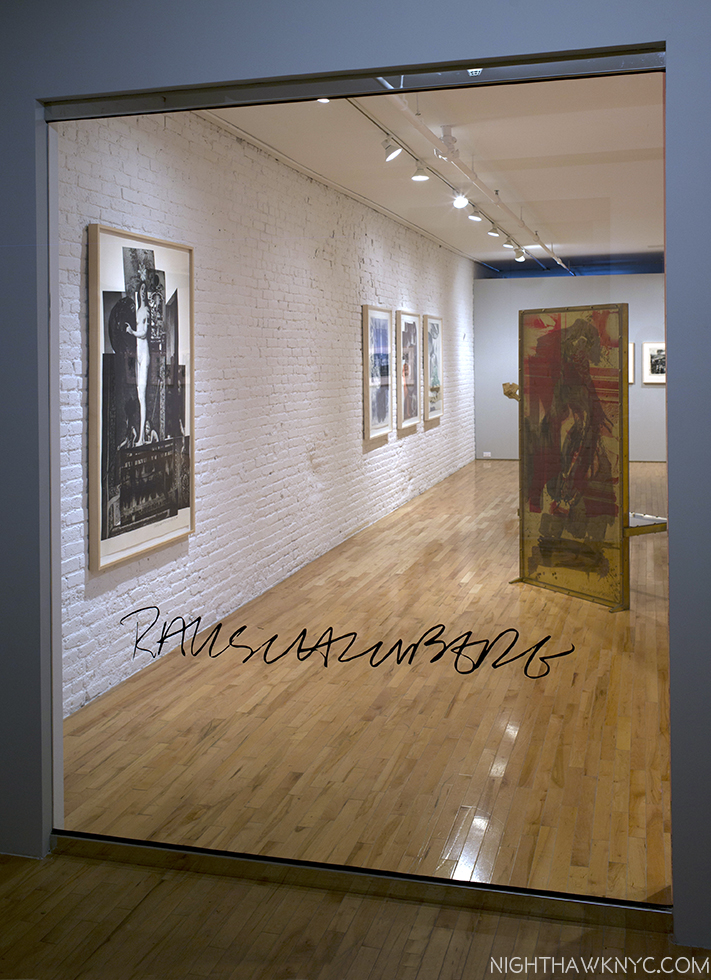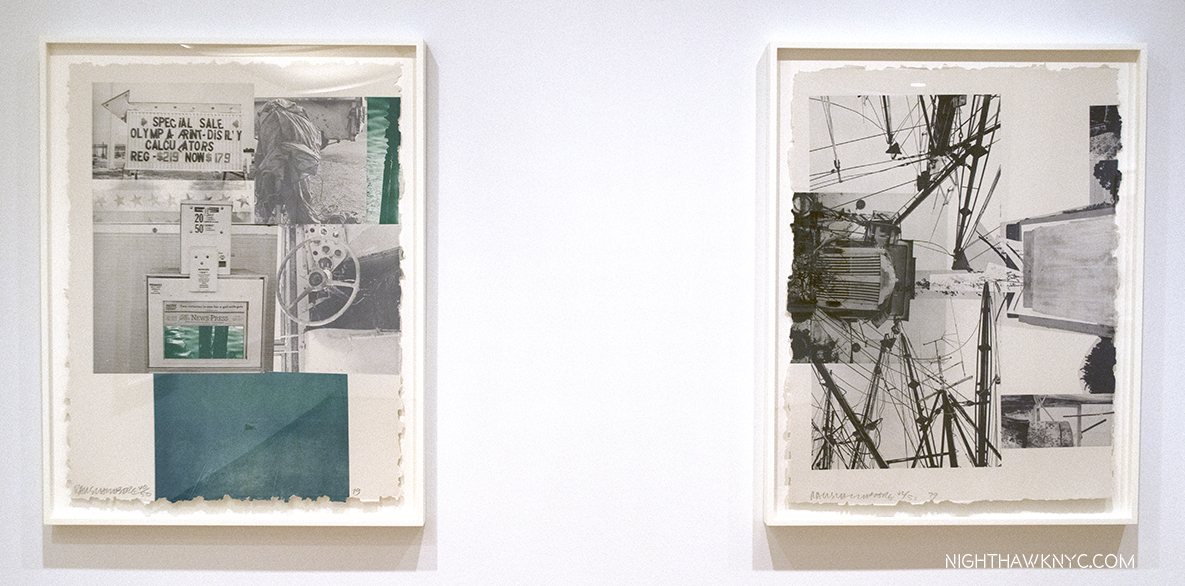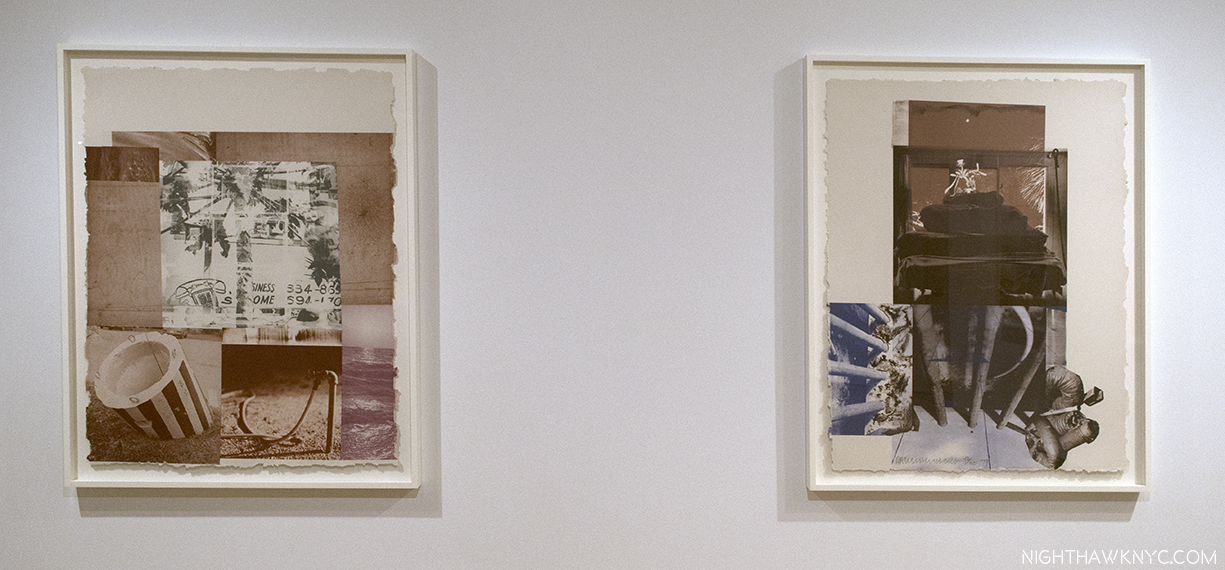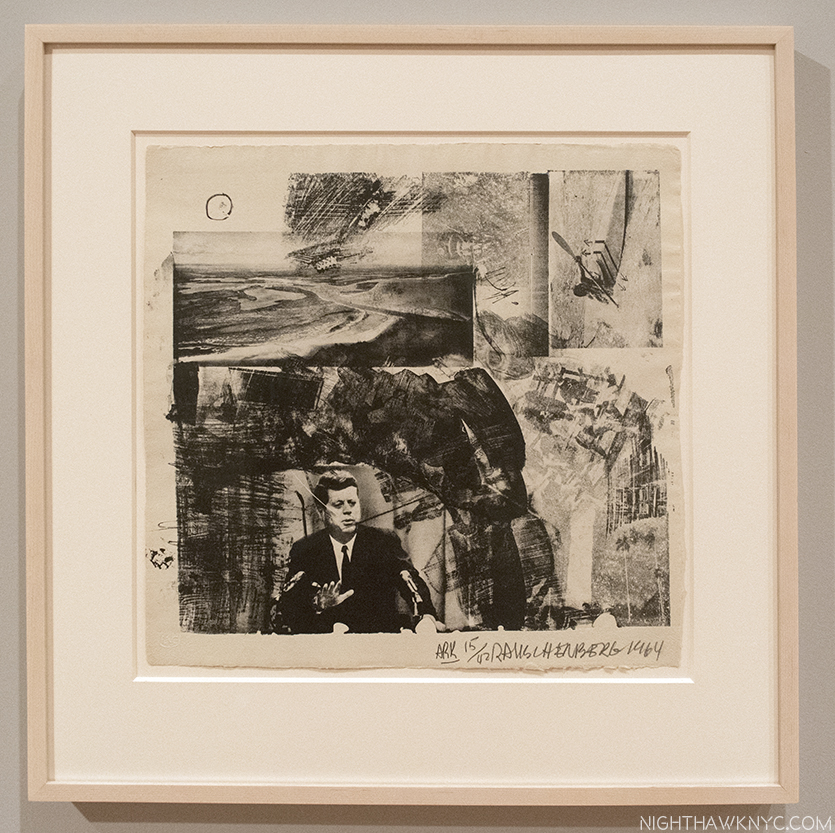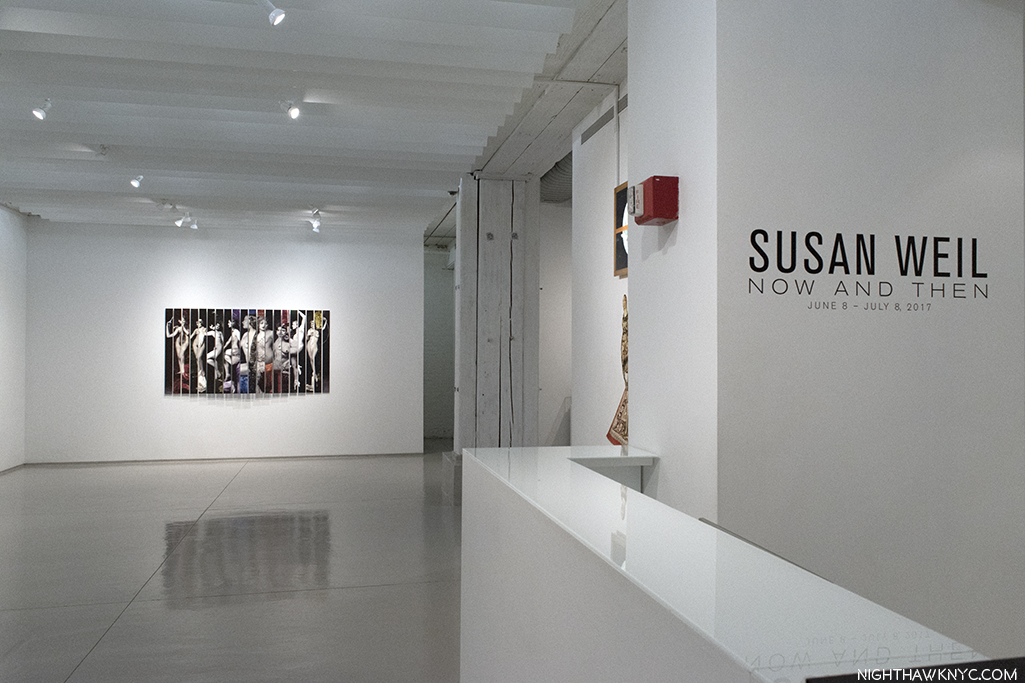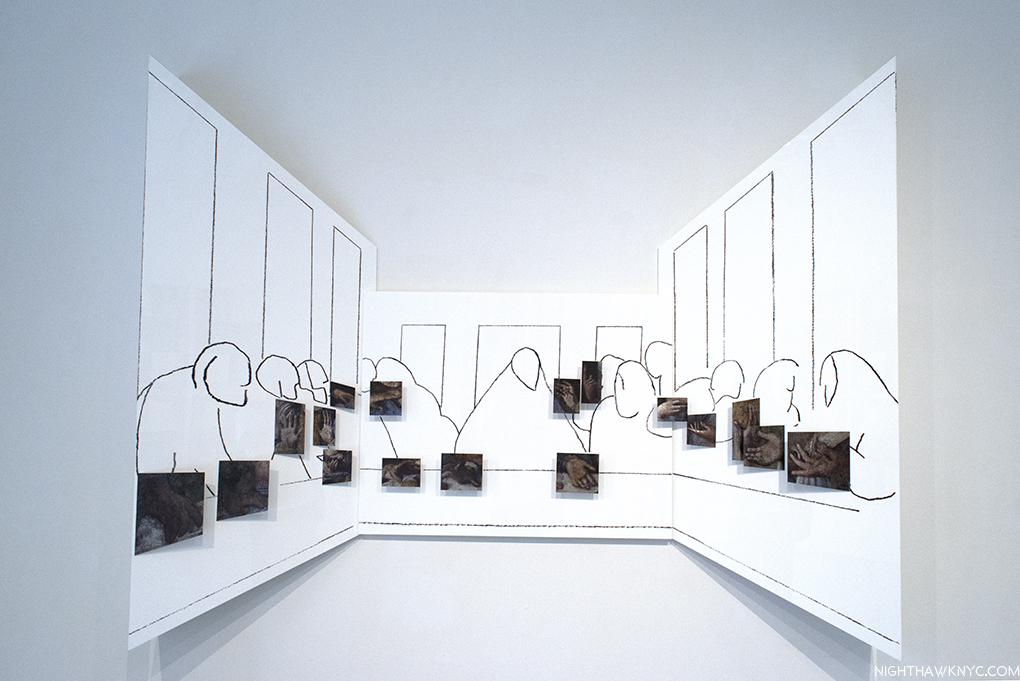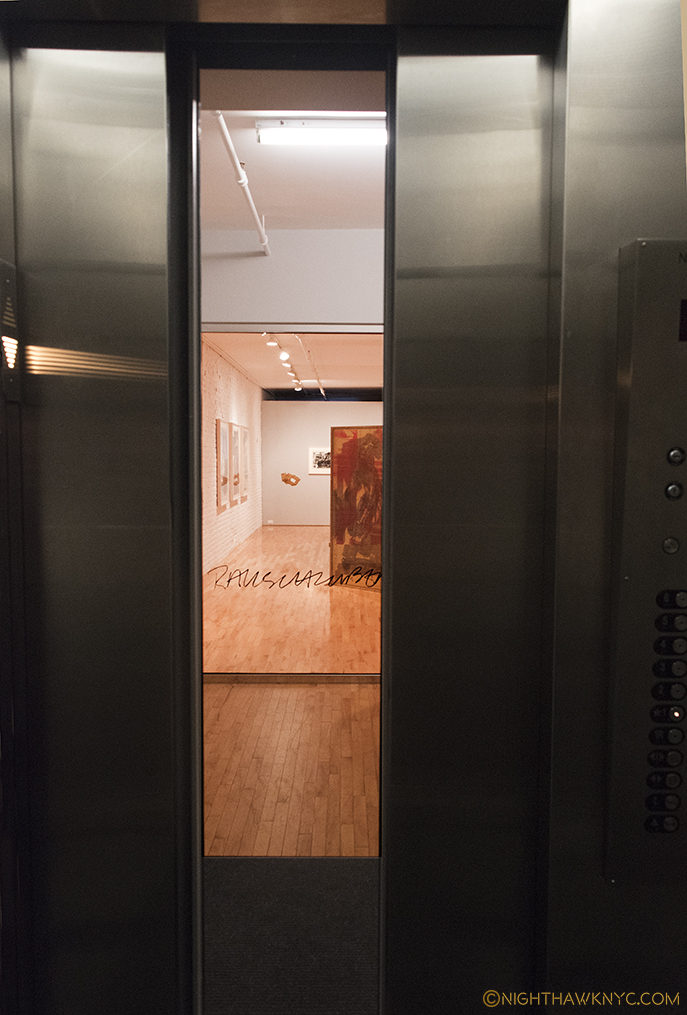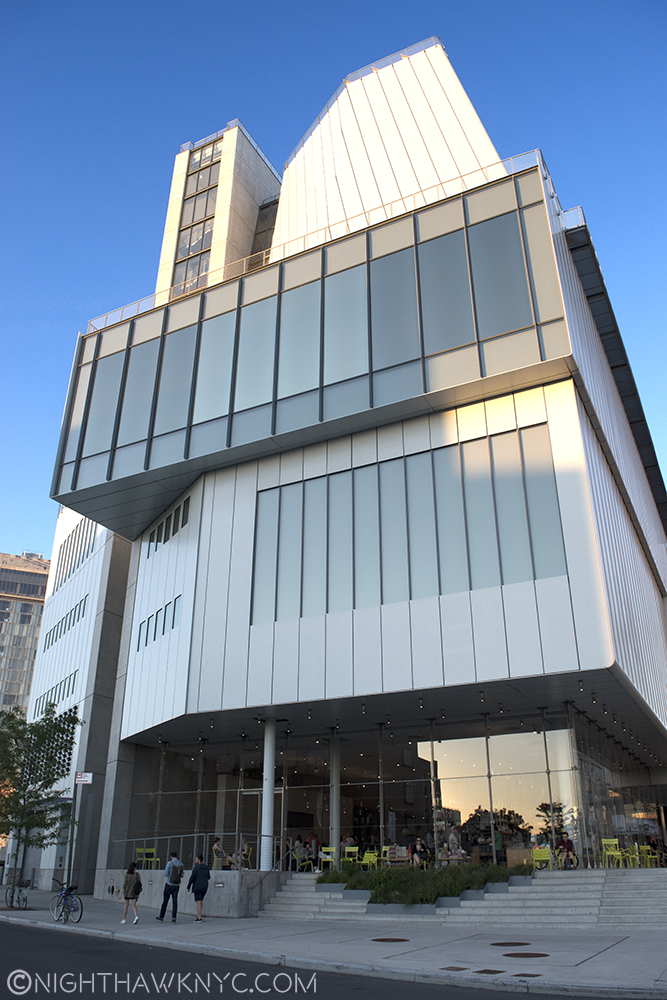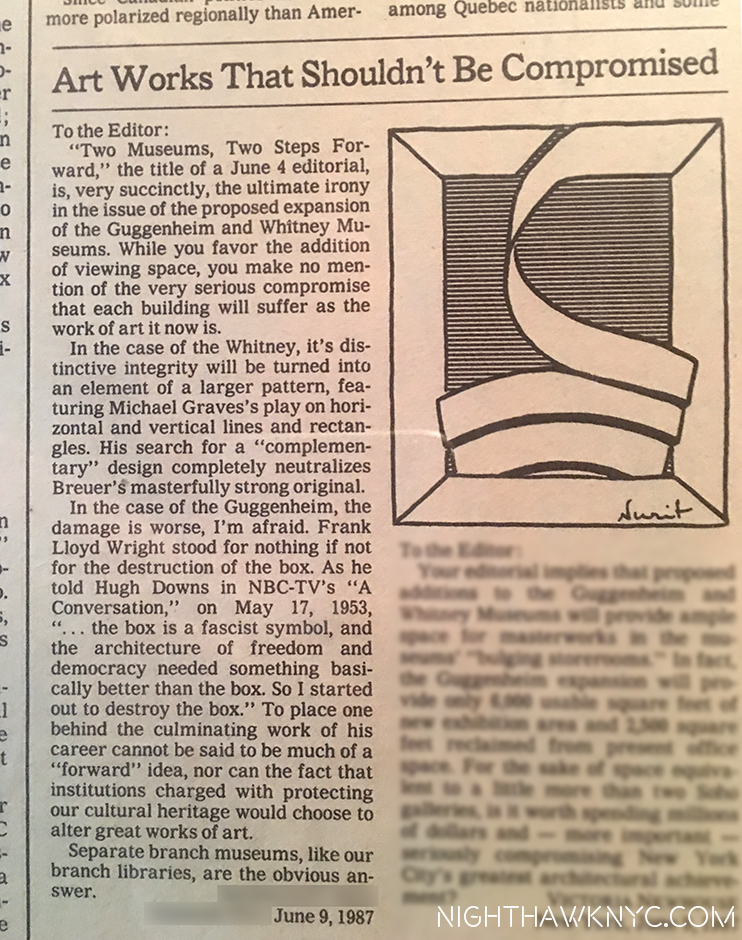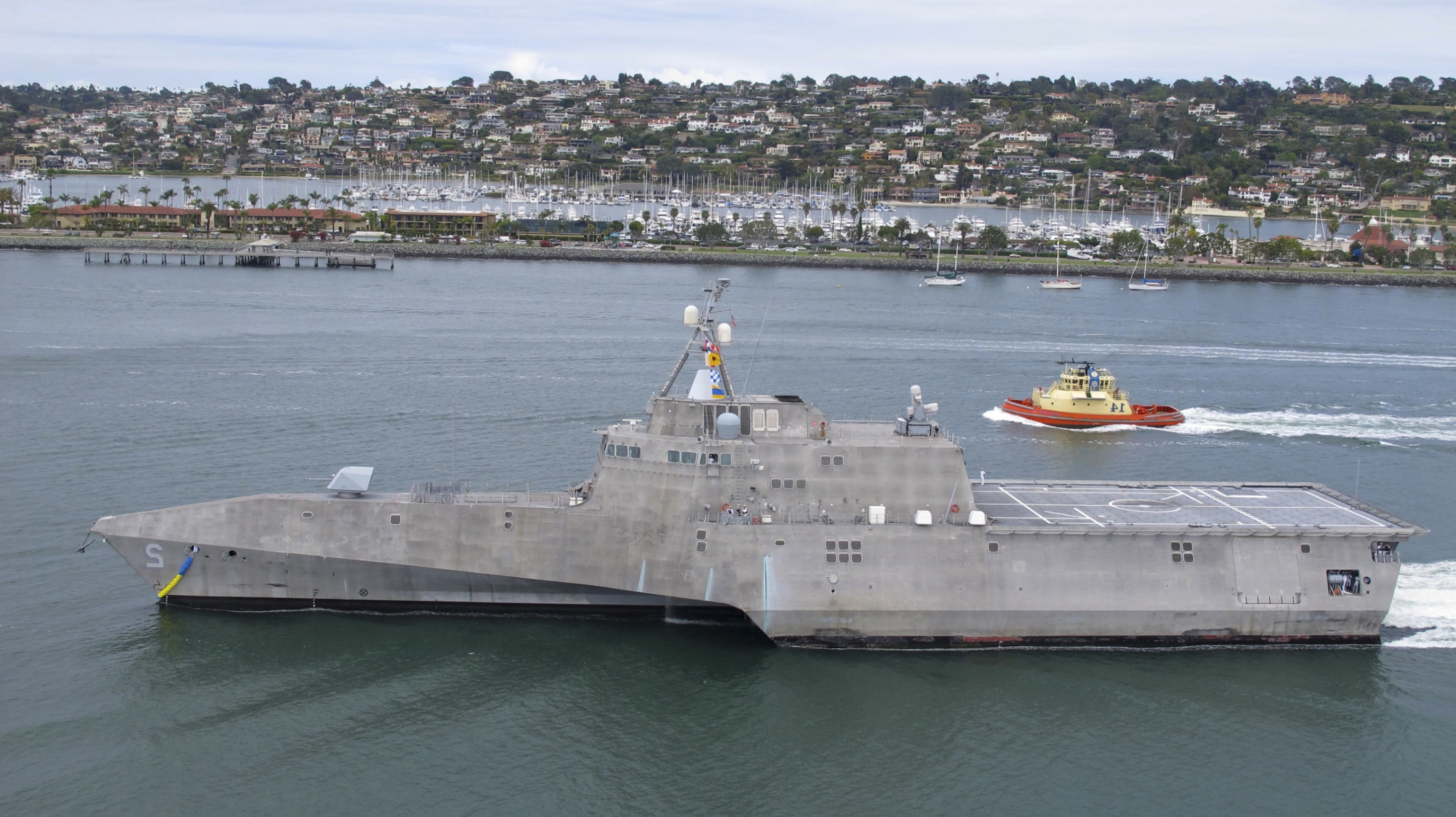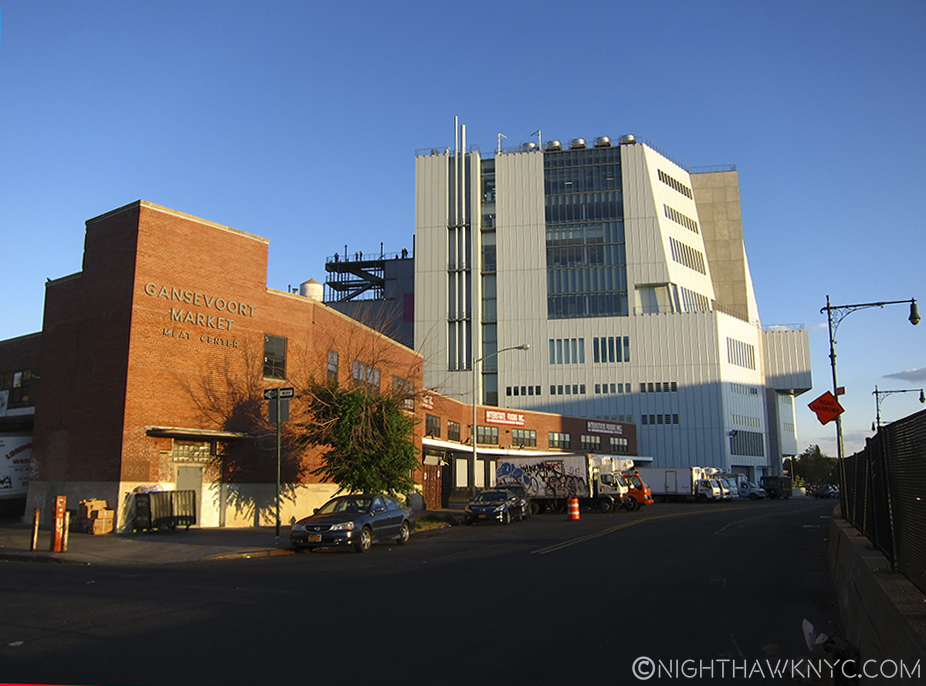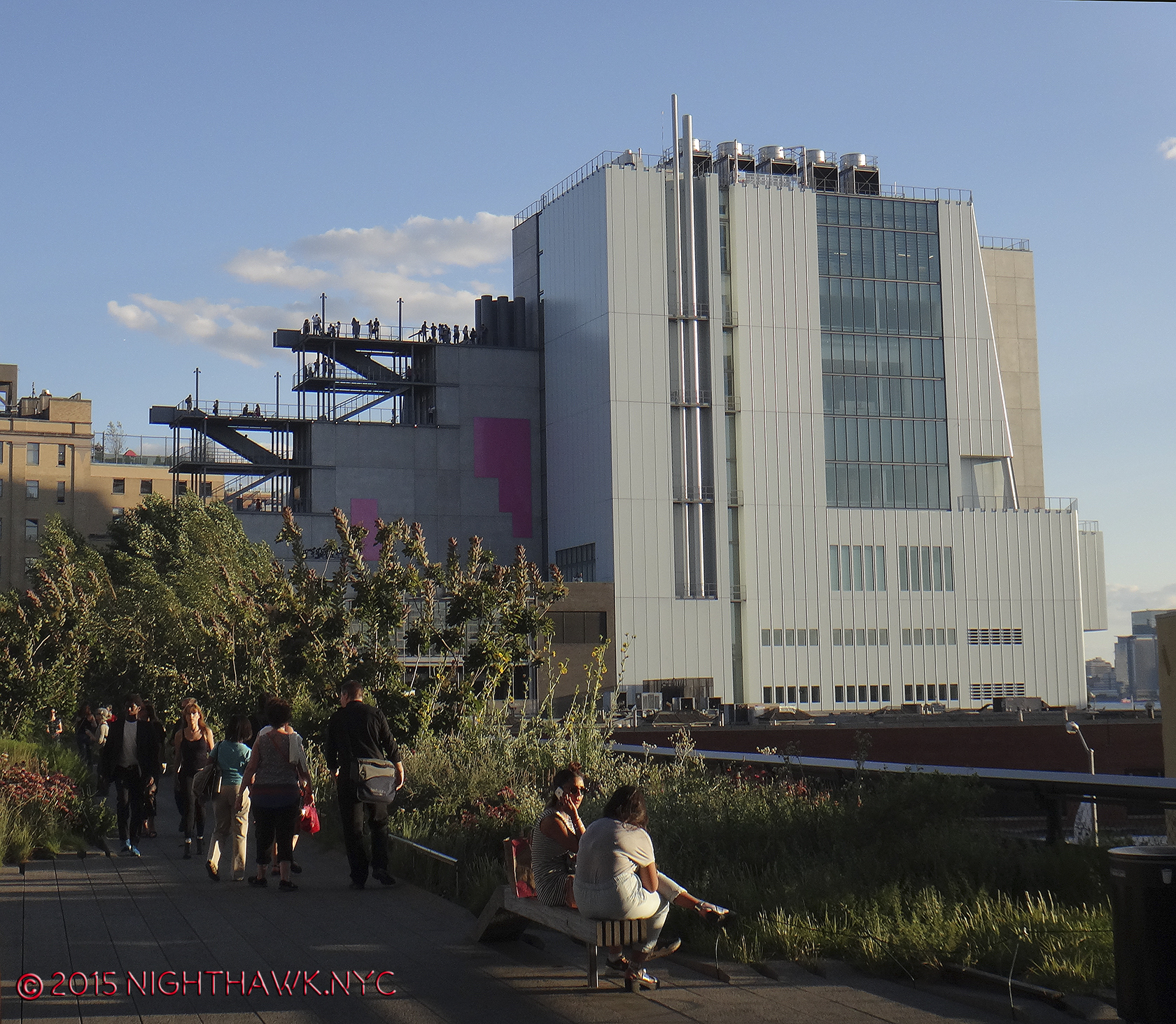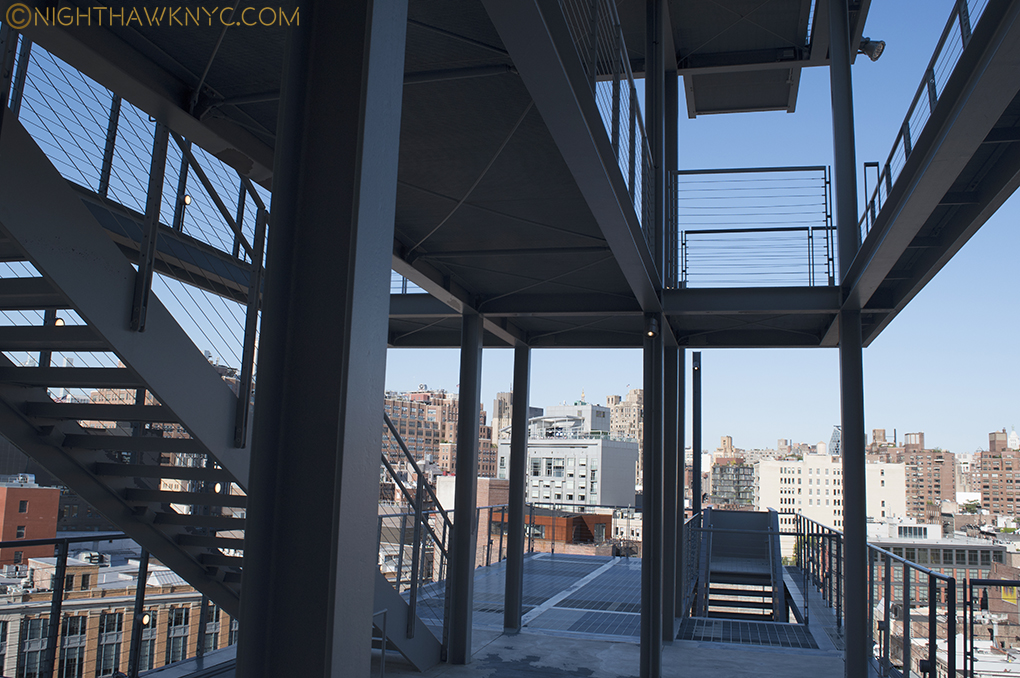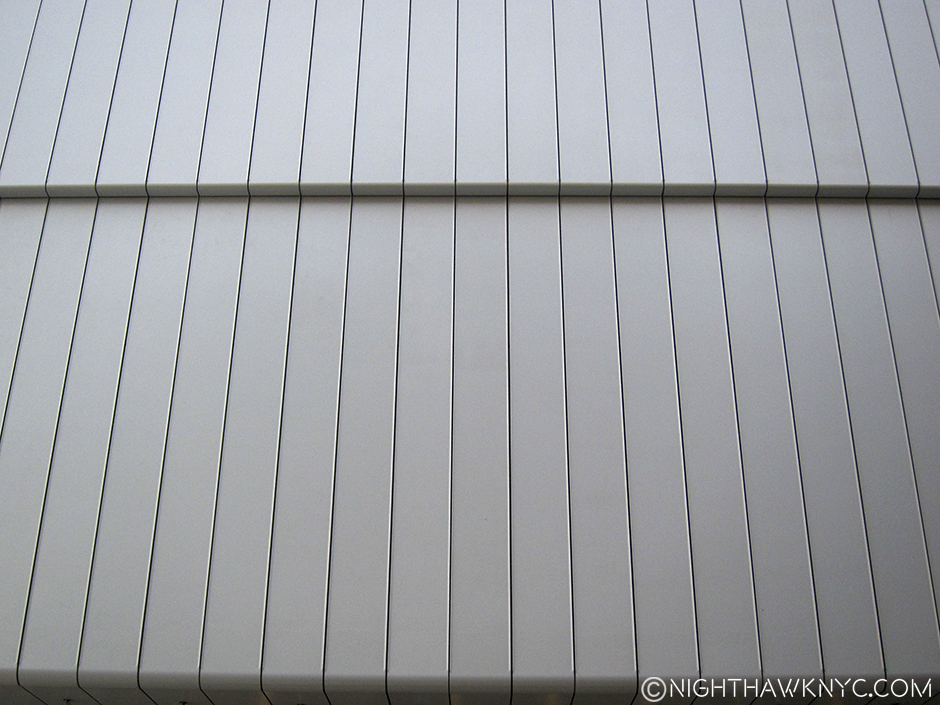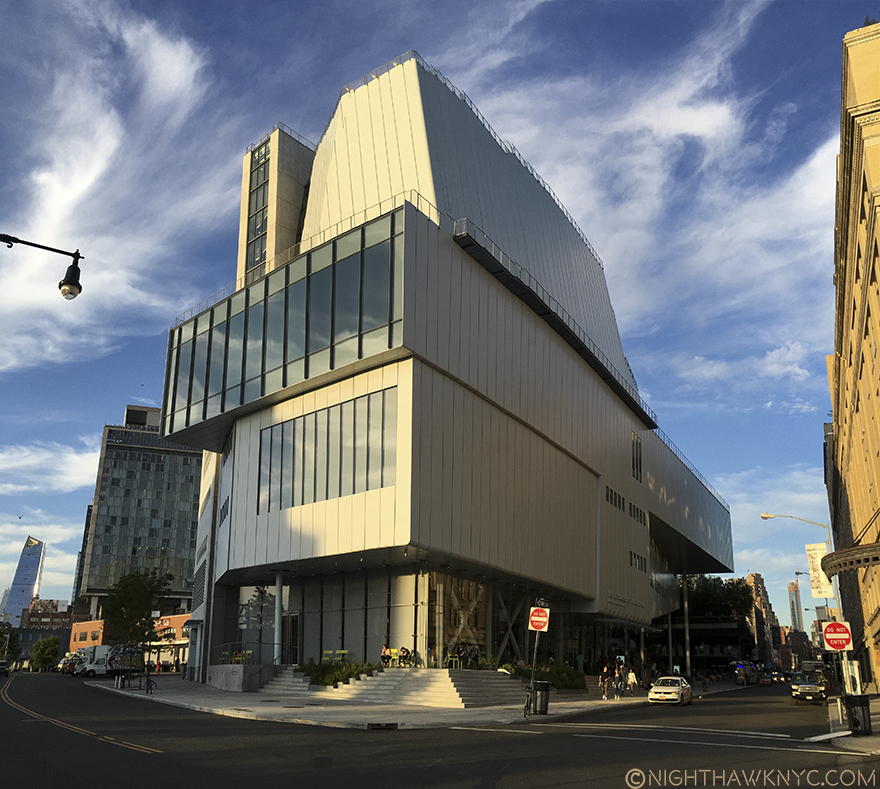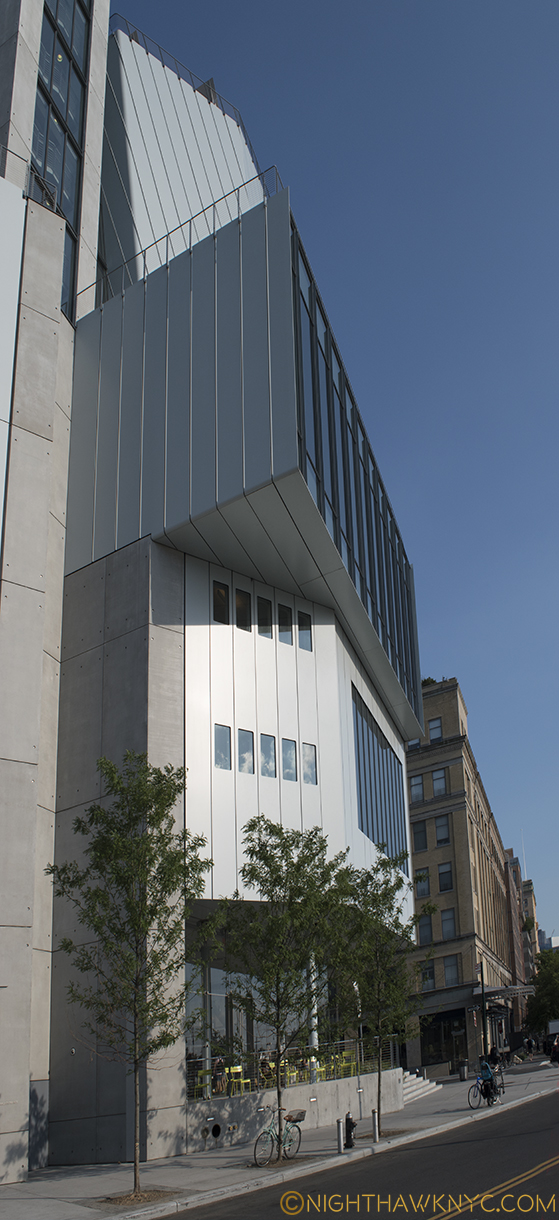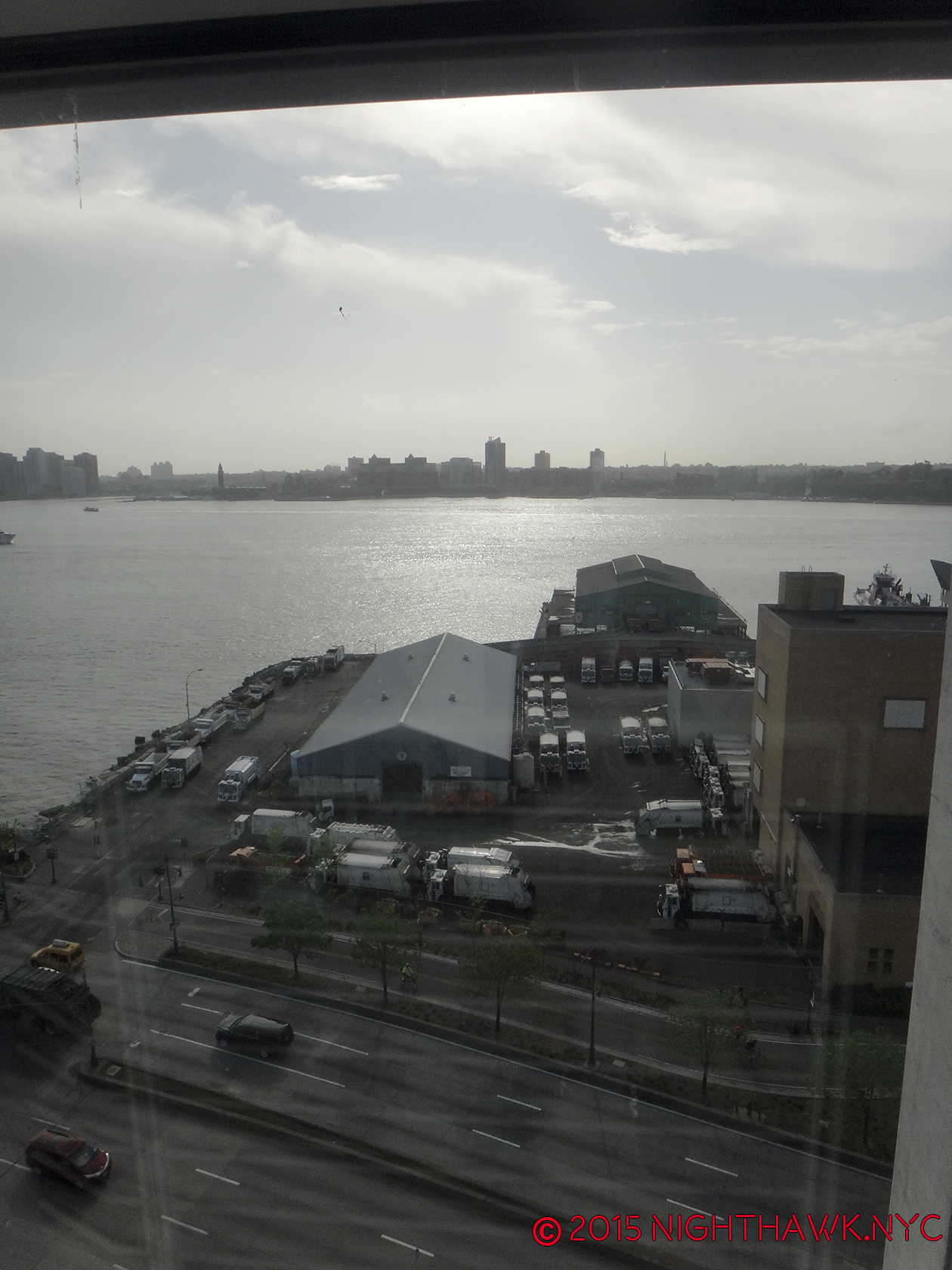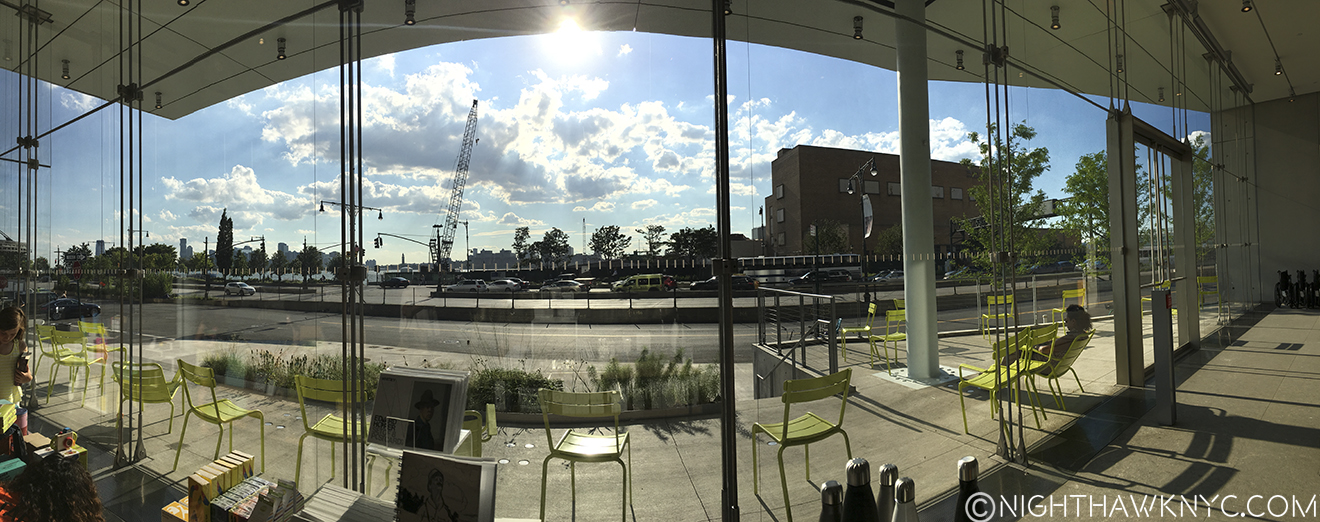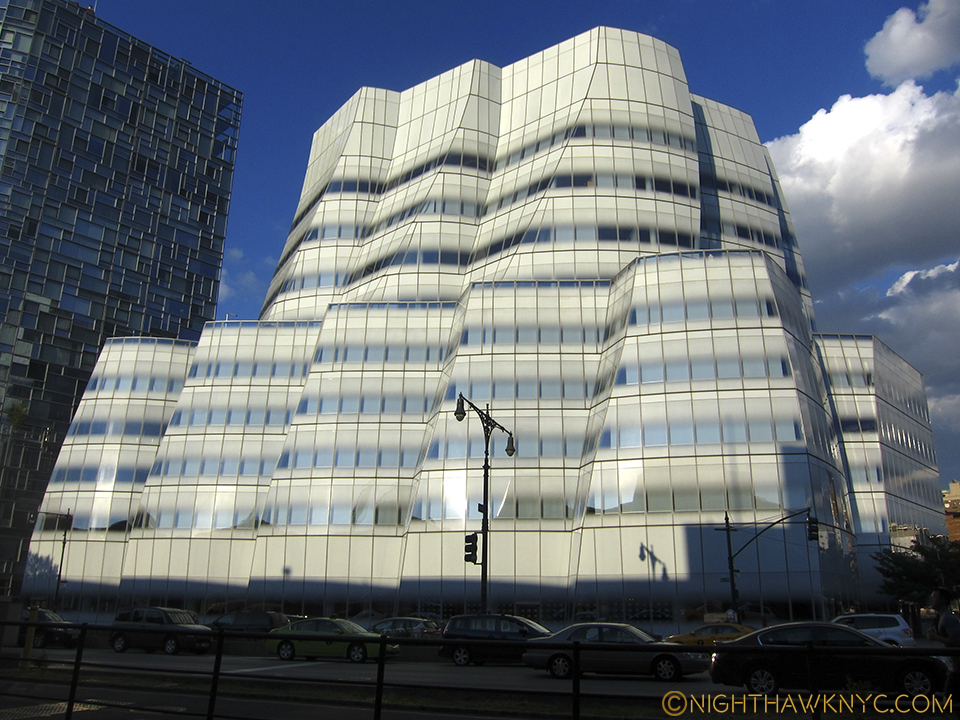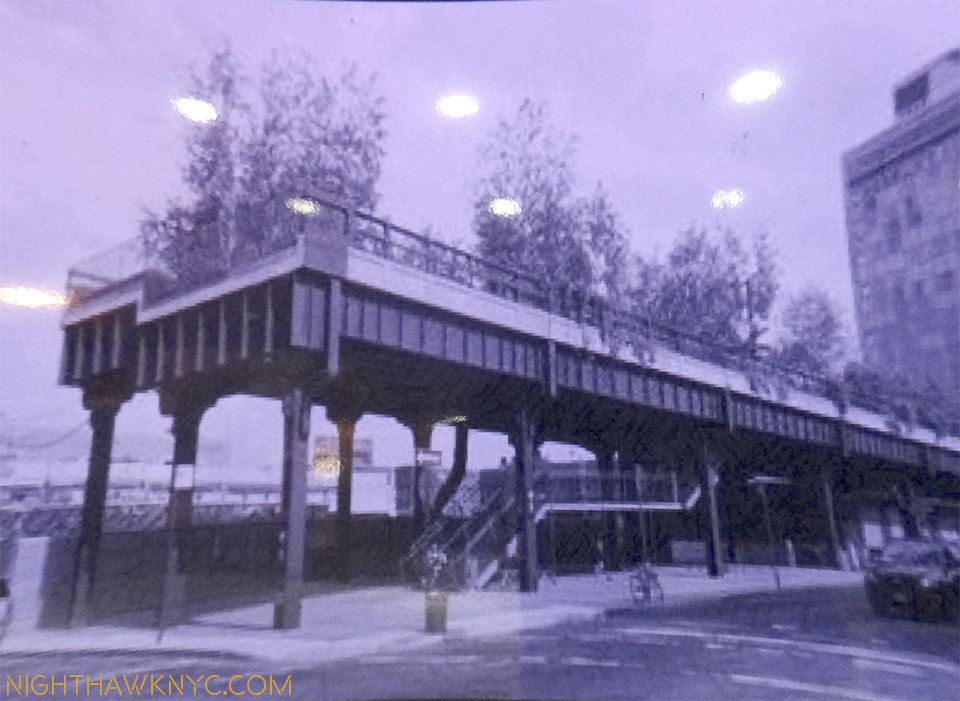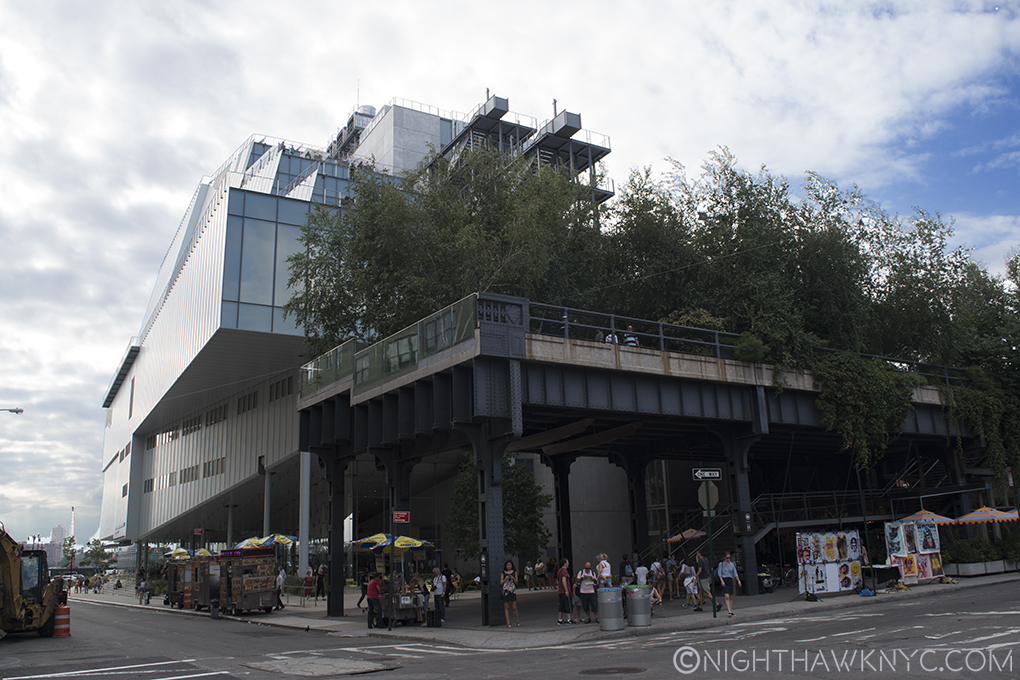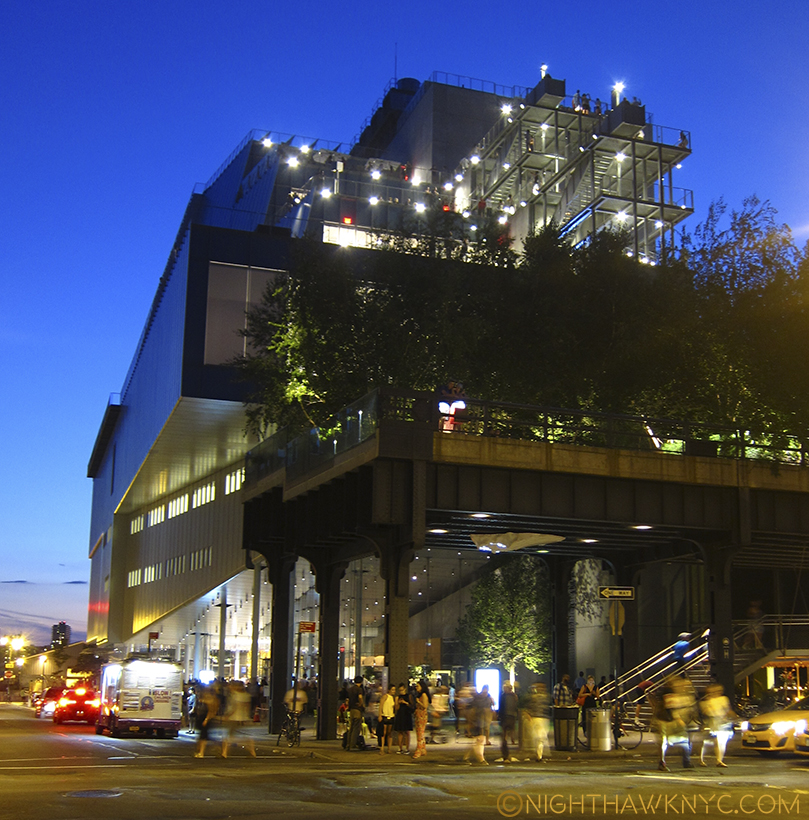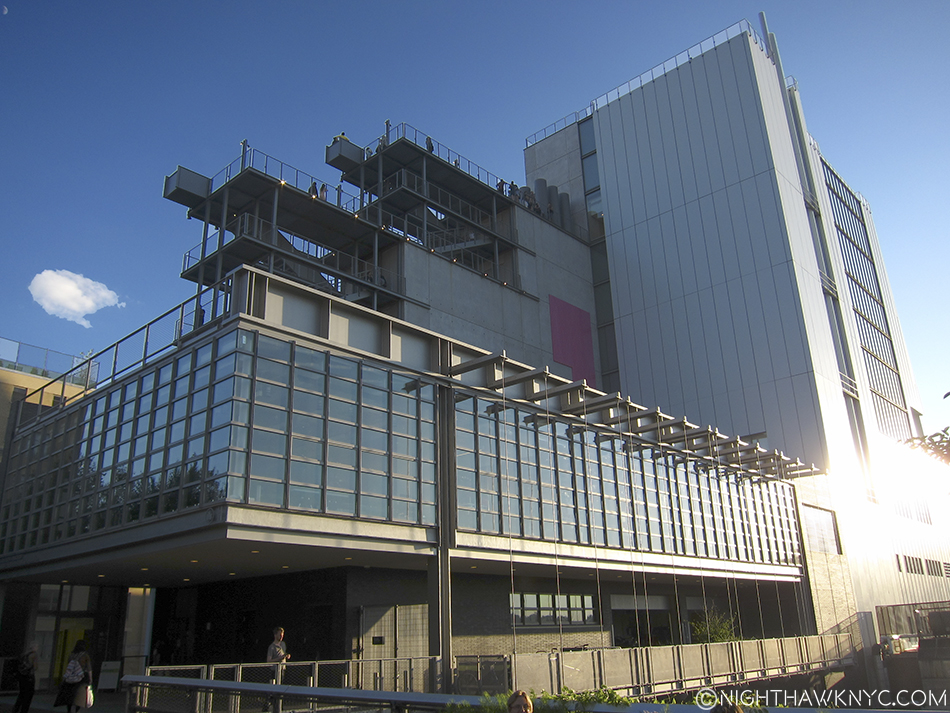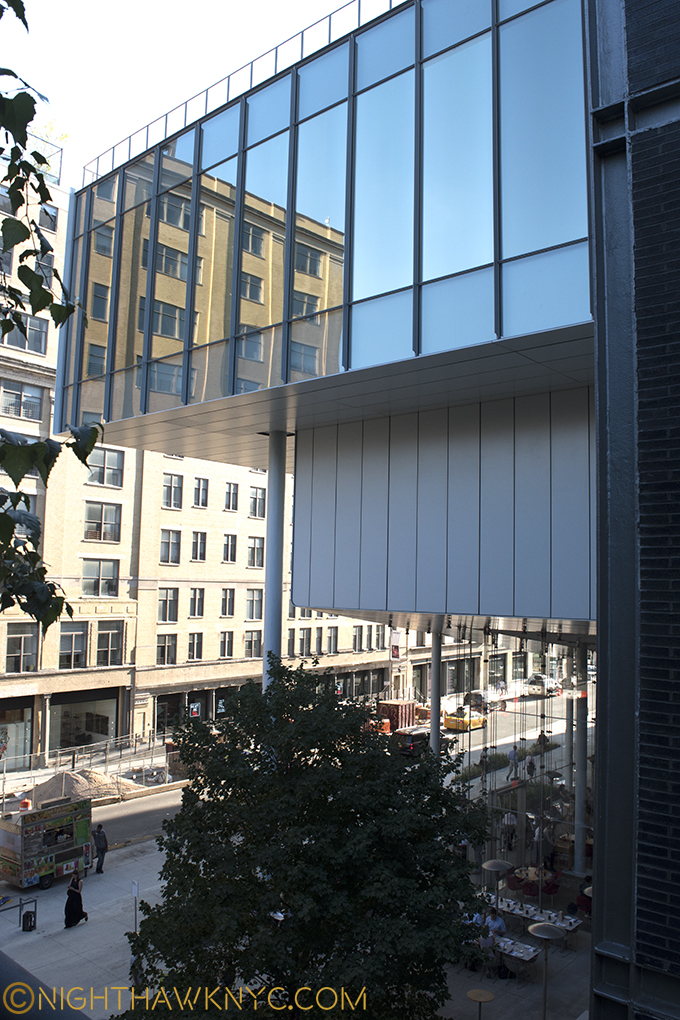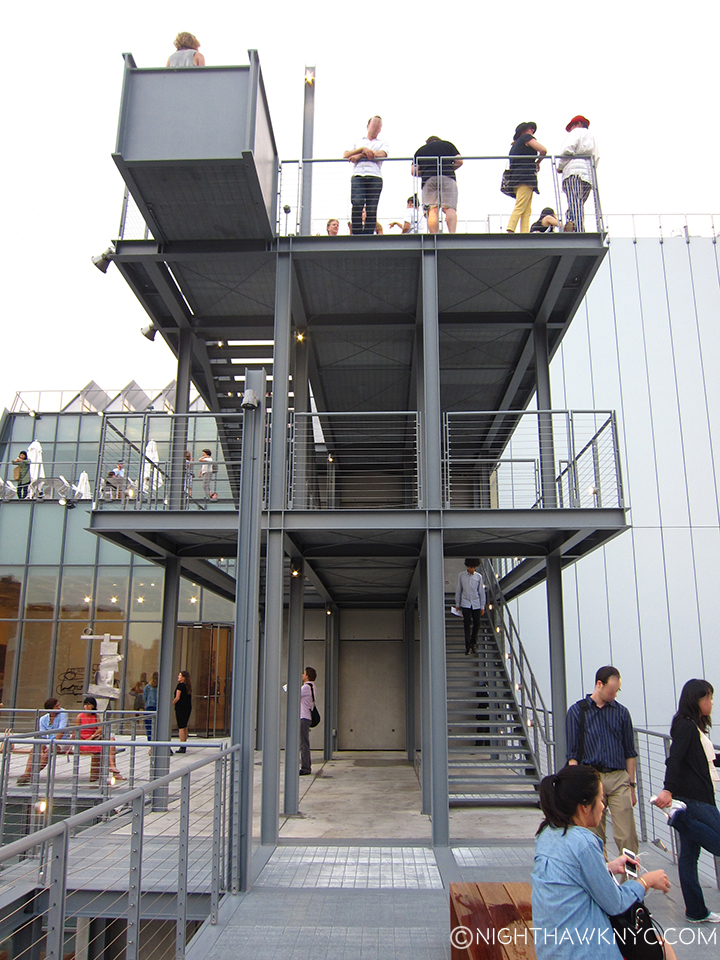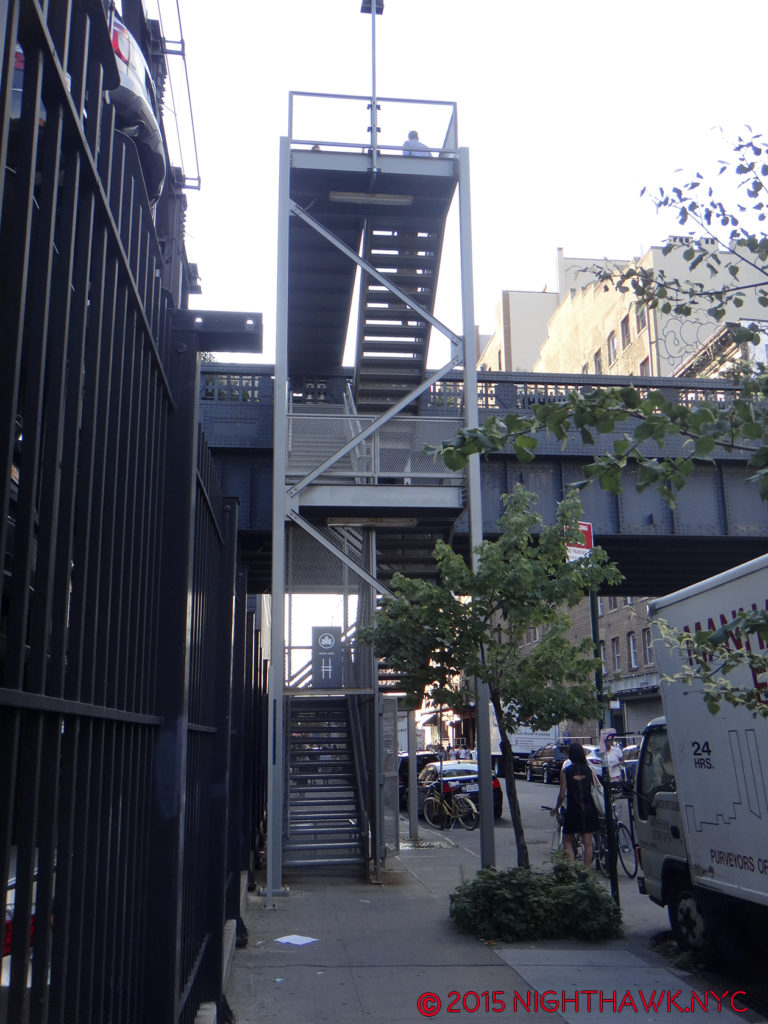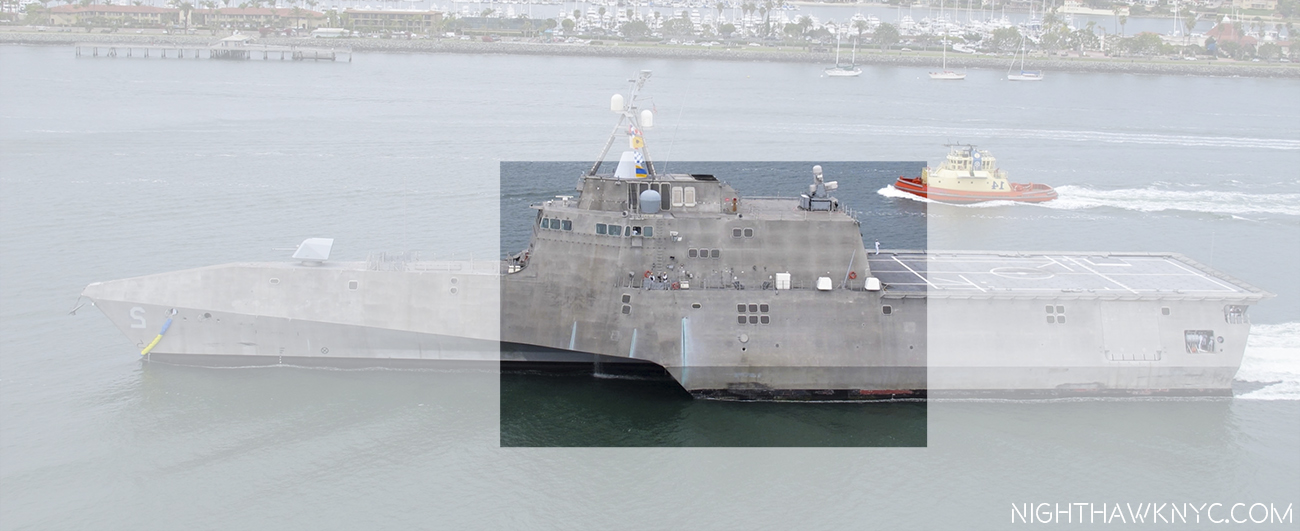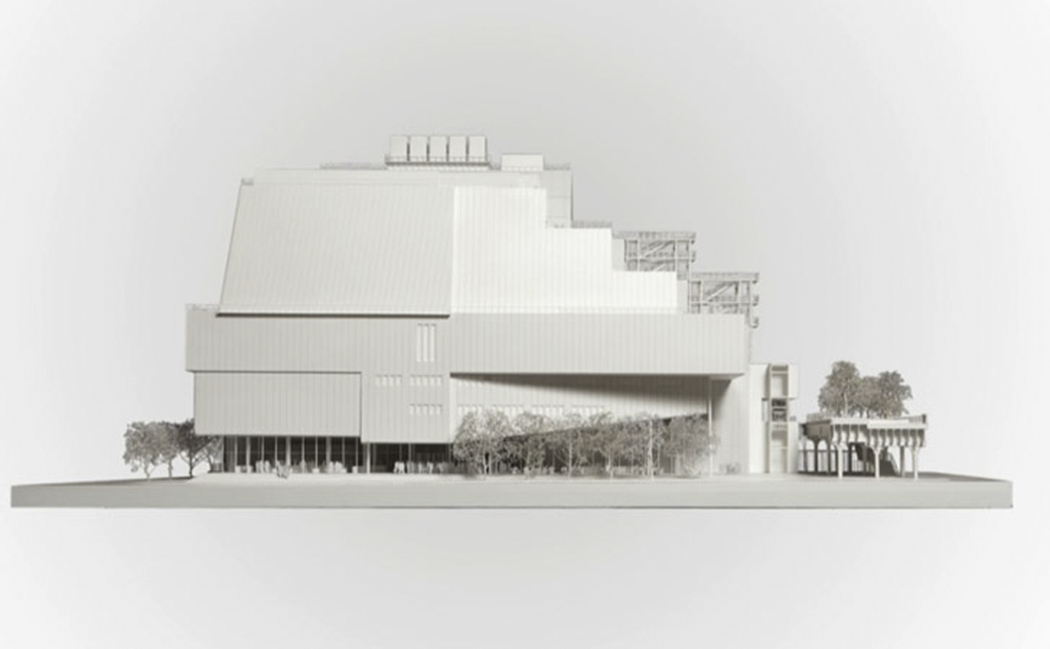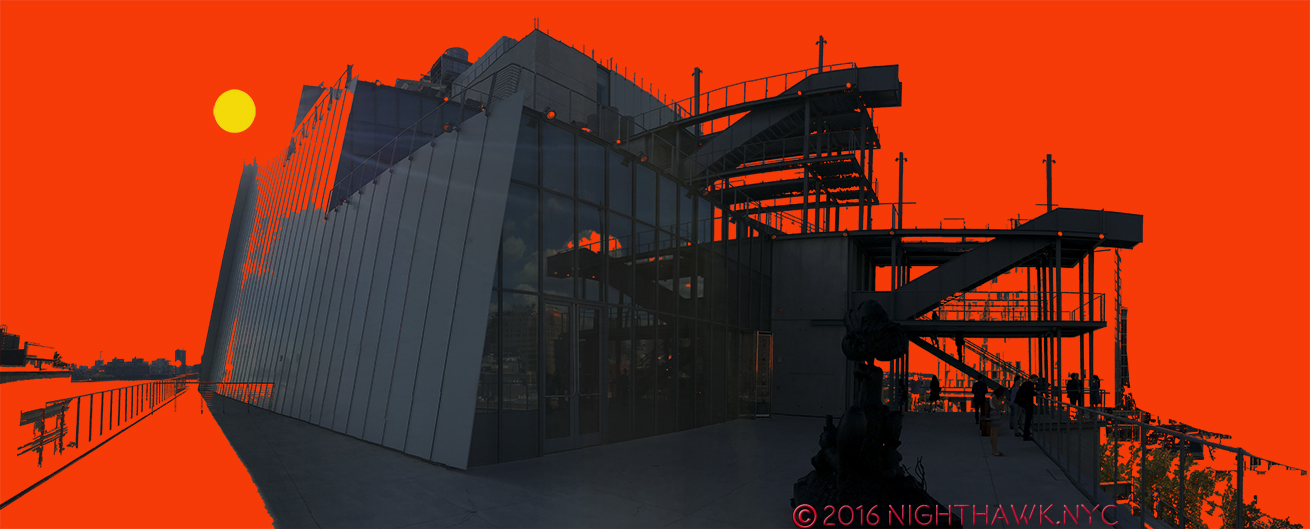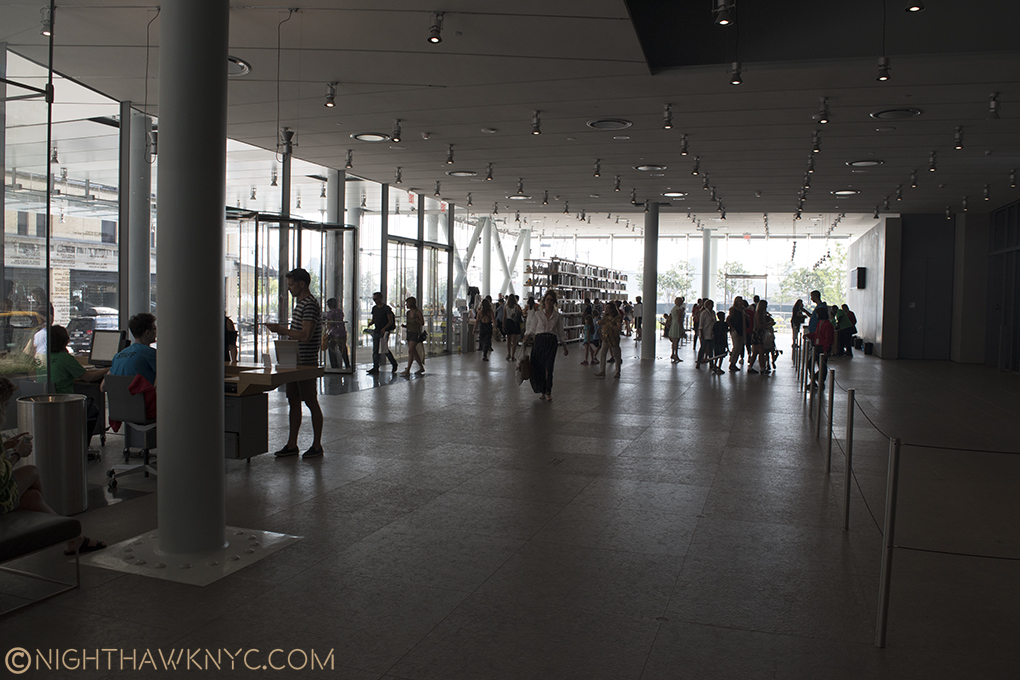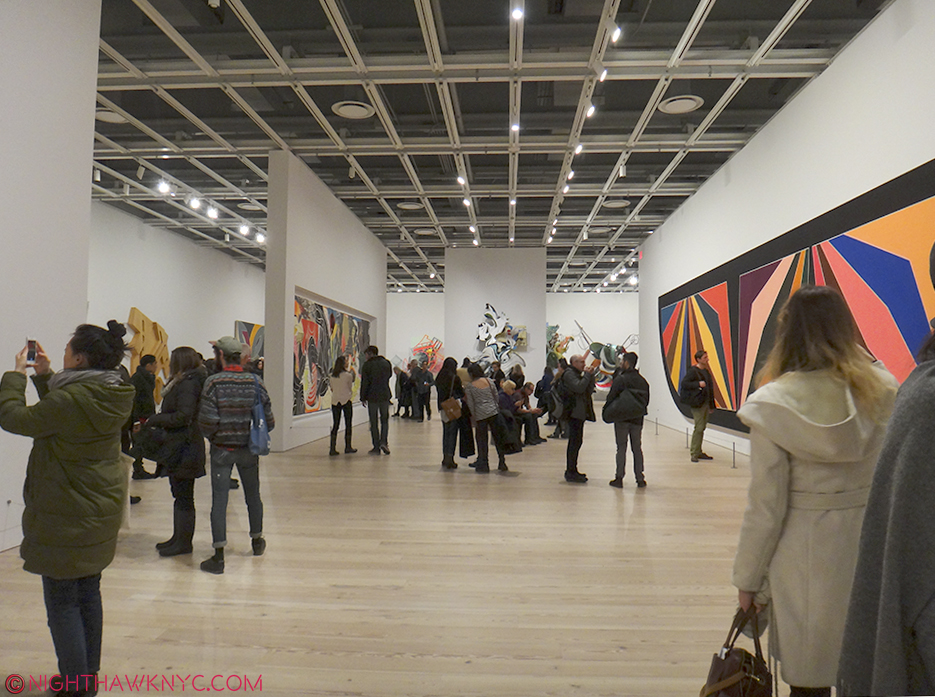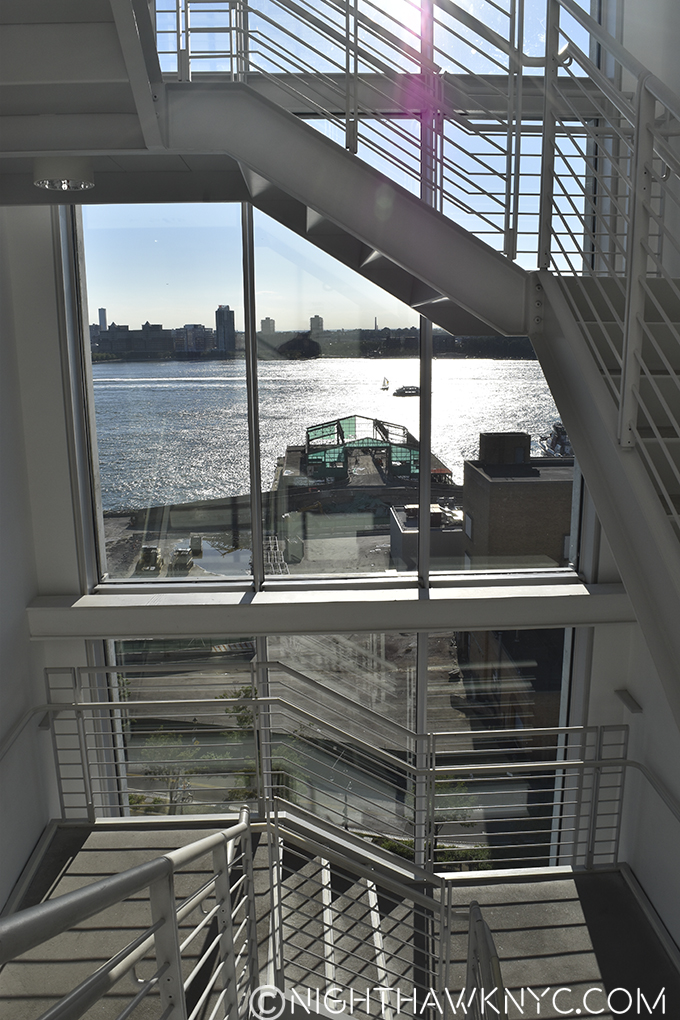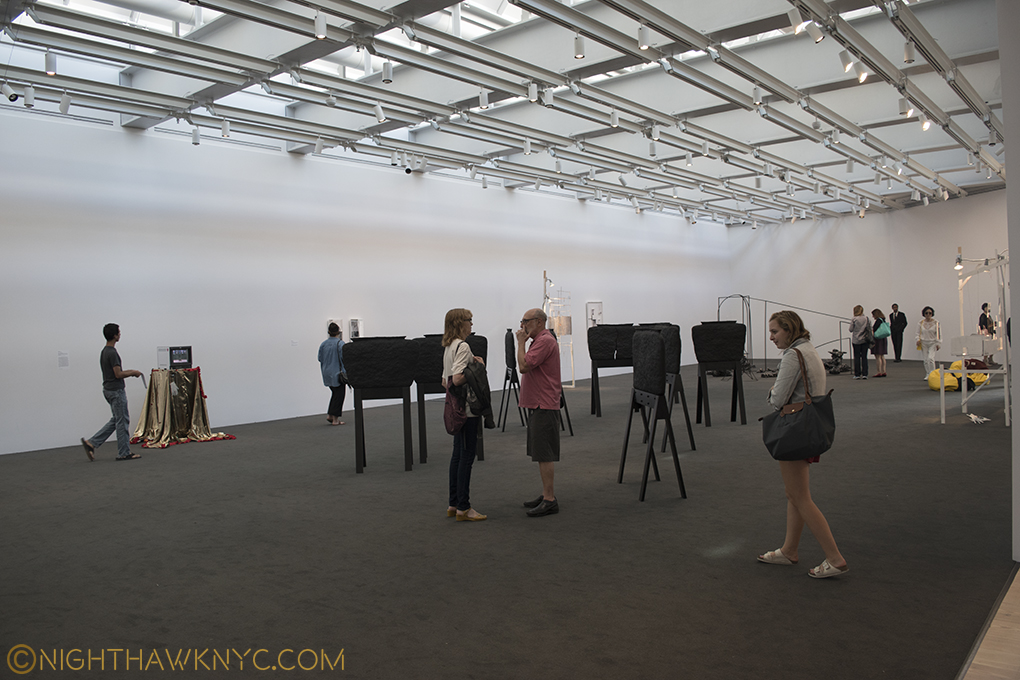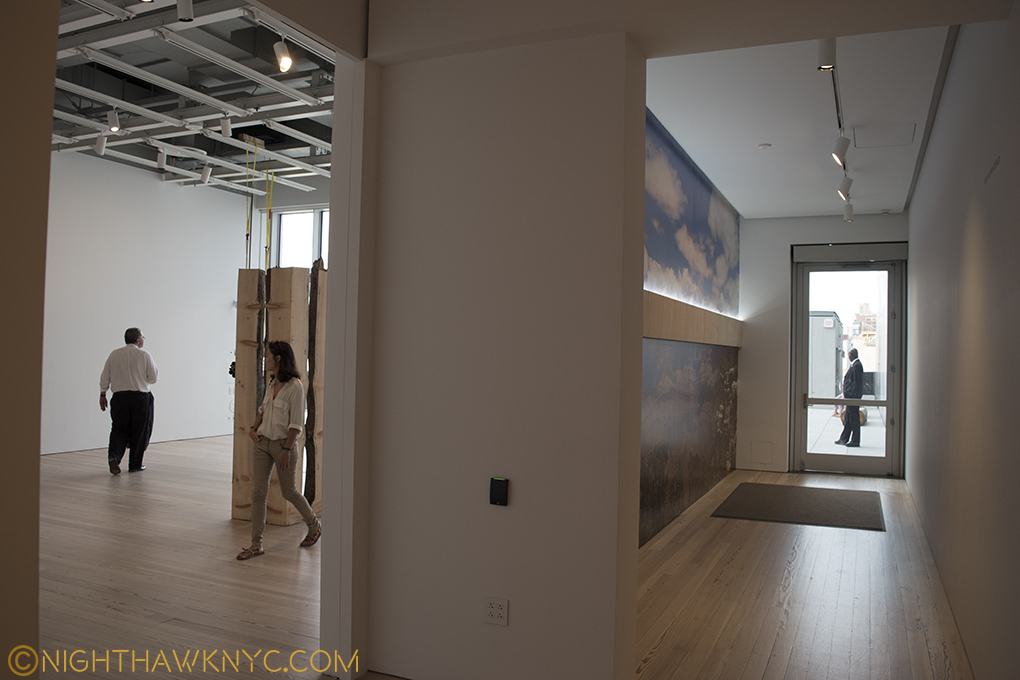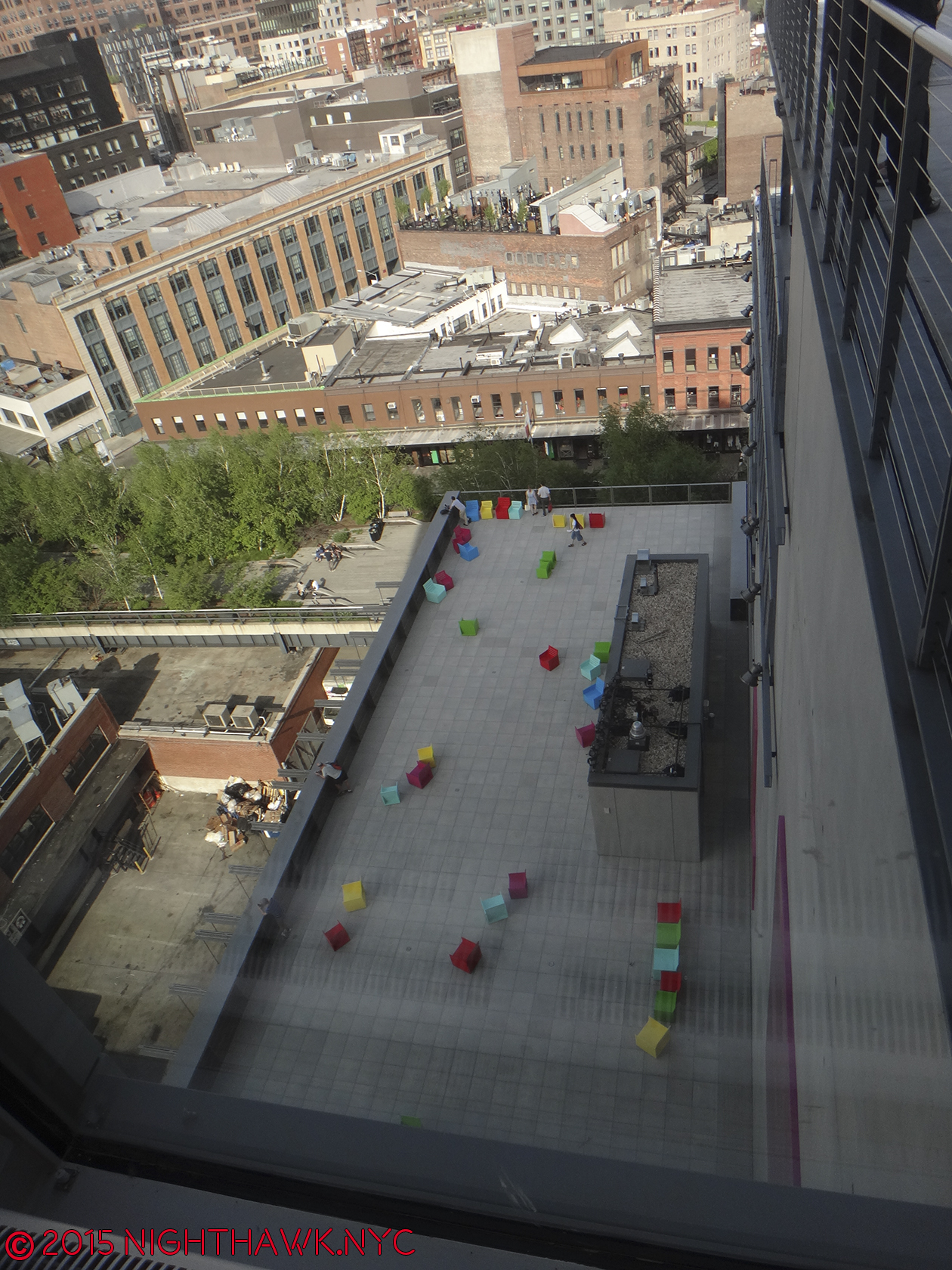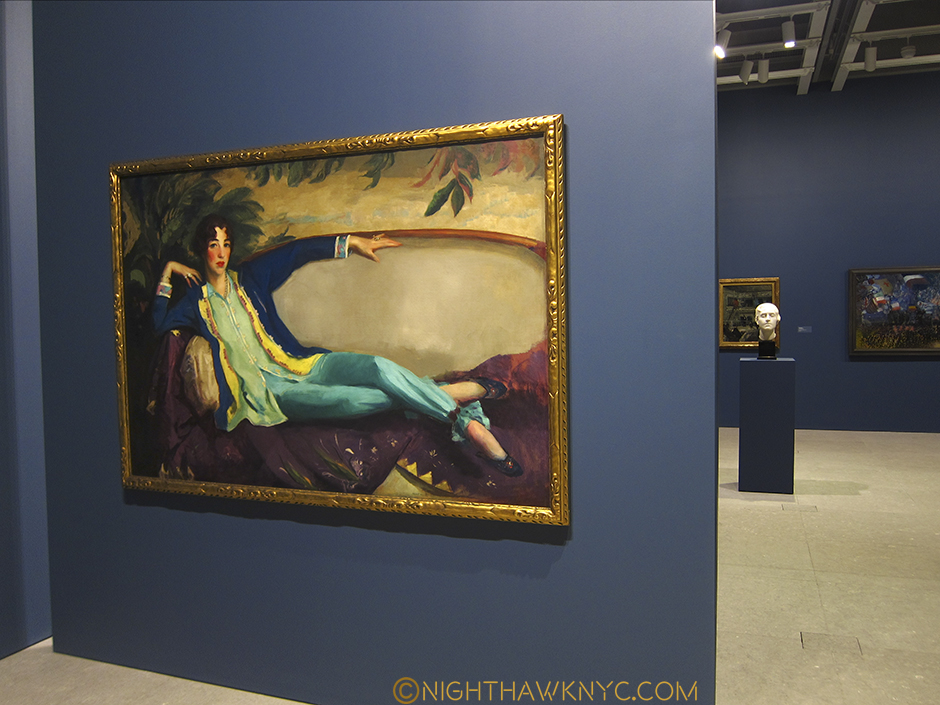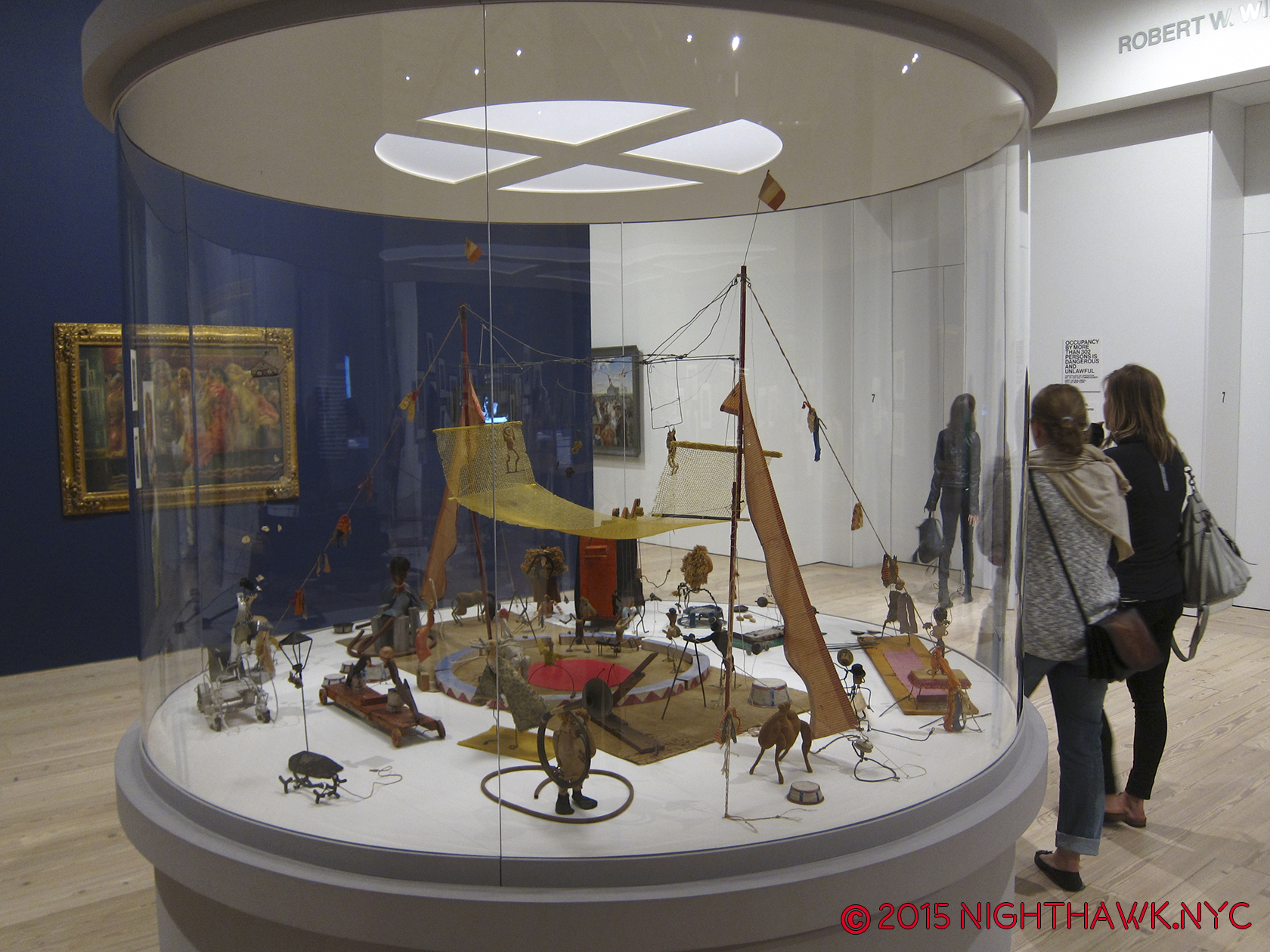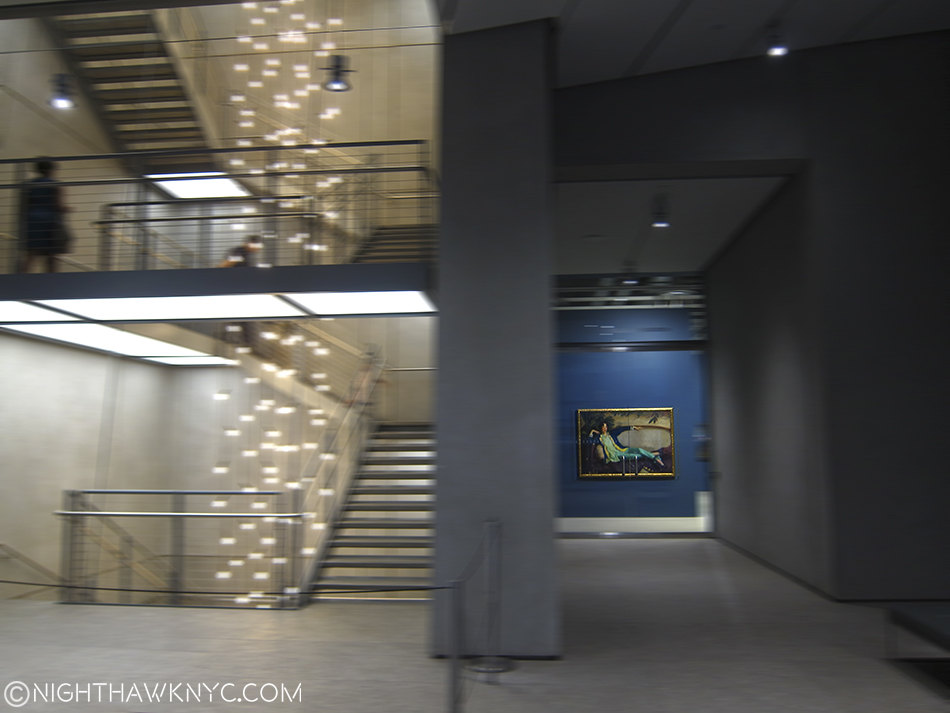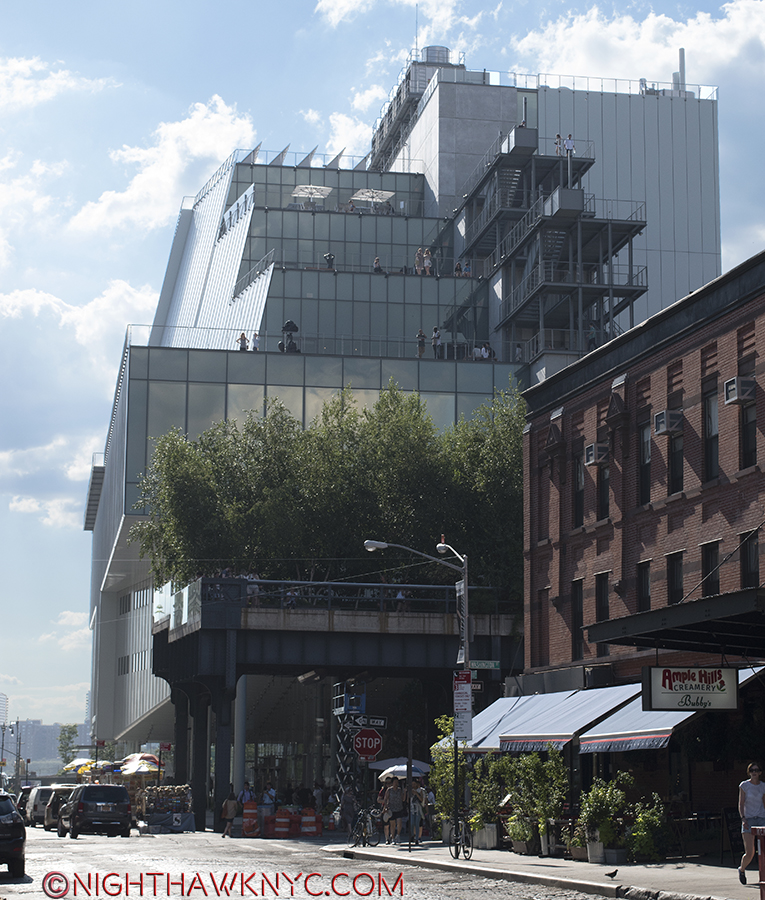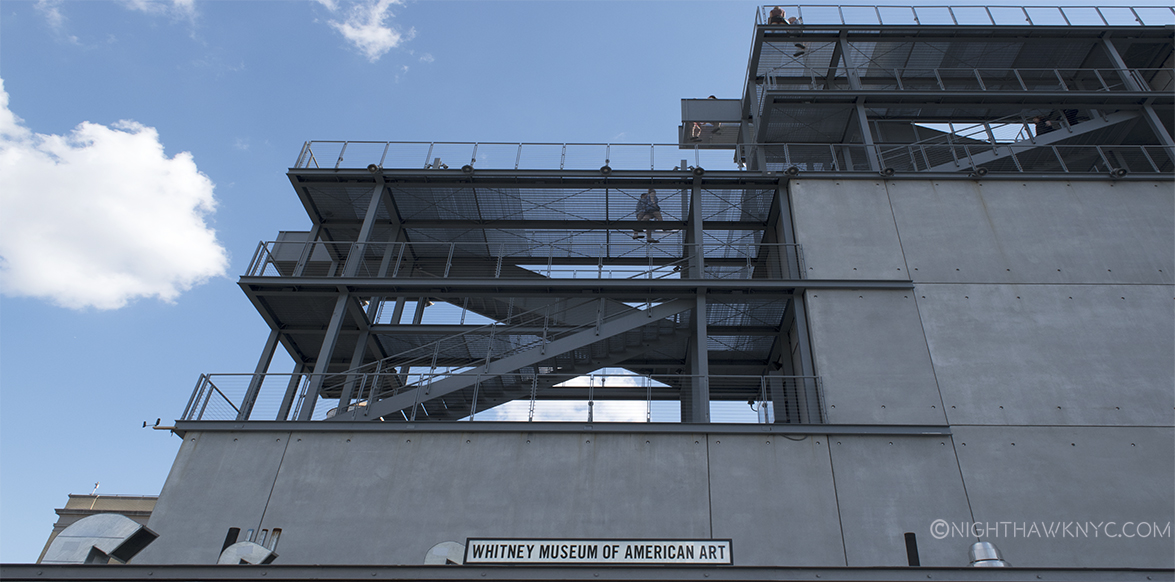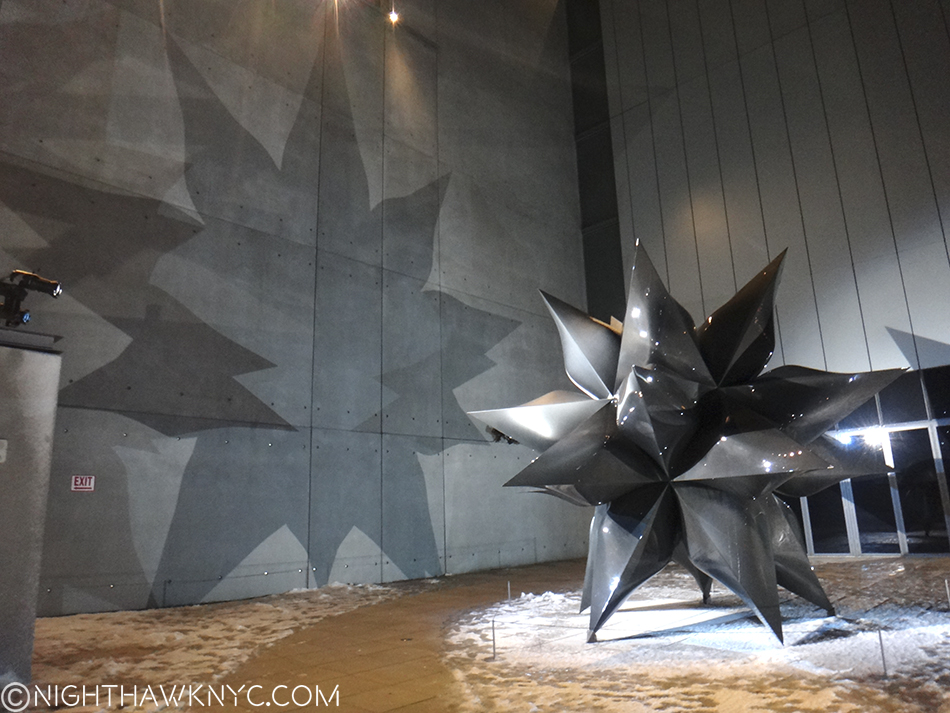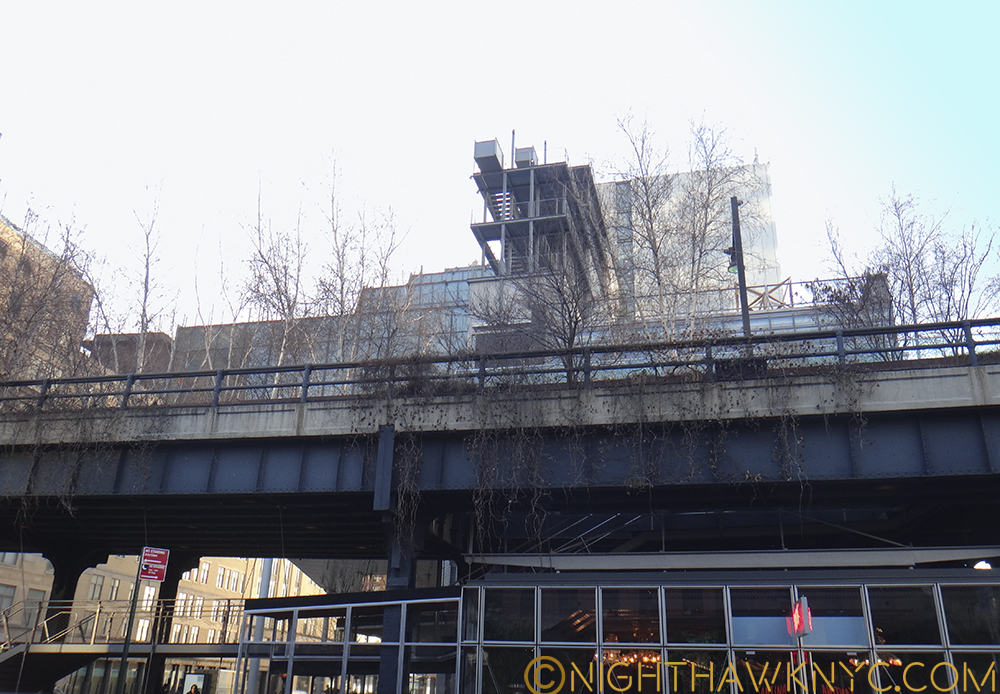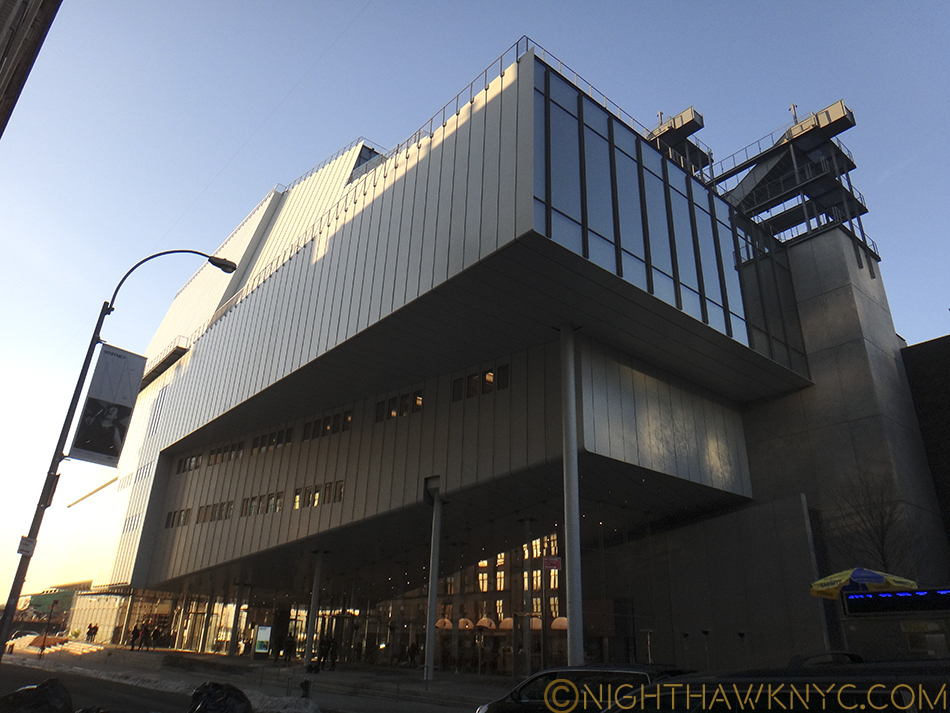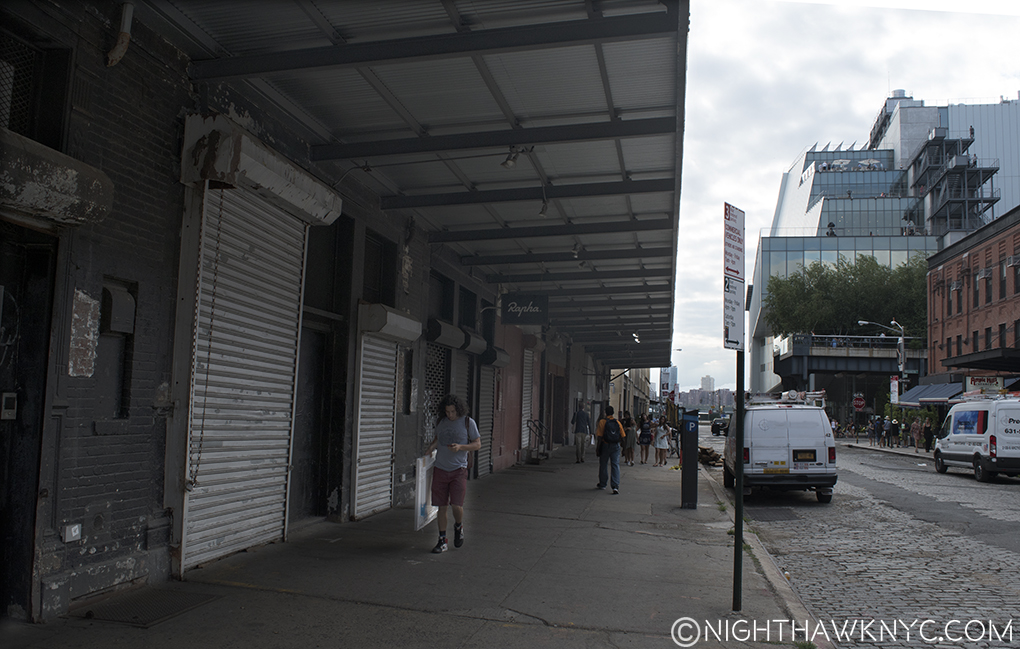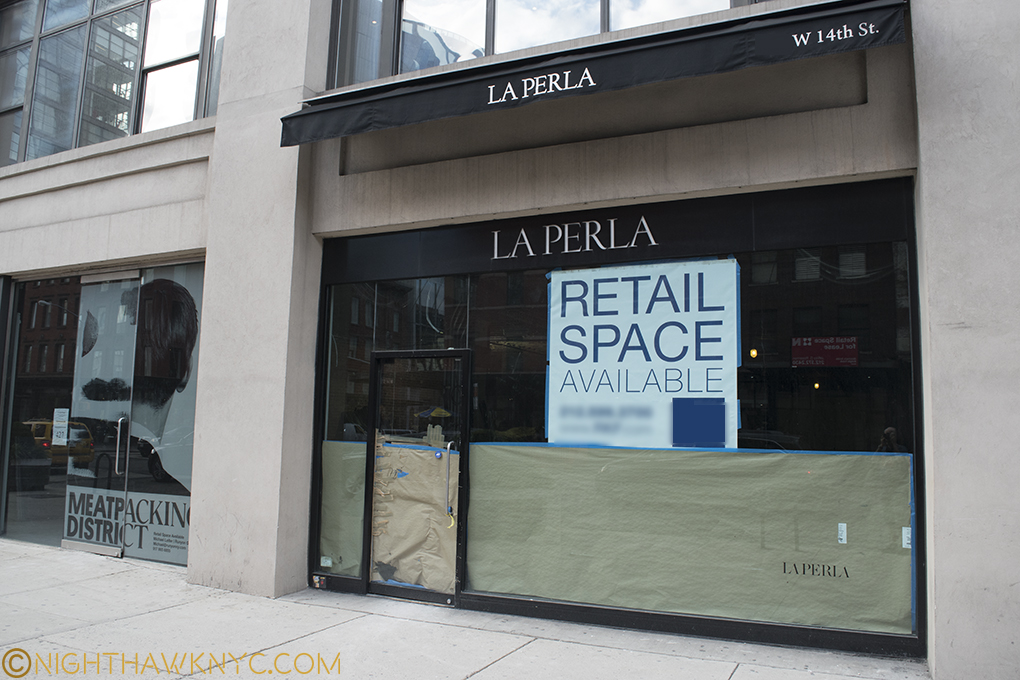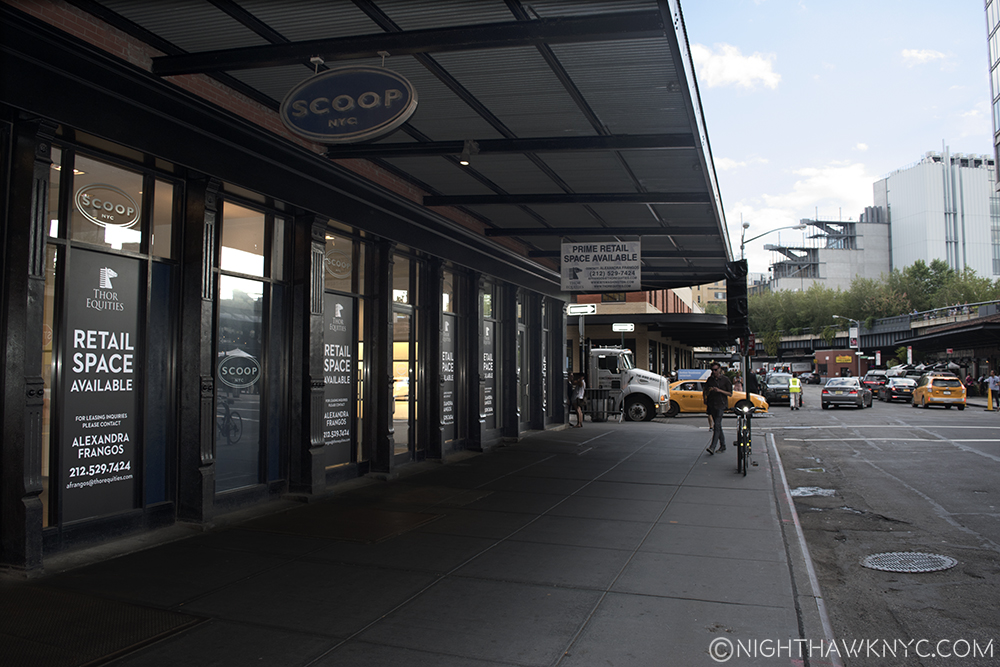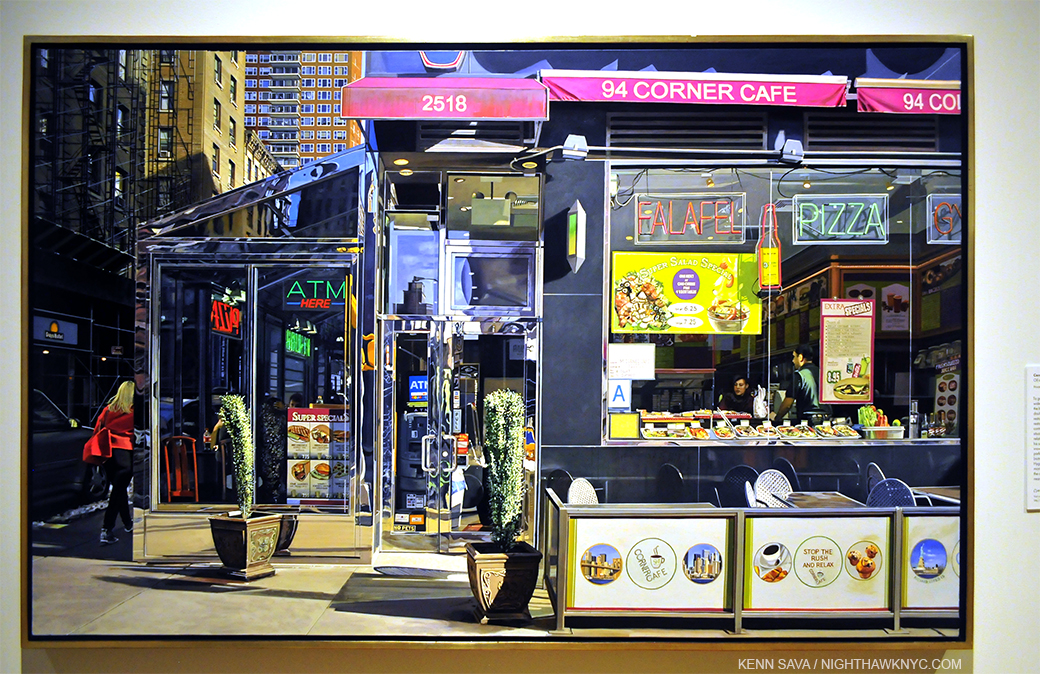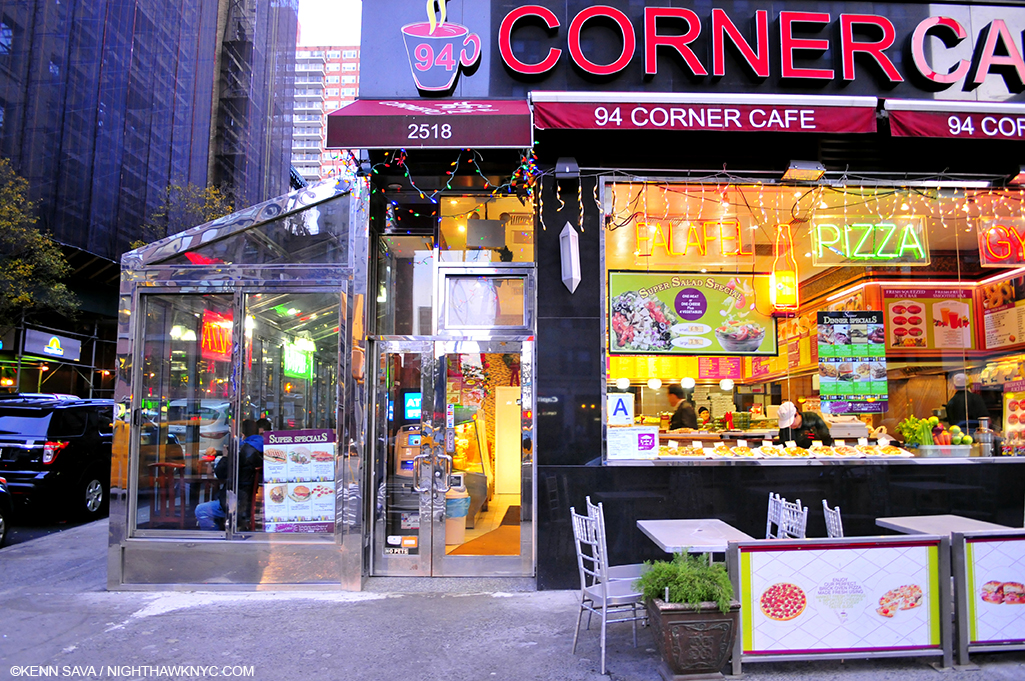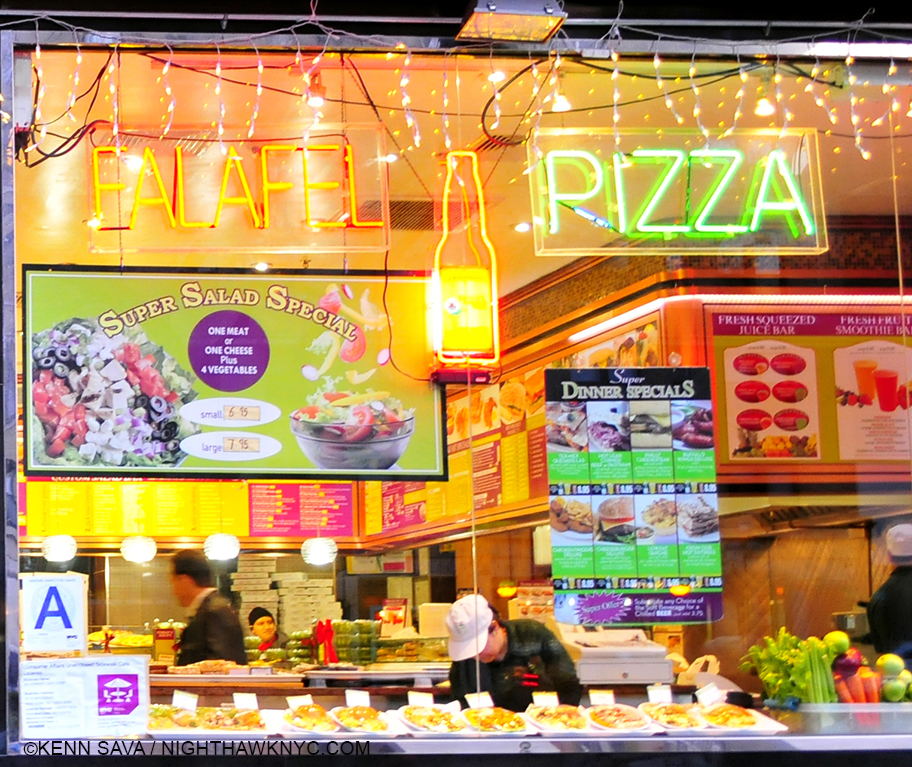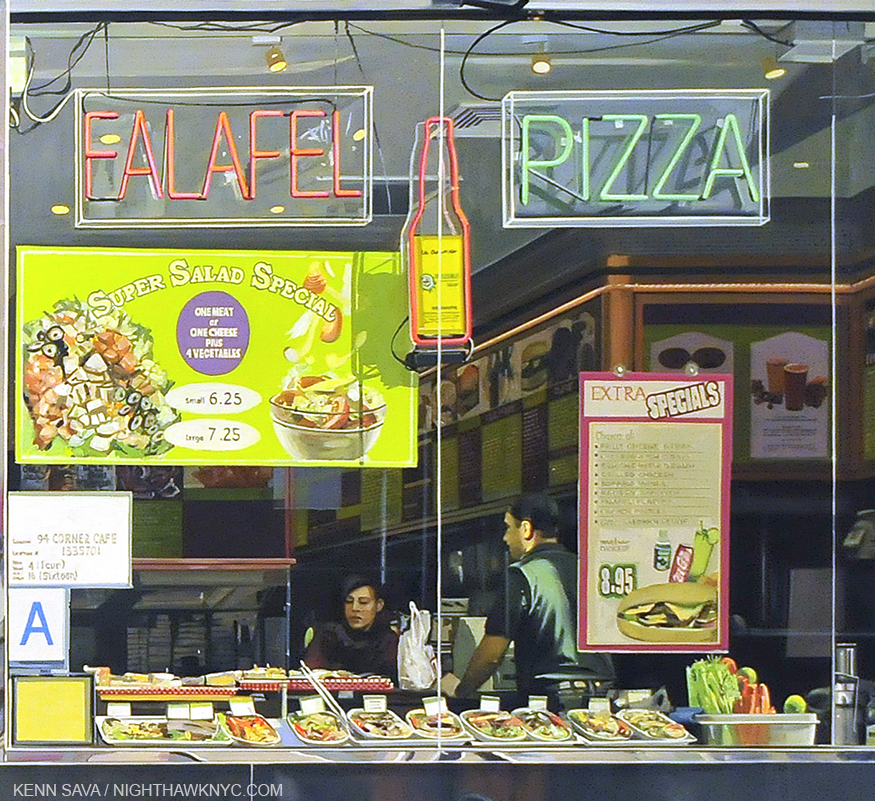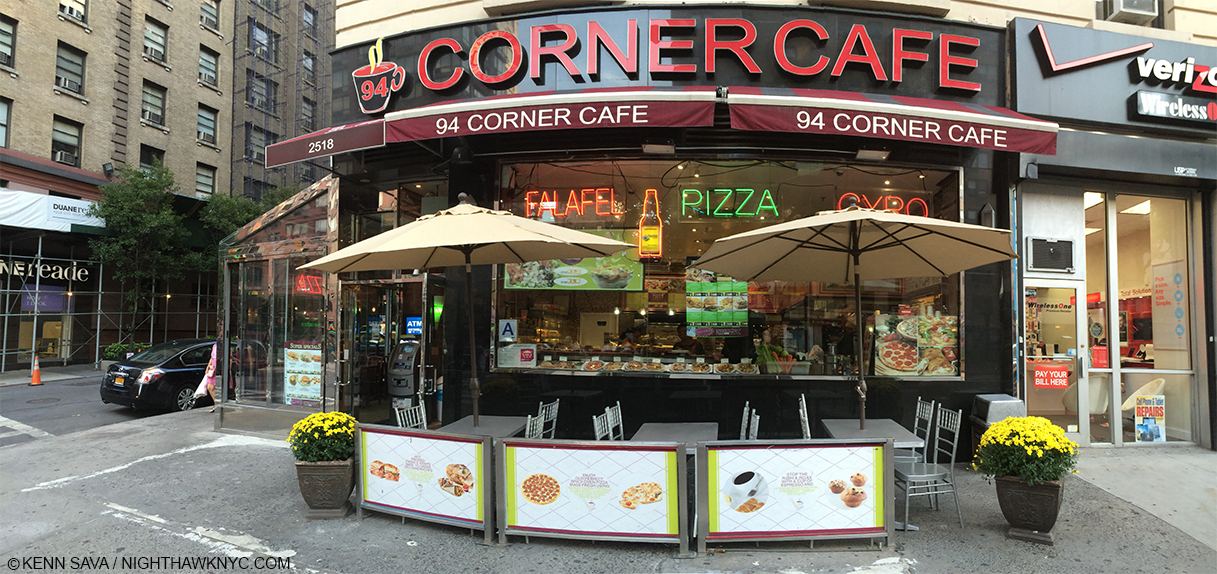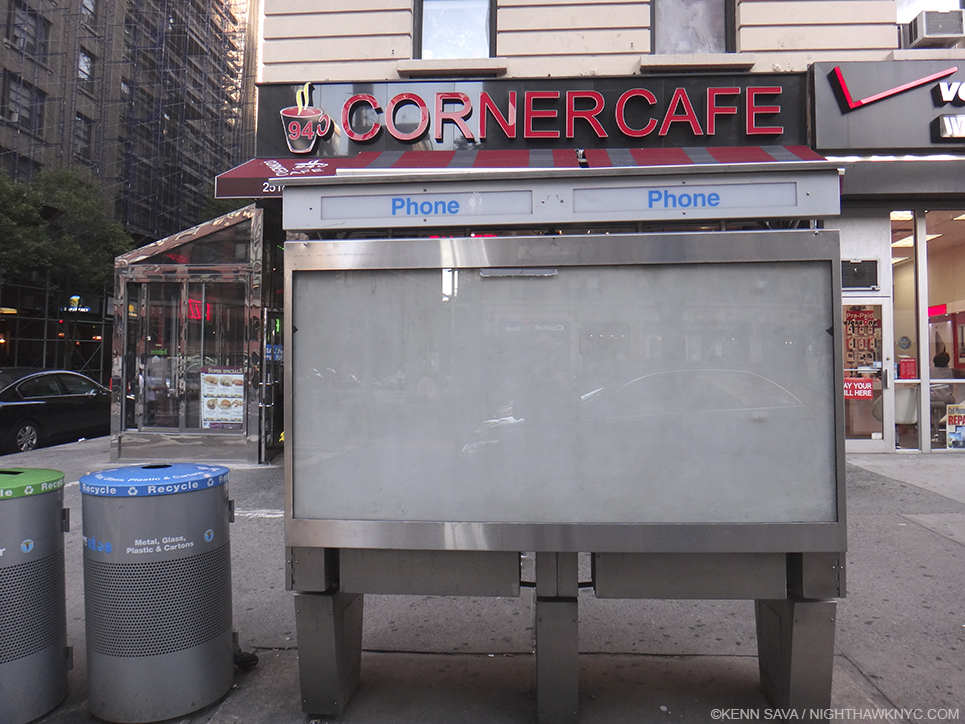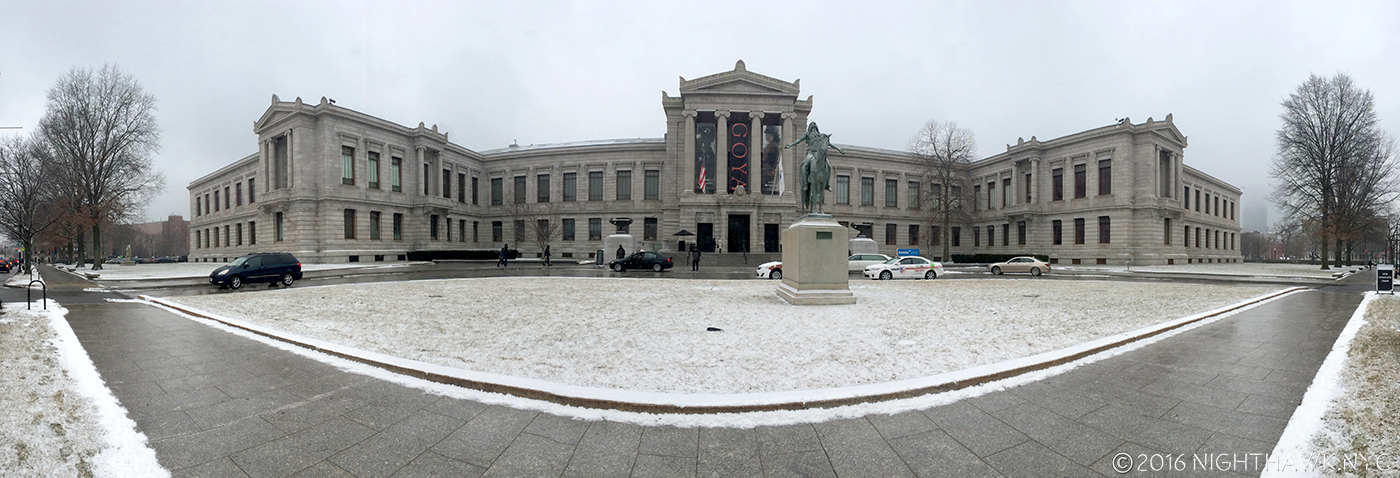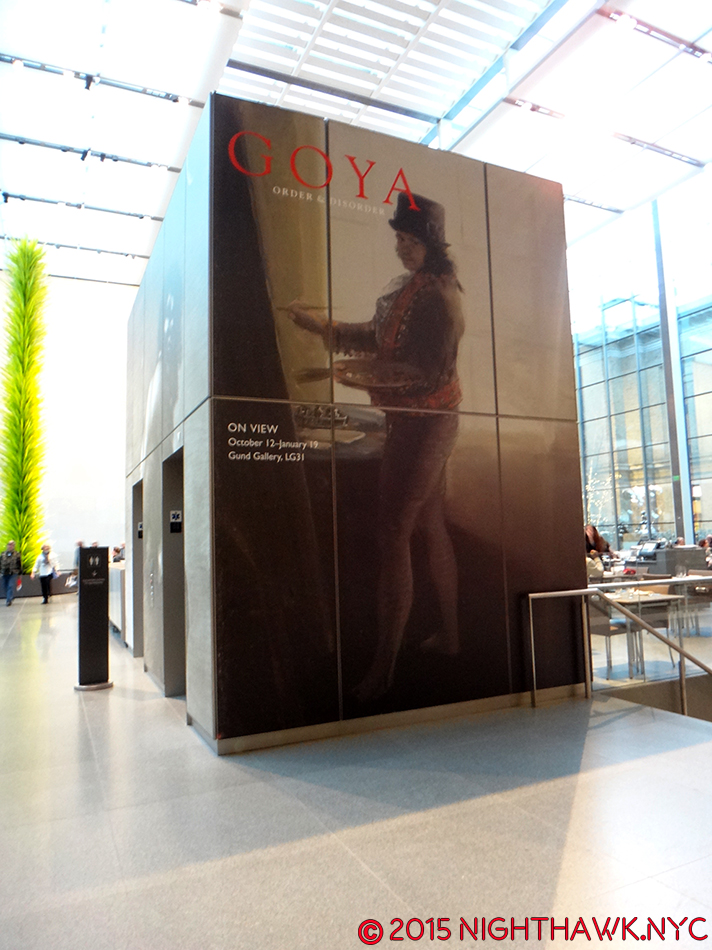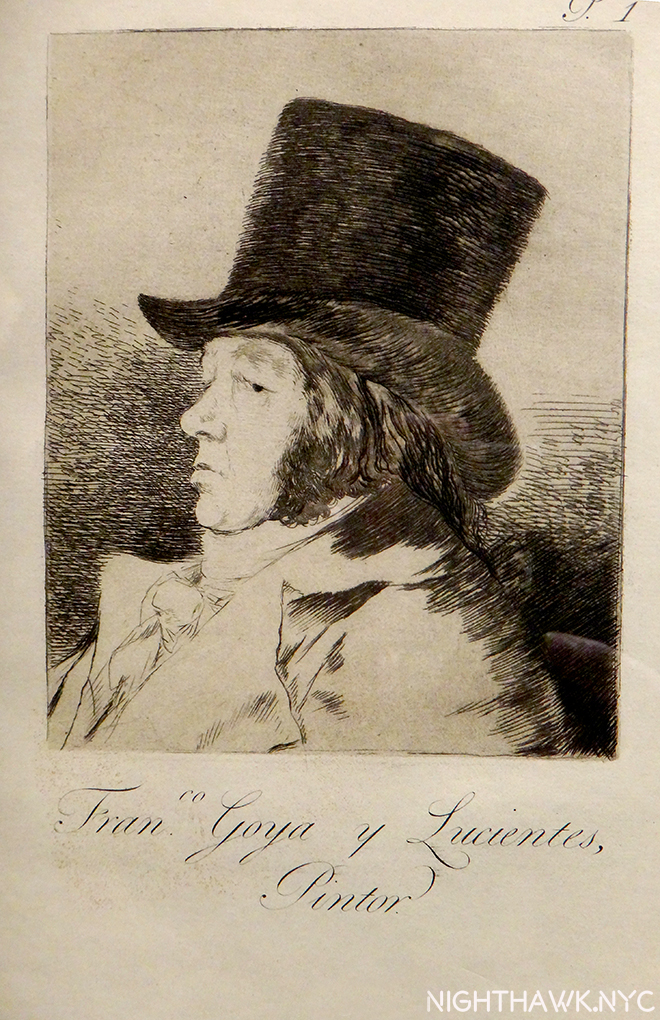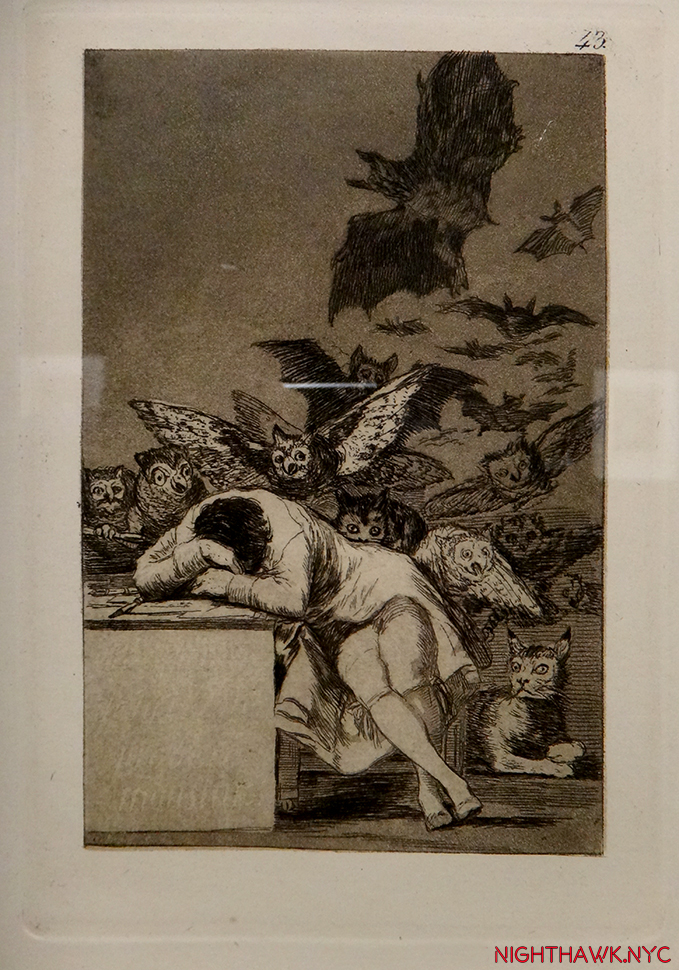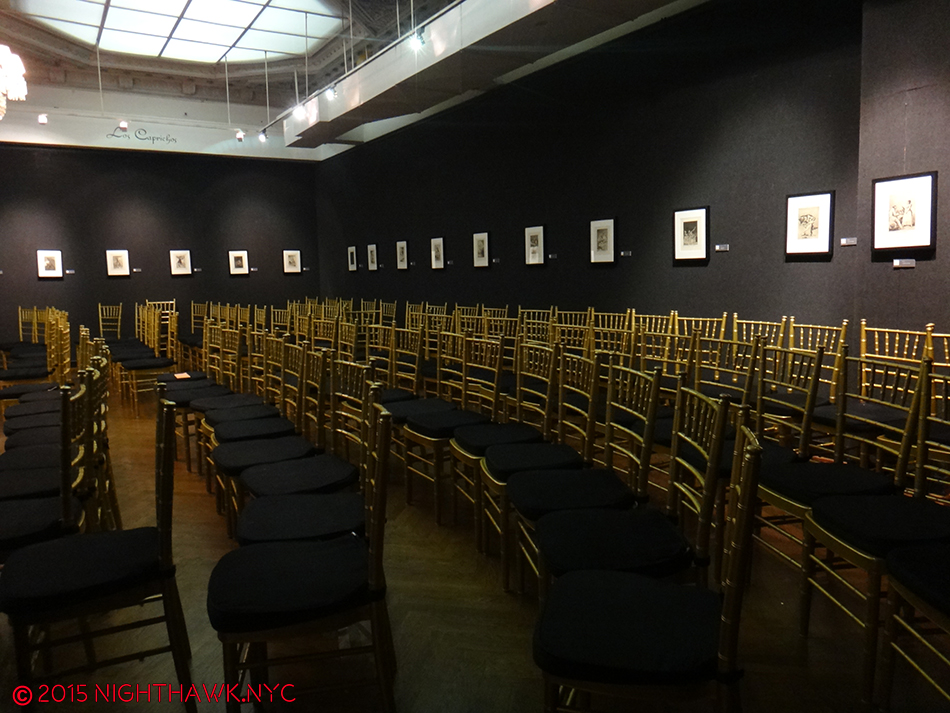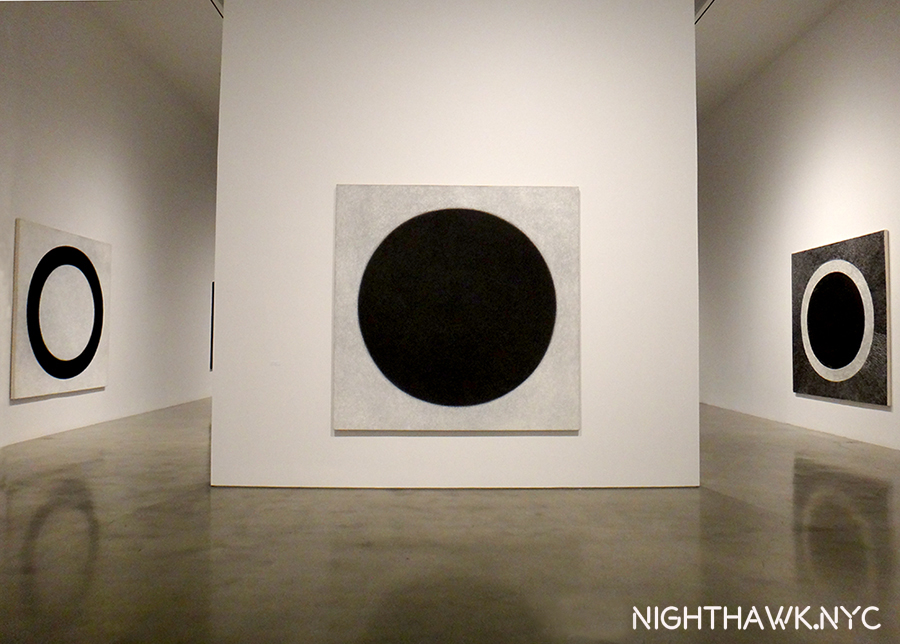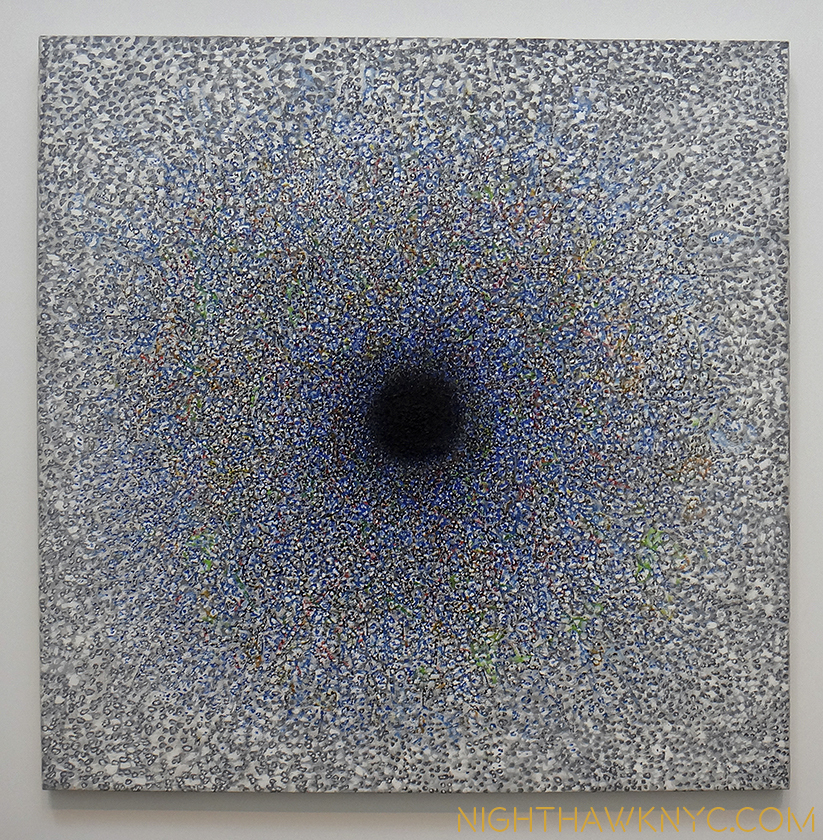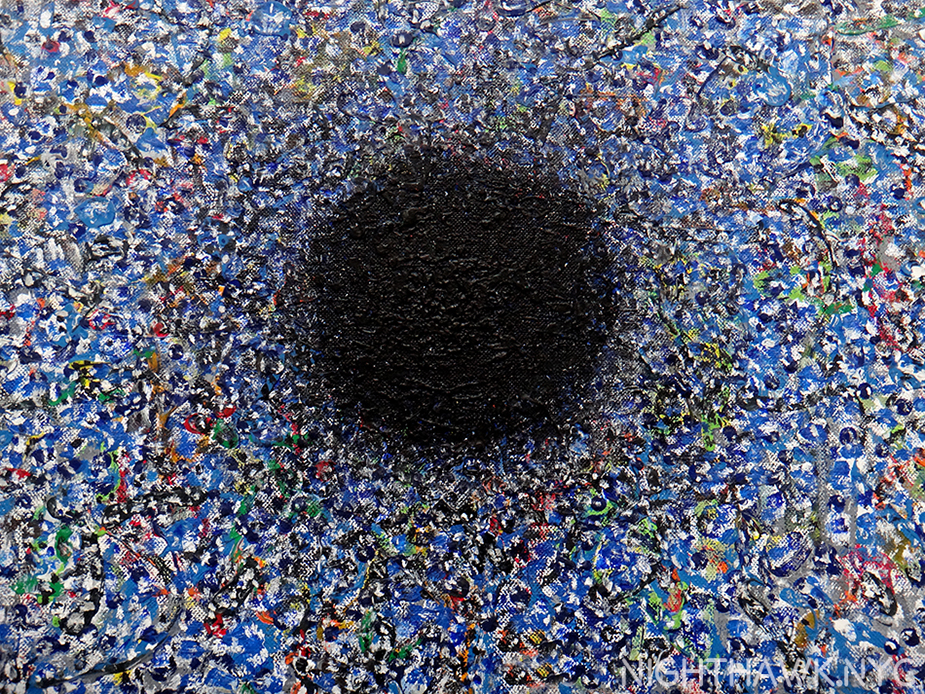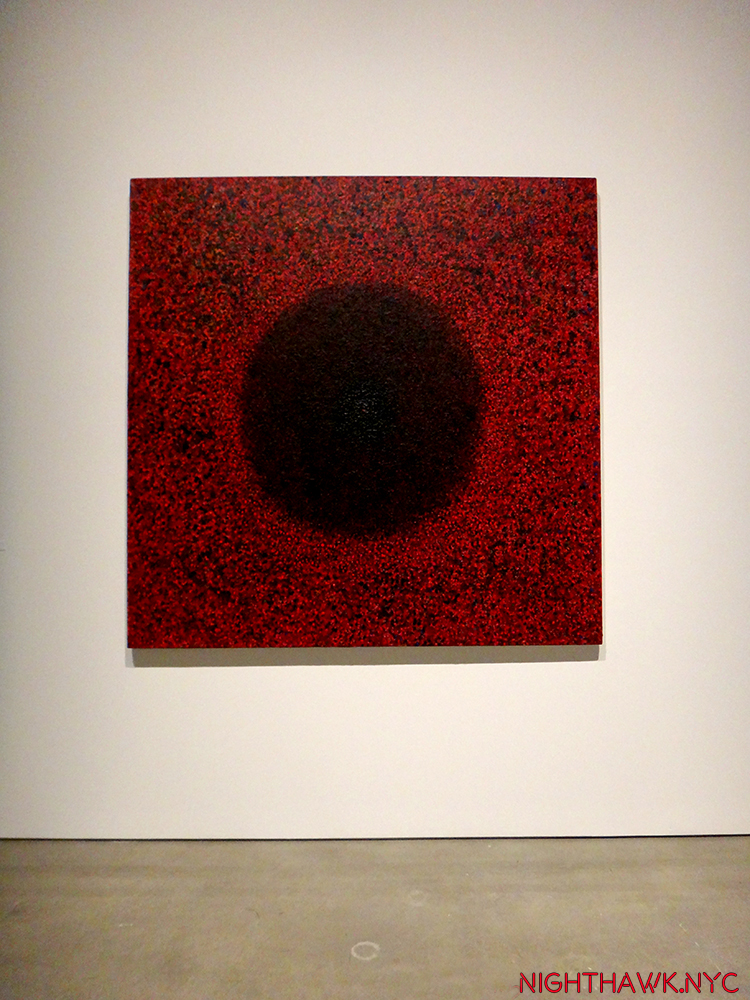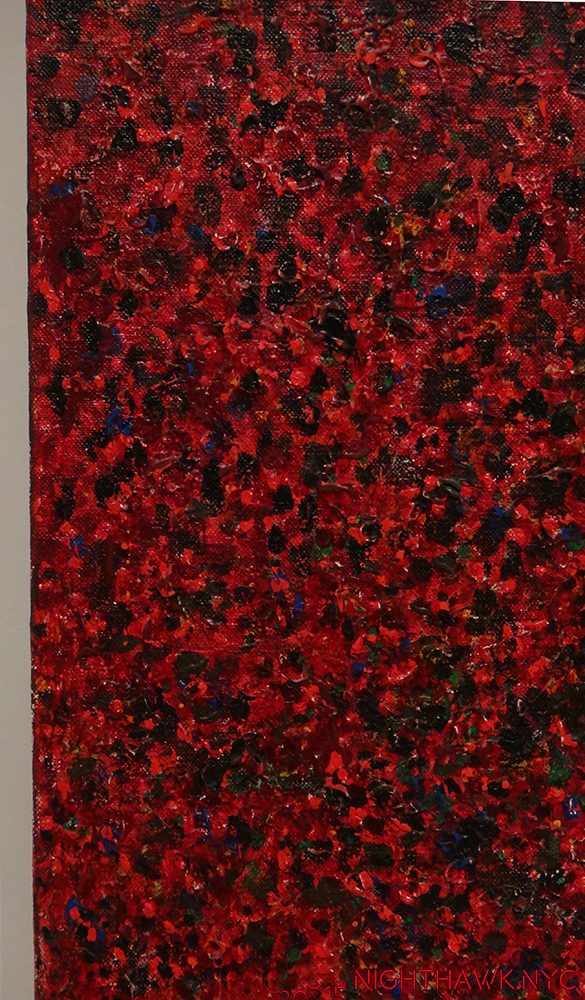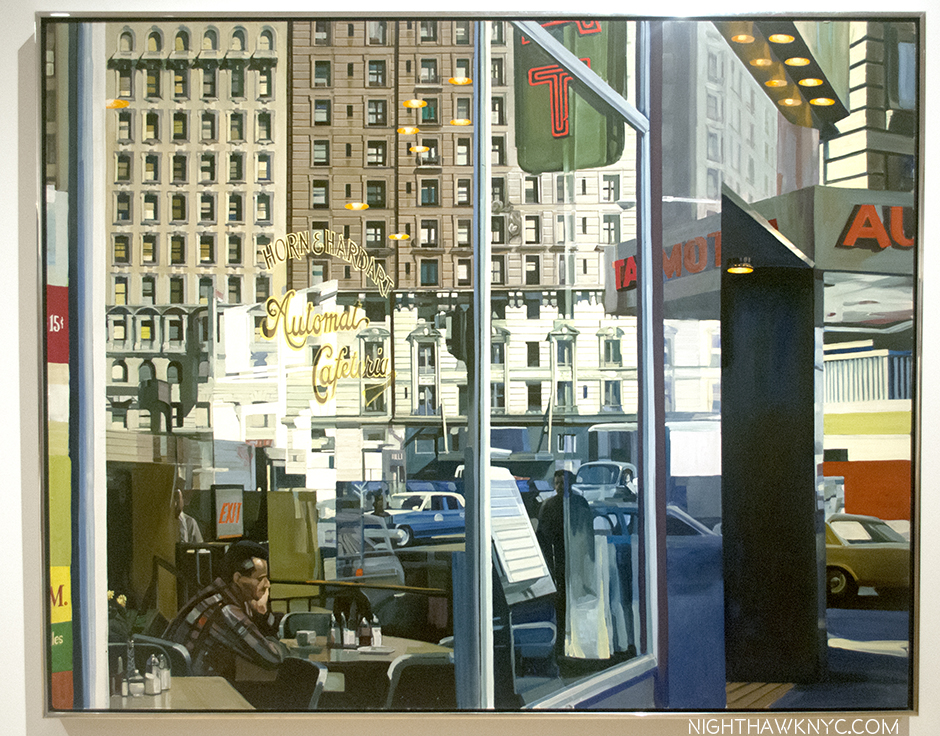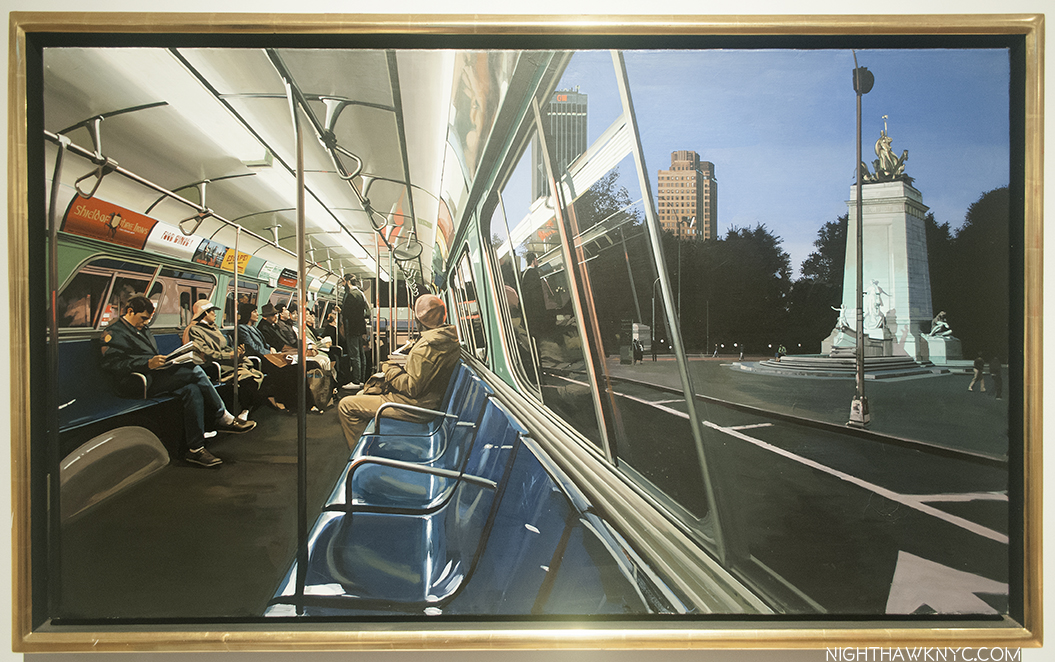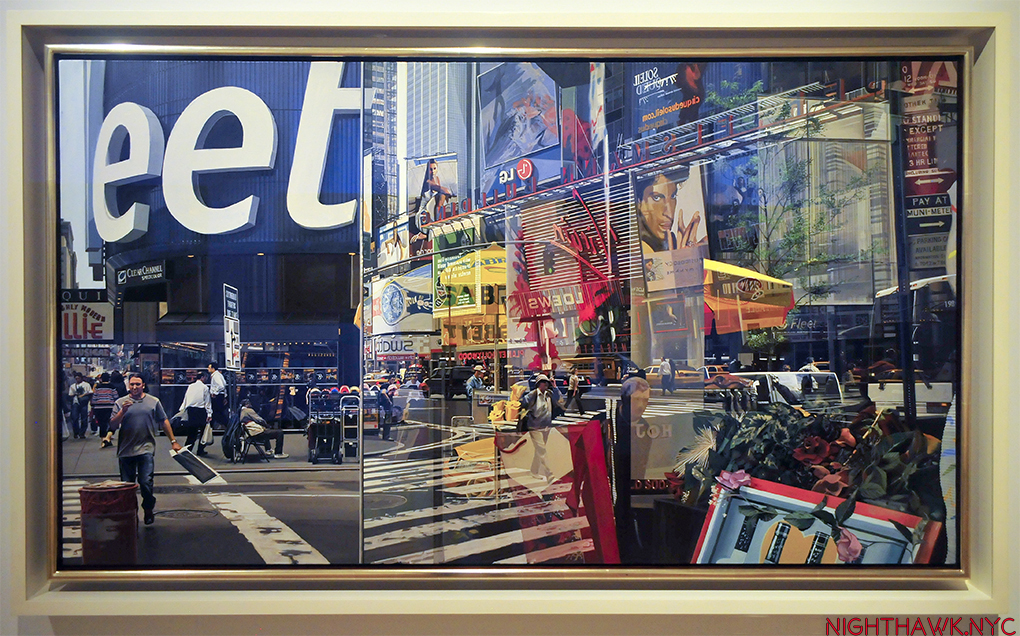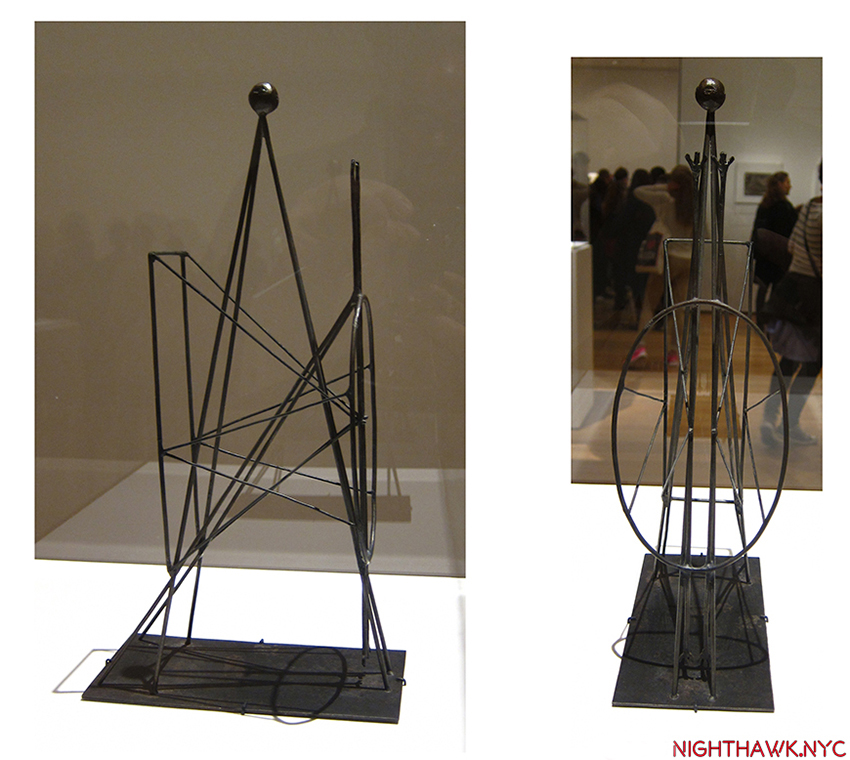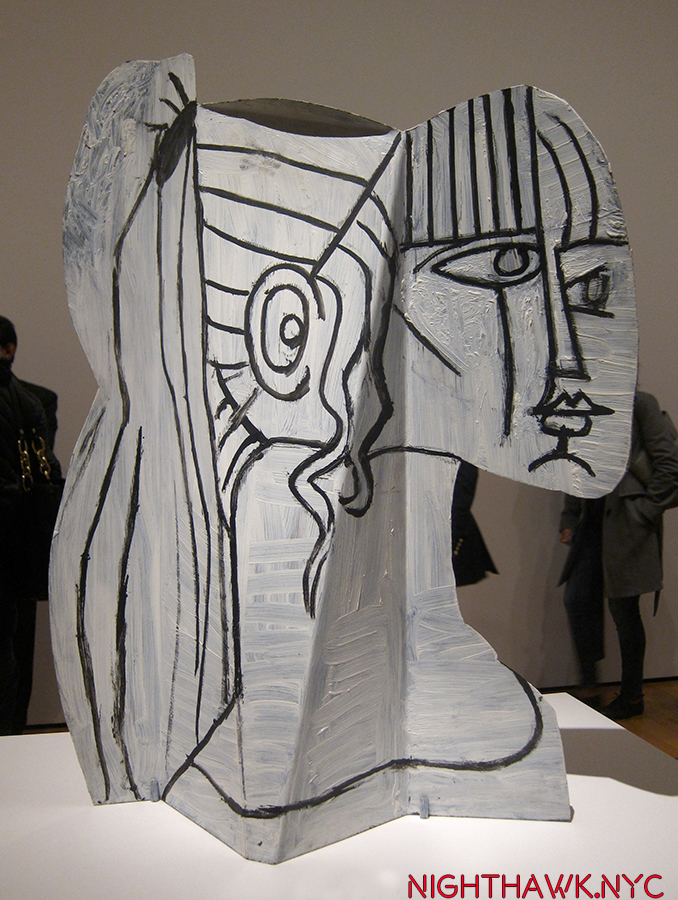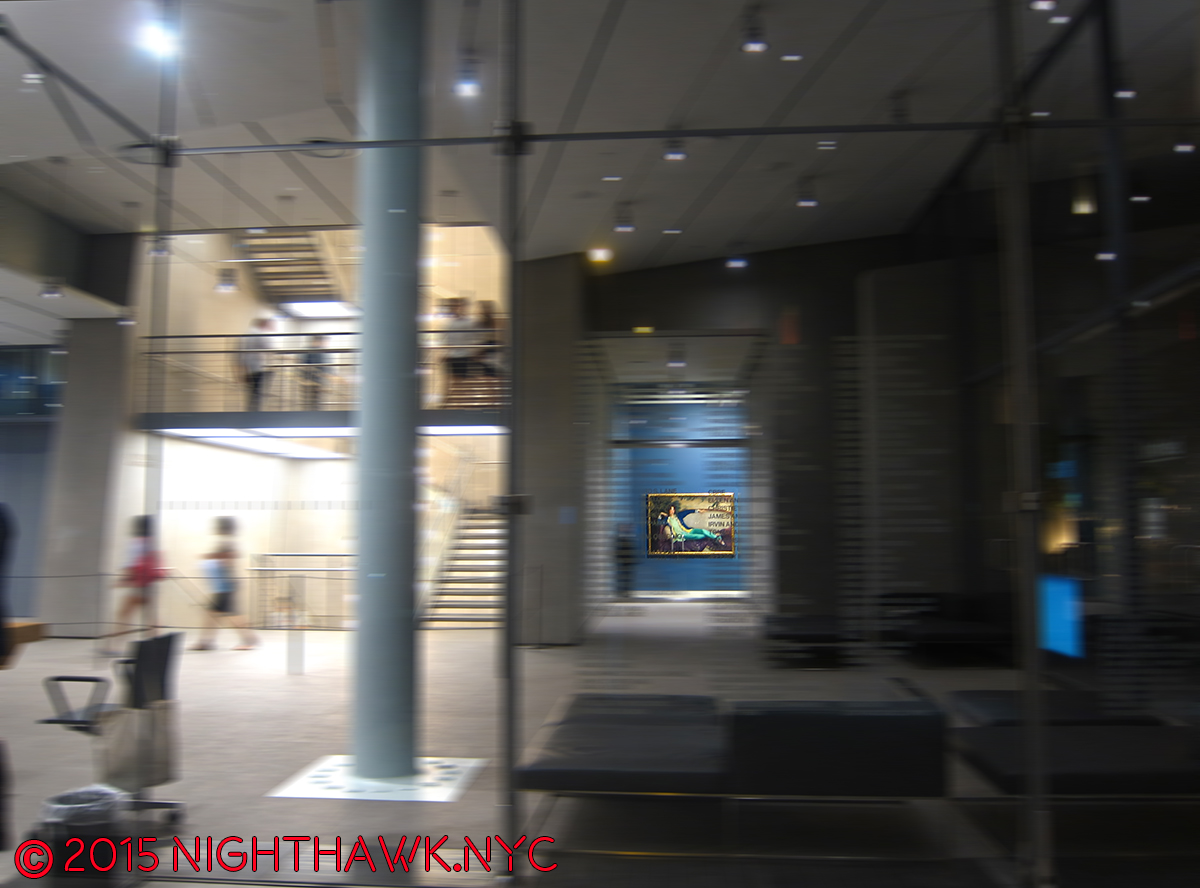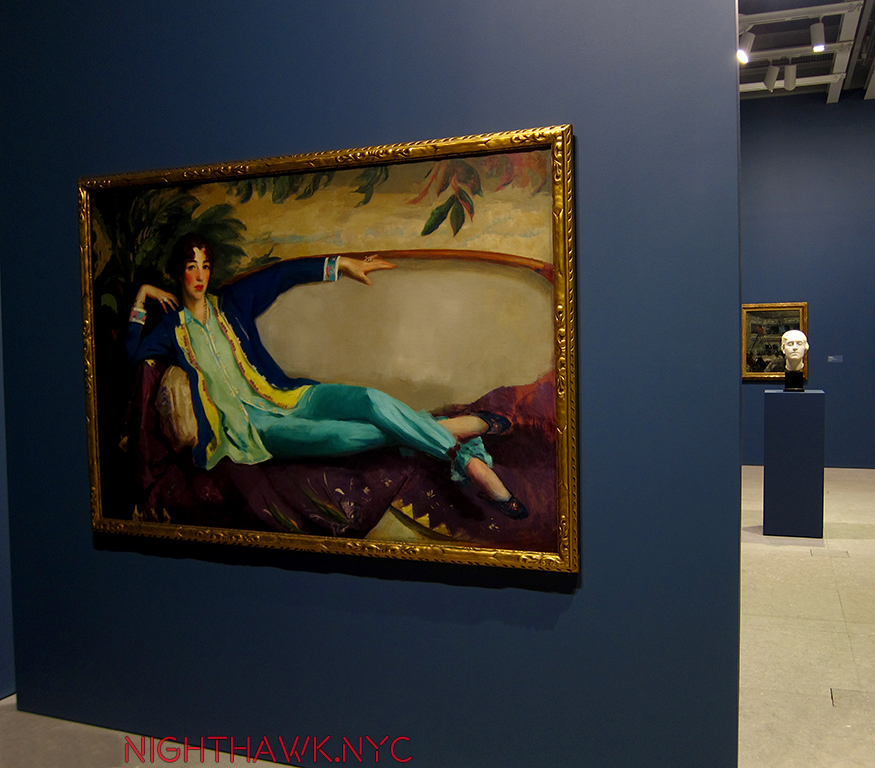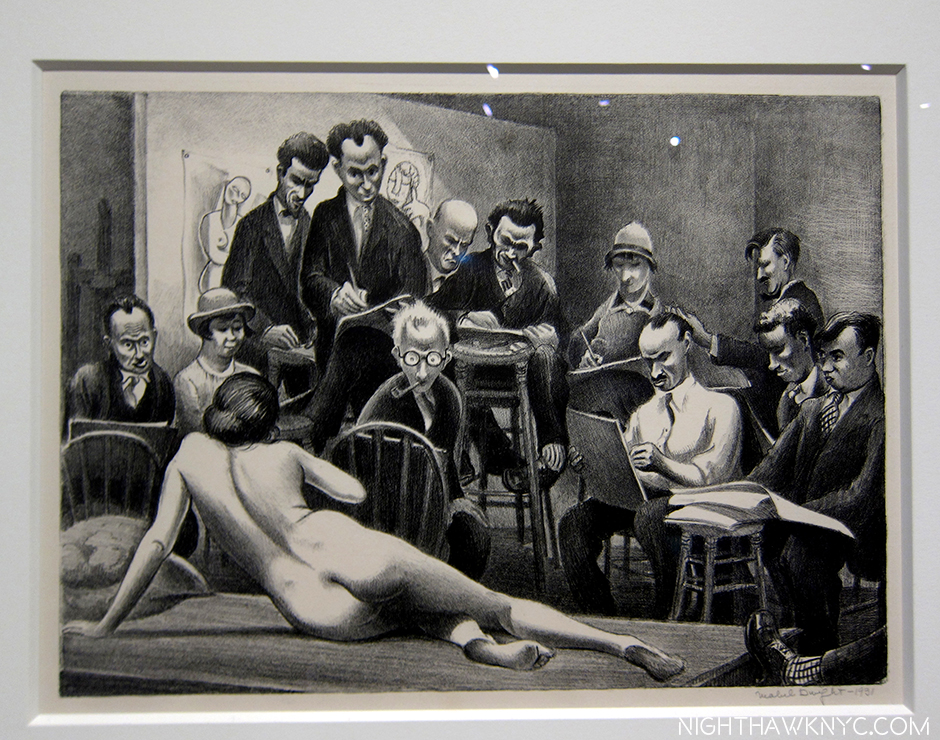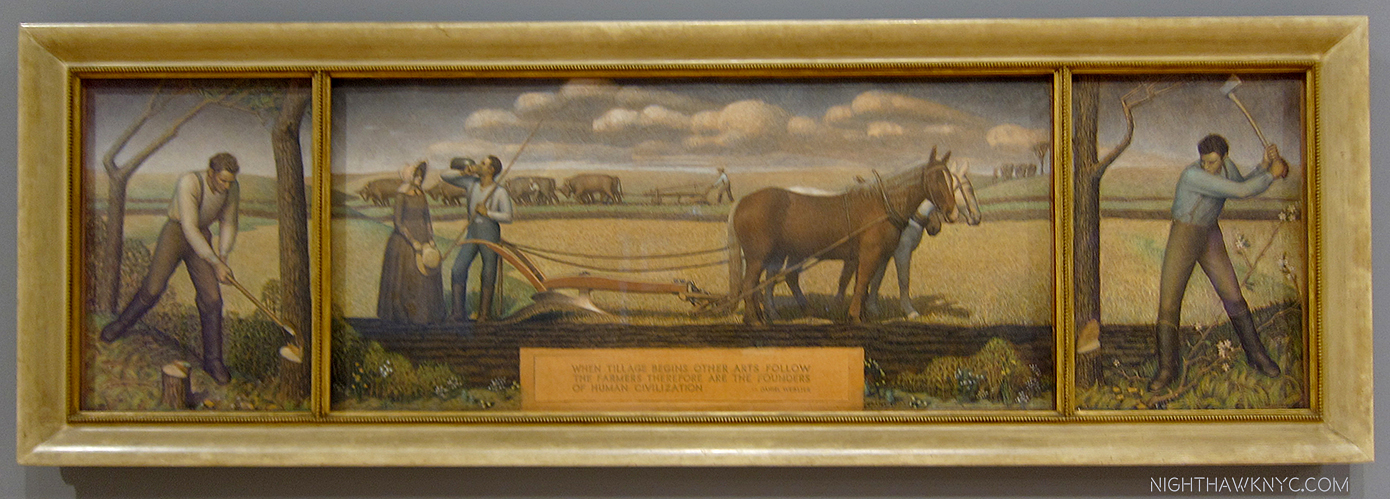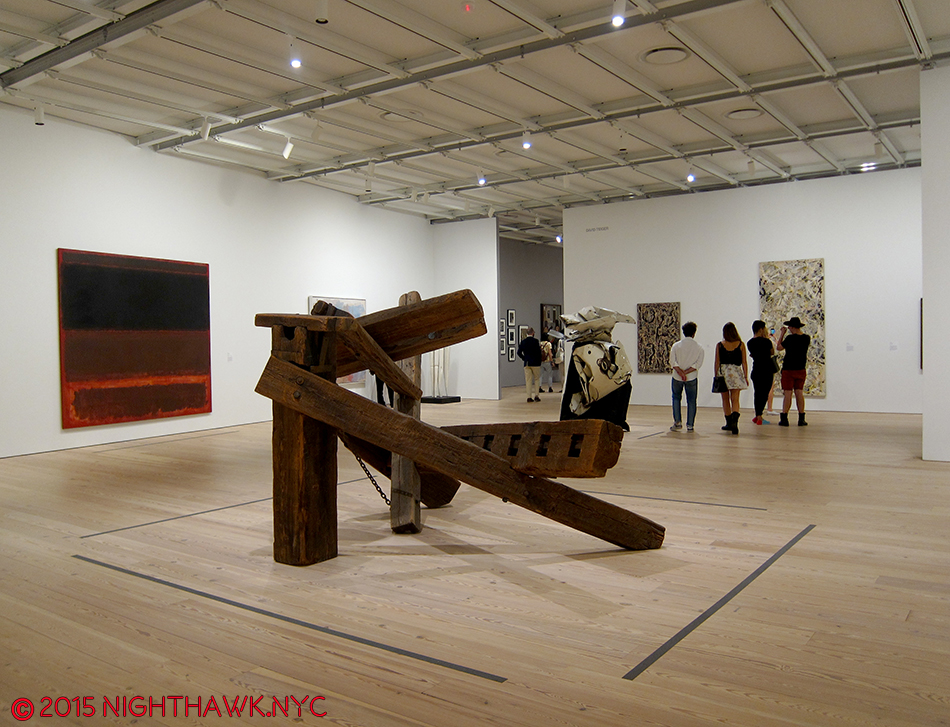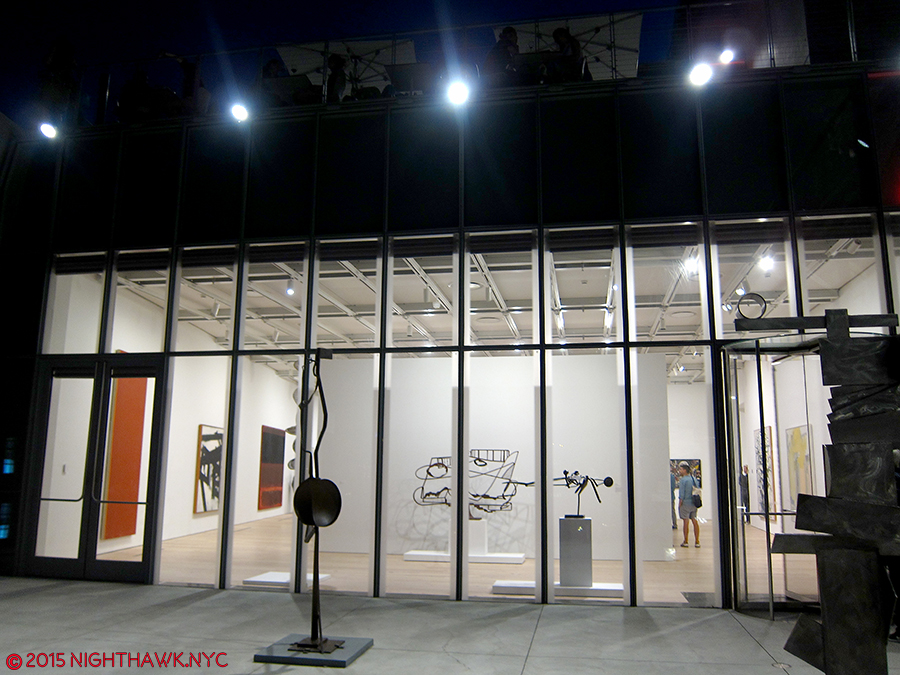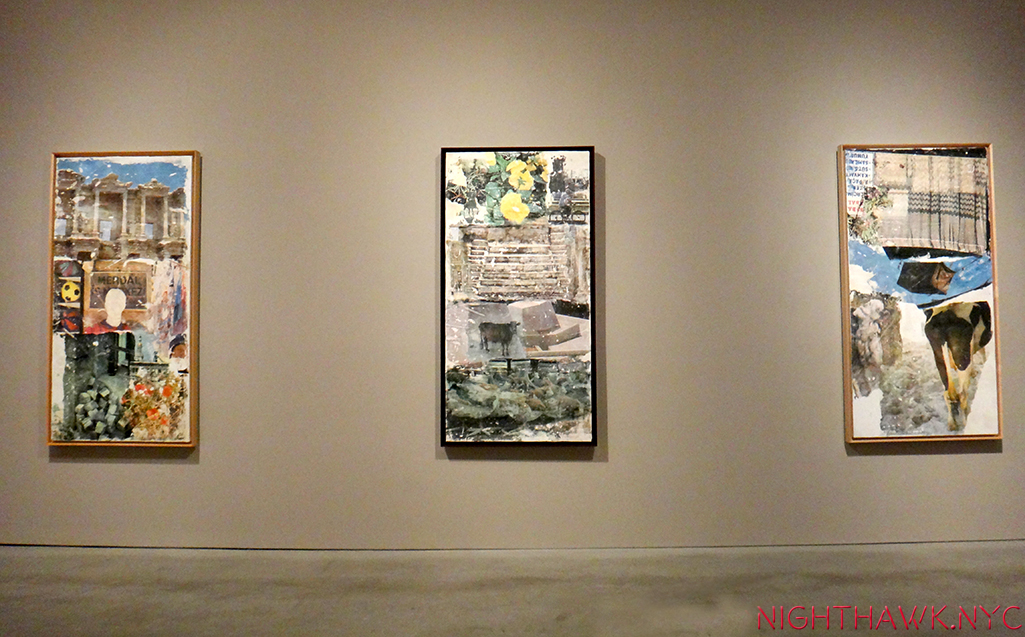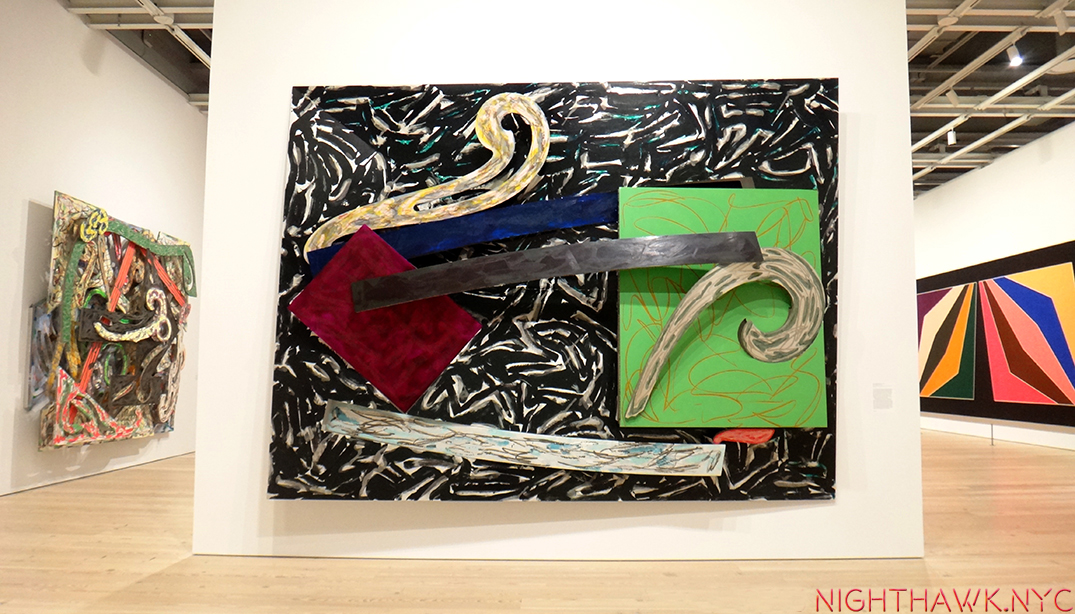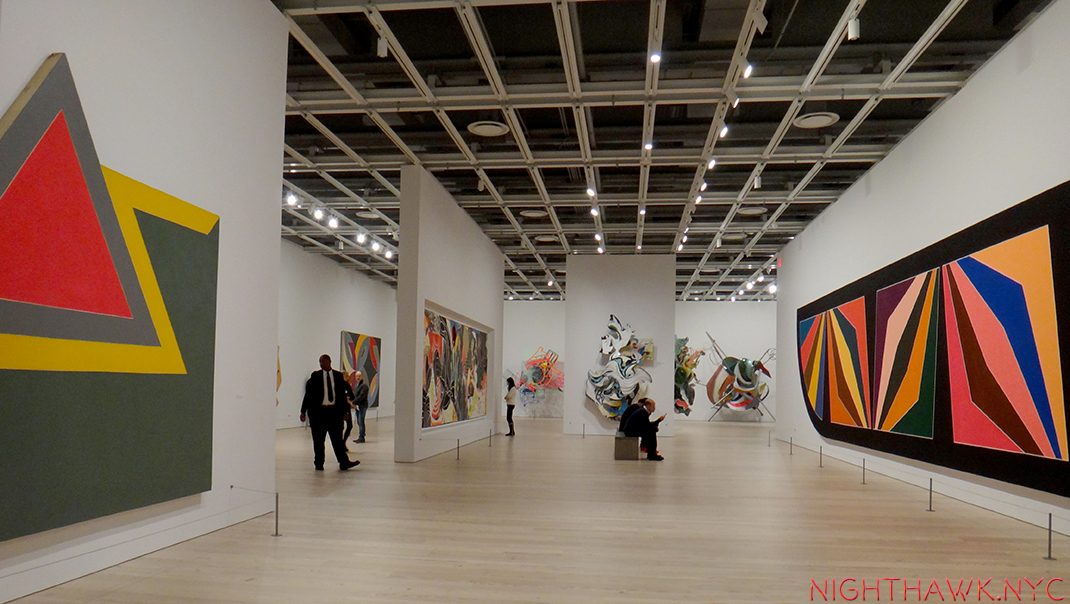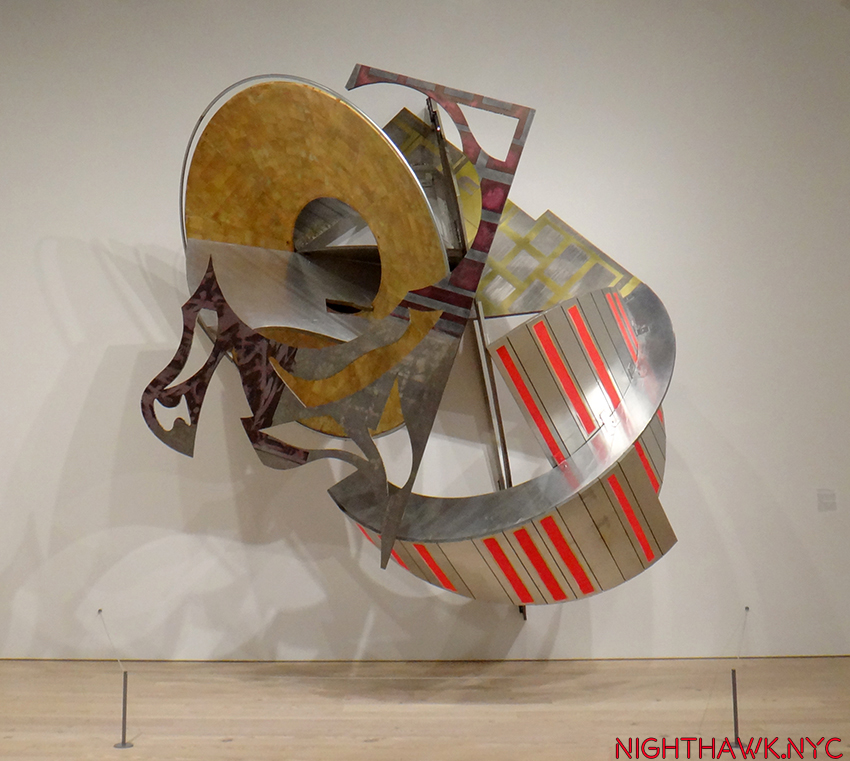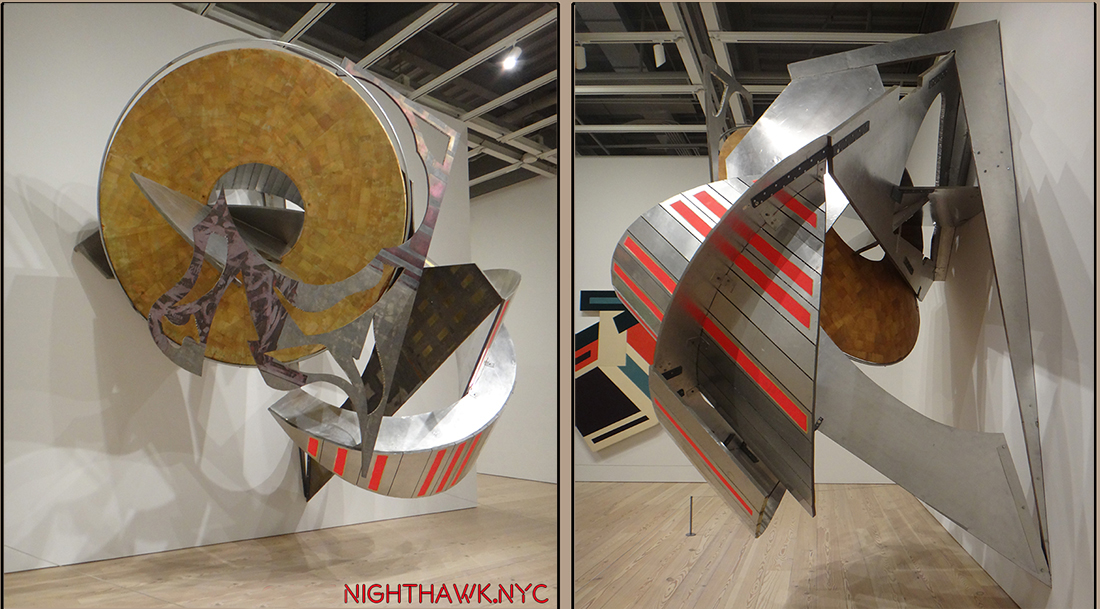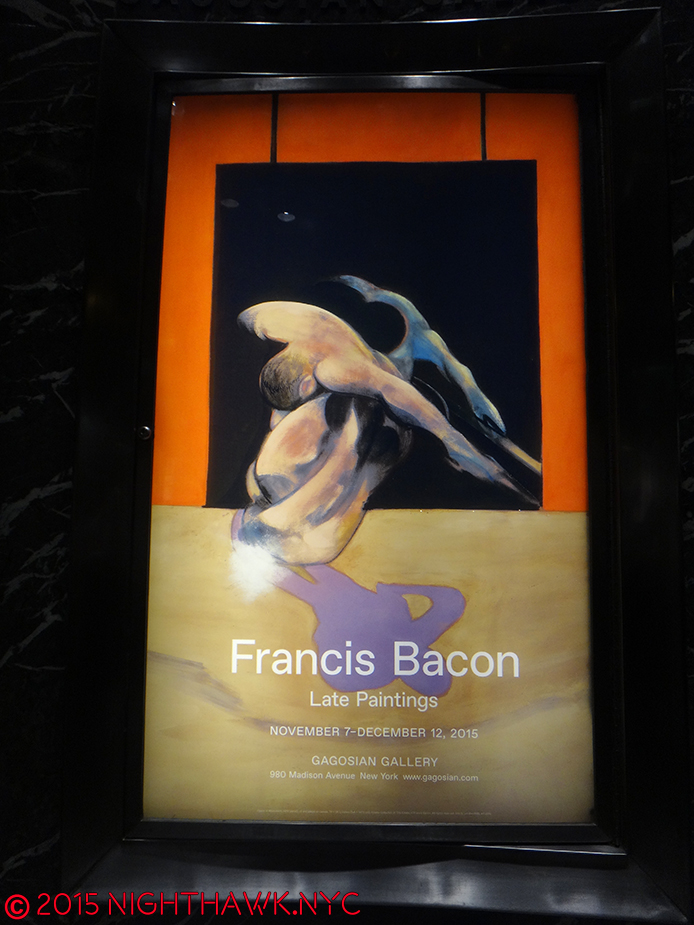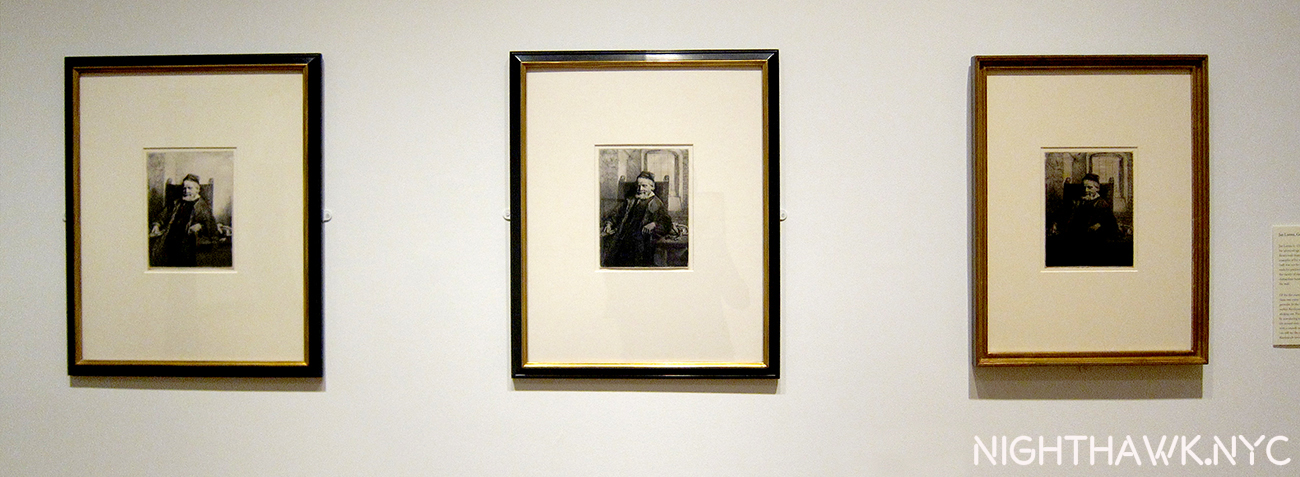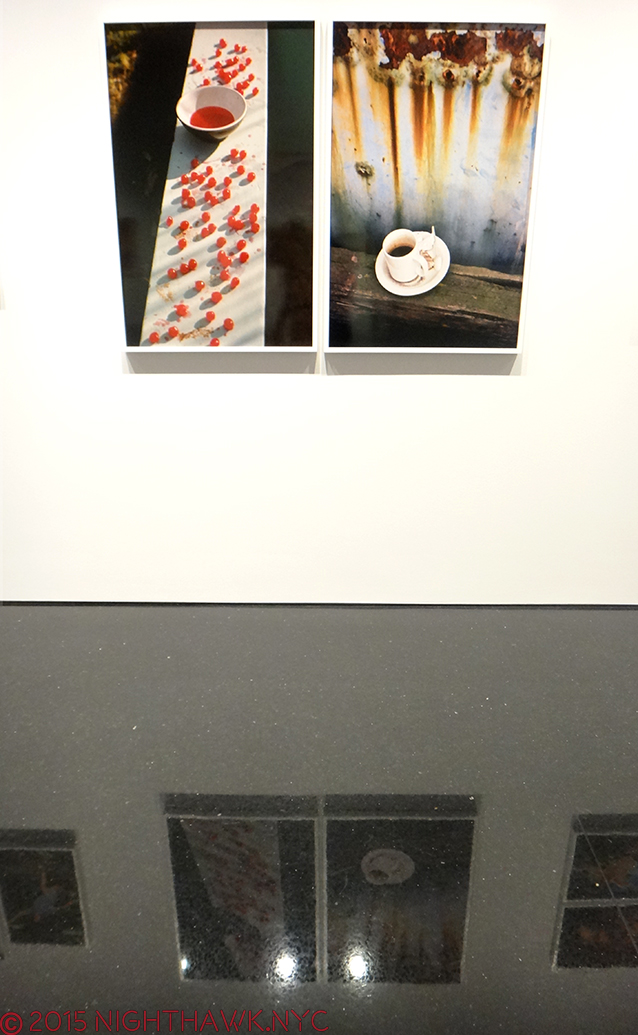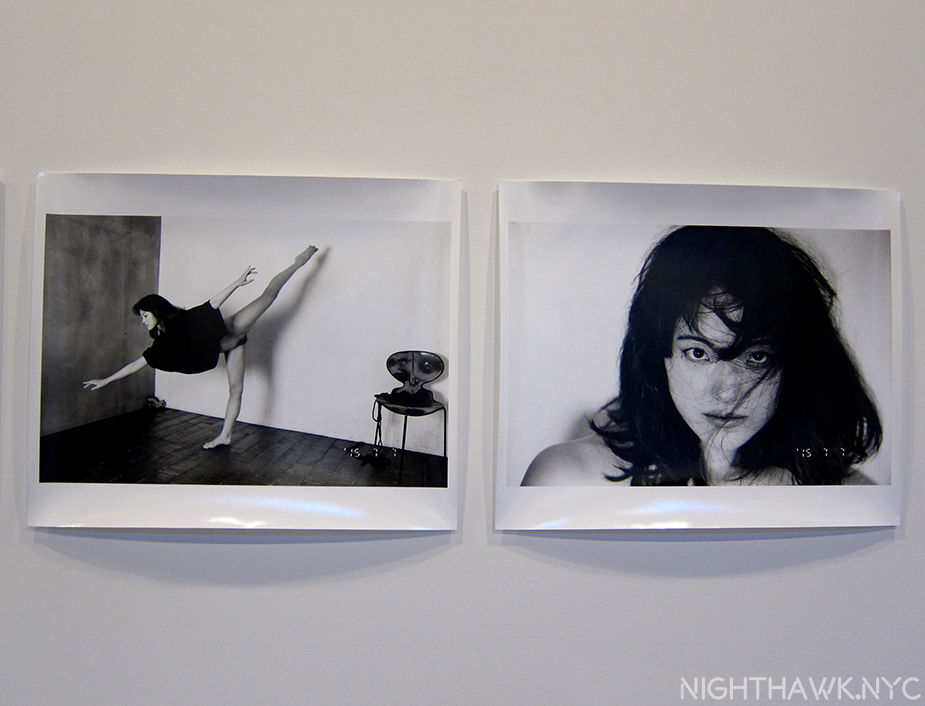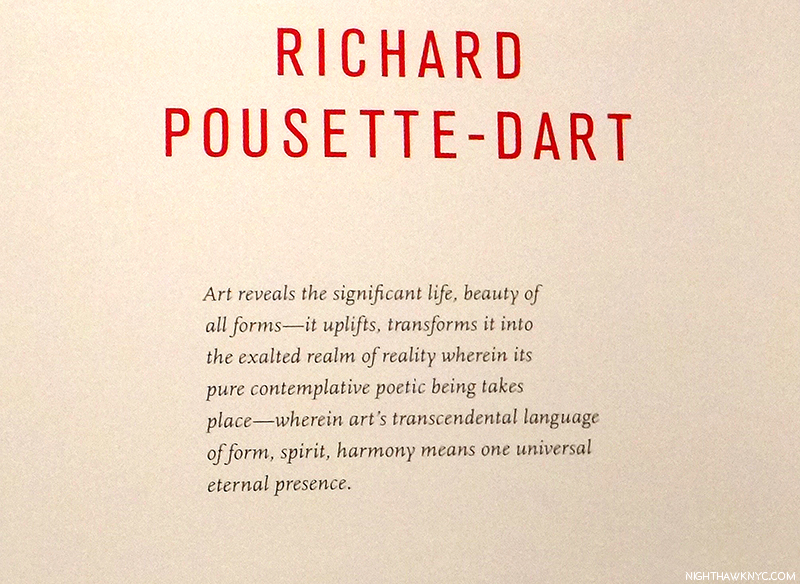This is the third, and final, part of my series on the “Summer of Rauschenberg”- 5 shows related to Robert Rauschenberg from May though September 30.
Written & Photographed by Kenn Sava (*unless otherwise credited)
Being New York, of course 250 pieces by Robert Rauschenberg on view at MoMA’s “Among Friends” (which I wrote about in Part 1 and Part 2) wasn’t going to be enough for many. Guilty. To the rescue came 4 satellite shows that provided a chance to see more, and even explore lesser known genres of the Artist’s prolific output. With “Among Friends,” they combined to create a fuller, if still not complete, picture of Rauschenberg’s accomplishment. The shows were (in no particular order)-
–Robert Rauschenberg: Rookery Mounds, and Selected Series from the 60s & 70s, at Gemini G.E.L. at Joni Moisant Weyl Gallery,
–Robert Rauschenberg: Early Networks at Alden Projects,
–Robert Rauschenberg: Outside the Box, at Jim Kempner Fine Art, and
–Susan Weil: Now and Then at Sundaram Tagore Gallery (Susan Weill was Rauschenberg’s first collaborator, and later his wife & mother of their son, Christopher. Divorced a few years later, she has continued her Art career to this day.)
Among these, too, highlights were plentiful. At Chelsea’s Gemini G.E.L. at Joni Moisant Weyl, it was more like a revelation.
As I’ve said in Part 1, I’ve been obsessed with Rauschenberg’s Photography, and was a bit disappointed it wasn’t given a more thorough assessment at Moma’s Among Friends, and so I continued to explore it’s progression as part of his work in the other shows. Rookery Mounds, a series from 1979, turned out to be as close as I got to a breakthrough.
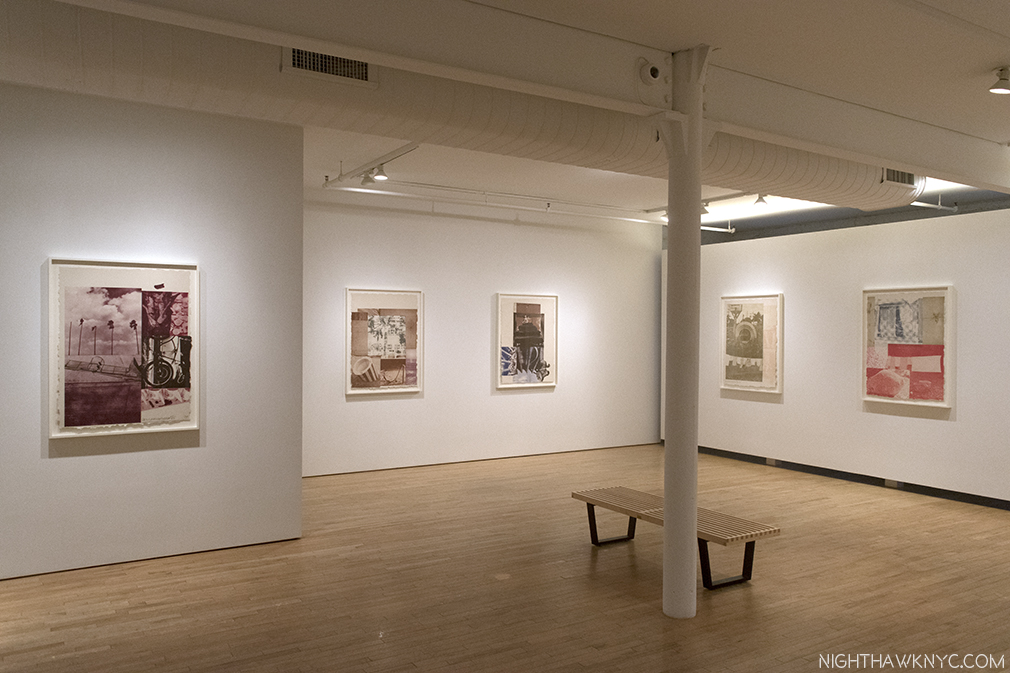
5 of the 11 lithographs comprising Rauschenberg’s Rookery Mounds series, 1979. This was the first time the complete set has been on view since their debut at Leo Castelli Gallery in 1979
Rauschenberg finally started using his own Photographs, exclusively, in his collaboration with Trisha Brown, Glacial Decoy, 1979, (which was on view at MoMA’s Among Friends, as I mentioned, and showed in Part 1 of this series. In that work, 620 Rauschenberg Photographs were displayed by themselves as the background for the dancers in a constantly changing series of 4 Photos). He subsequently used Photographs from the body of them he created for Glacial Decoy in the series Glacial Decoy Series Etchings and Glacial Decoy Series Lithographs. He also used them in the series Rookery Mounds, 1979, a gorgeous and very important series of 11 prints. These 3 series have a completely different look and feel, to me, from all that has come before. The Photos are shown pretty much on their own in groups, with minimal layering, and, apparently, no surface scraping, washes or other modifications, (besides tinting), and no painting over. They beg the question- “WHY didn’t he do this before?” It took a lawsuit for “borrowing” a Photograph by someone else, without permission, to get Rauschenberg, one of the most under-rated Photographers I can think of, to FINALLY feature his own Photographs in his work.
Hallejulah!
In Rookery Mounds, they are displayed in the most wonderful combination of wildly disparate images, that somehow…magically work together.
After looking at so much of his earlier work, the difference is immediately apparent, and startling. In these three series there is a new “clarity” that is different from most of what’s come before, and strikes me as (the beginning of) a new plateau where his Photographs, in higher resolution than ever, allow him unprecedented image clarity, when he wants it (as here, and in the Scenarios, 2002-06, and Runts, 2007, series, at the end of his career), and, with layering, painting, and other modifications in the Anagrams, 1995-97, Anagrams (A Pun), 1997, and Arcadian Retreats, 1996, series, which I wrote about in 2015. Other series, like the Waterworks, 1992-95, straddle the line between modified/unmodified images. After watching his use of images progress from his Black Mountain Photographs in the late 1940’s, to the Blueprints and the mid-1950’s Combines and Combine Paintings, to the Dante Illustration transfer drawings through the Silkscreen Paintings, it feels like he finally found what he had been seeking all along. Am I saying these are “better” than works containing the Photos of others? No. I don’t believe in those kinds of comparisons. I’m saying that it feels the Glacial Decoy graphic works represent a new style of presentation in his work that is different from what came before, which usually used (more) layering, and I find it to be equally as valid, and to my eyes, perhaps even more beautiful. Those who feel that Rauschenberg ran out of ideas at some point may want to take a look at these.
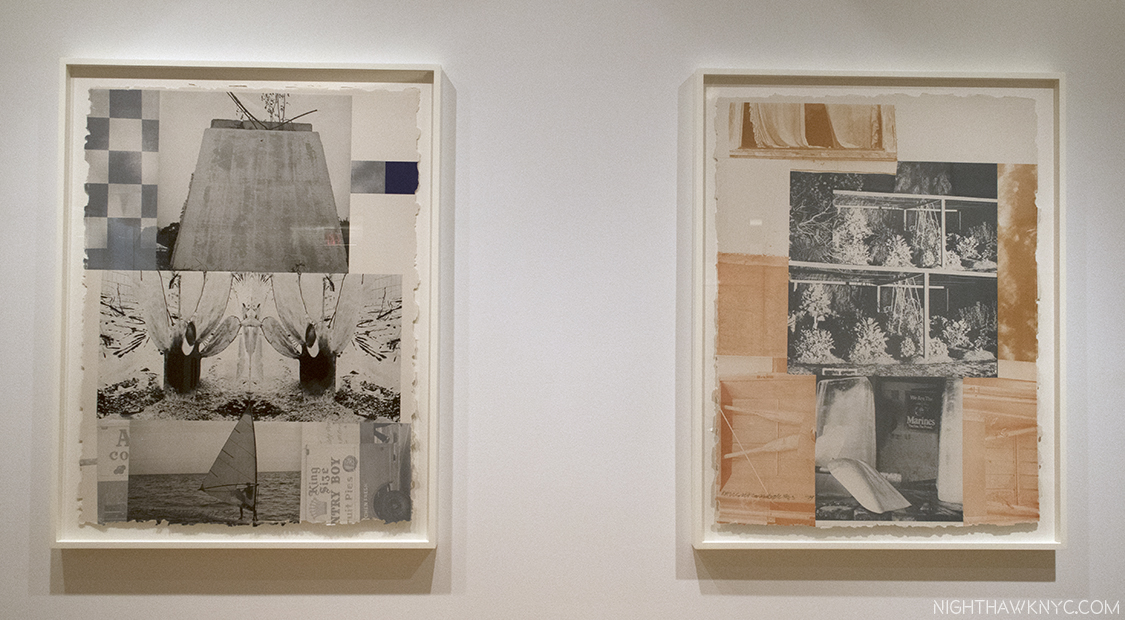
“Rookery Mounds-Crystal, left and Rookery Mounds-Masthead, right. Both, 1979, Lithographs from Rookery Mounds.
Given recent events, one of them, Level, shown above, struck me as ironically prescient…38 years later.
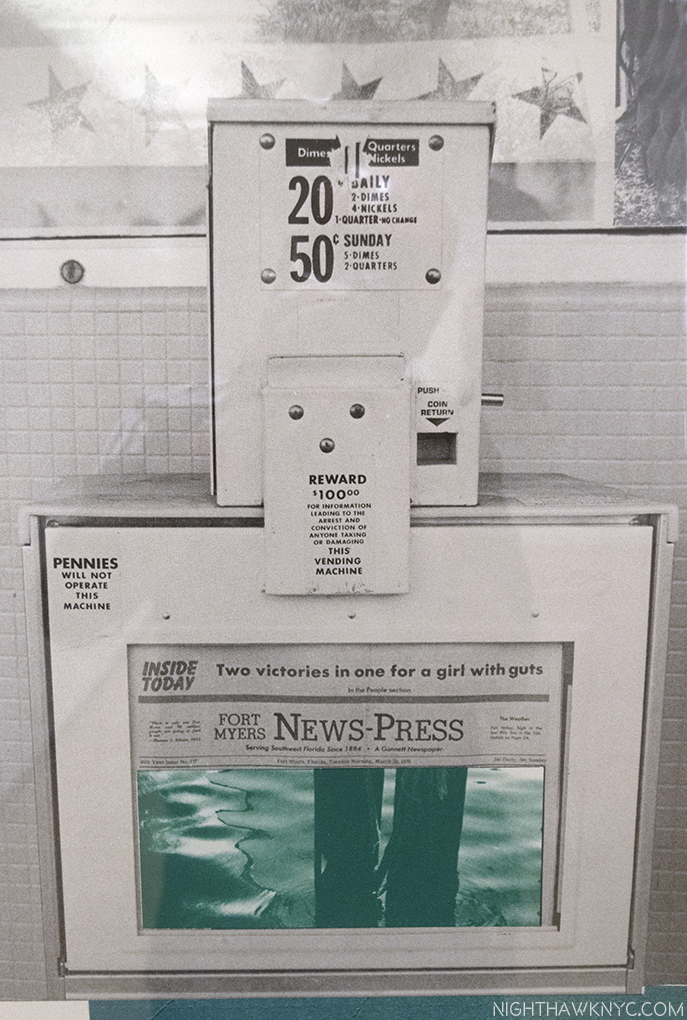
This could have been a real front page a few weeks ago. Detail of Level. It’s ironic that Rauschenberg put this image of water engulfing wood poles on the cover of the Fort Meyers News-Press, as Hurricane Irma, unfortunately, put much of the area under water. Rauschenberg’s studio & home complex on nearby Captiva Island, managed to escape major damage, I’m told.
Why at least one of these weren’t at MoMA in Among Friends, is a question I can’t answer. For the rest of his career he would use his own Photographs, until a stroke denied him the use of his right (Photographing & Painting) arm in the early 2000’s, requiring him to have others take Photos for him. Rookery Mounds is a shining example of why I feel his later work, AND his Photography, are under-appreciated. Rauschenberg was not only the master of the found object in the 2nd half of the century, he was also a master of capturing what I call the “found moment” in his Photographs. Most importantly, the Glacial Decoy project rekindled Rauschenberg’s love of Photography. In the late 1940’s he had agonized about whether to be a Painter of a Photographer. He chose to be a Painter. Now? He’d never look back. His “found moments,” and “found objects” would be central to his work for the rest of his career.
Along with Rookery Mounds, two other rooms featured other works from the 60’s and 70’s, and the discoveries continued. These include a number of Rauschenberg’s work in corrugated cardboard in a series he called Cardbirds, 1971, along side a series of pieces that LOOK every bit like cardboard but are, in fact, made of clay- the Tampa Clay Pieces 1-4, 1972-3.
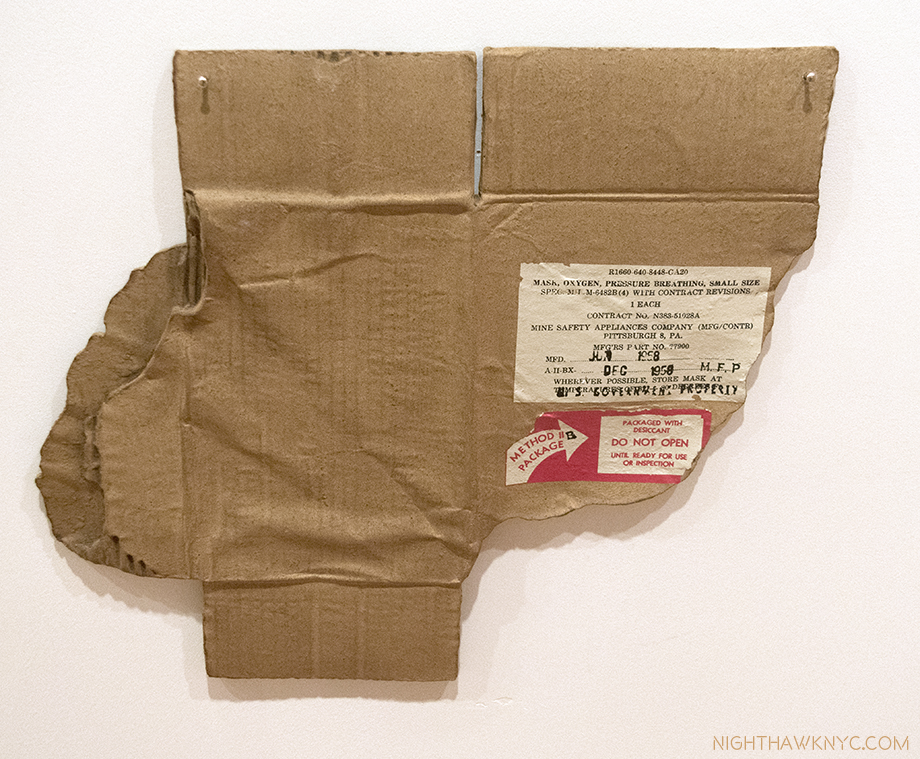
No, this is not made of cardboard . Tampa Clay Piece 1, 1972-3, Fired clay with screen printed decal and soil patina.
Then there was a set of lithographs- supplementary plates for the deluxe edition of the 34 Illustrations for Dante’s Inferno from 1964. Completely entrhalled by the Dante set, as I wrote about in both prior installments of this series, seeing these darker, black & white works, added new dimensions to them. They share so much with both the Dante pieces, and also with his Screenprint Paintings, also from 1964. JFK appears here as well, among a number of contemporaries, which serves to really act as a bridge between two major series in Rauschenberg’s career.
And, there was this-
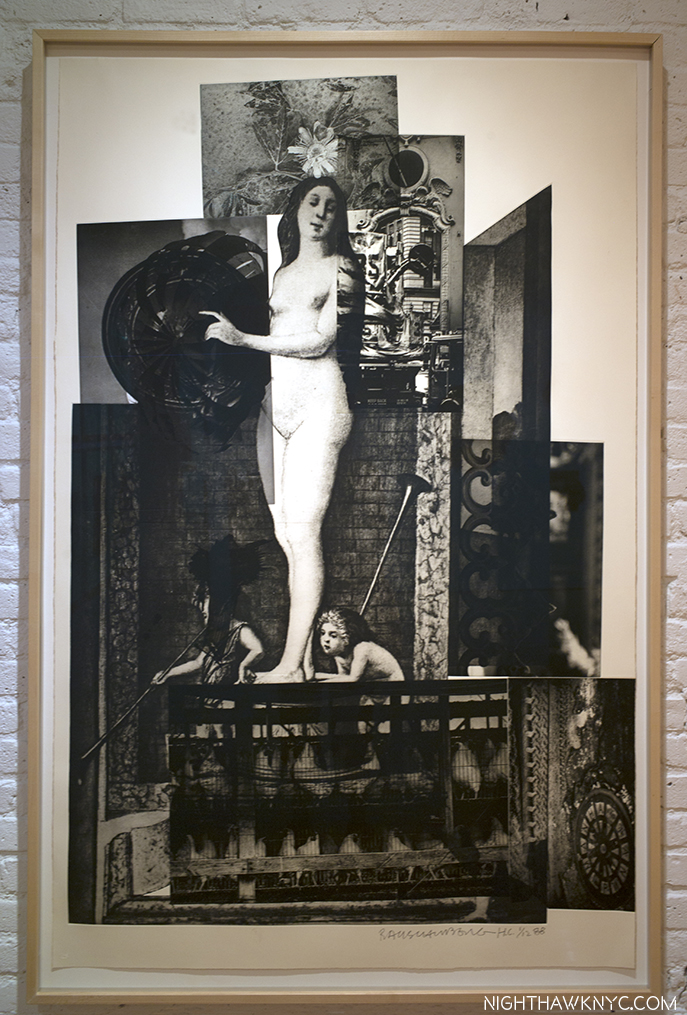
Bellini, #4, 1988, Intaglio in 7 colors on Arches paper. Giovanni Bellini’s Allegory of Vanitas, c.1490 completely restaged.
Down in SoHo, a gem of a show featured rarely seen pieces in a well known but little studied genre of Rauschenberg’s work- Show Posters. Todd Alden and Alden Projects presented a fascinating array of Posters by Rauschenberg, and Artists in his “Early Network,” including Jasper Johns and Cy Twombly, in a show of the same title. The Posters include both unique designs and designs adopted from existing works, or Photographs. Little known is that Rauschenberg created show Posters, continuously, for most of his career. A very nice selection of them from 1959-72, along with an incredible selection of ephemera from the “9 Evenings” theatrical collaboration between Artists and Bell Labs engineers in 1966 was on view. Shows of Rauschenberg’s Posters haven’t happened often after they were included in the 1977 Rauschenberg show that Walter Hopps curated for the National Collection of Fine Arts, which travelled to MoMA.
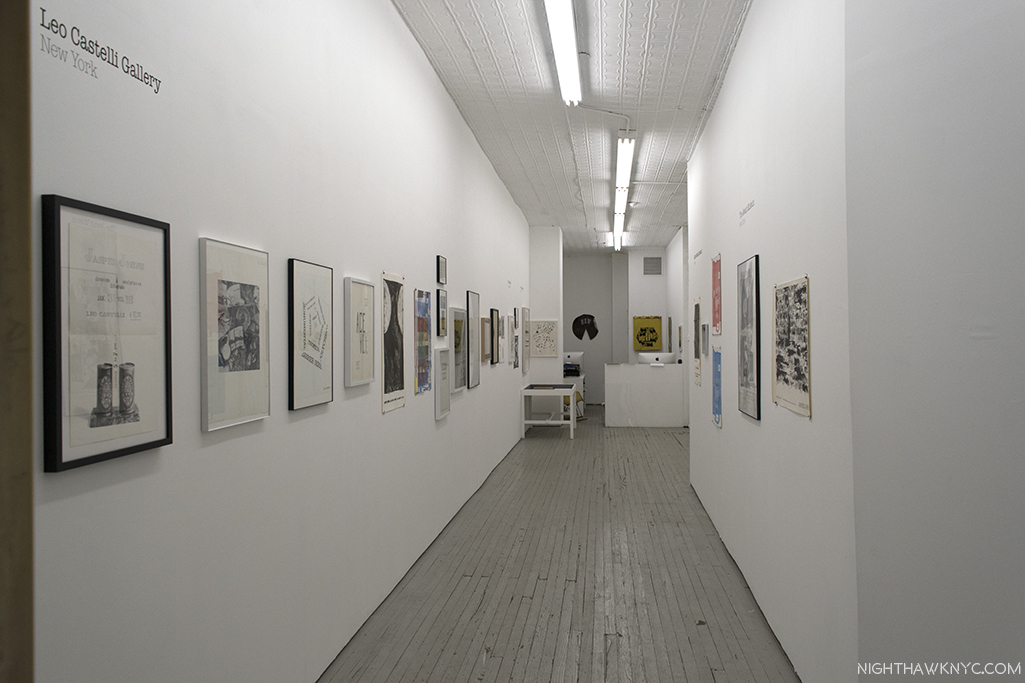
Robert Rauschenberg: Early Networks at Alden Projects. Installation view. Left are Posters for shows by Jasper Johns and Rauschenberg from the early 1960’s.
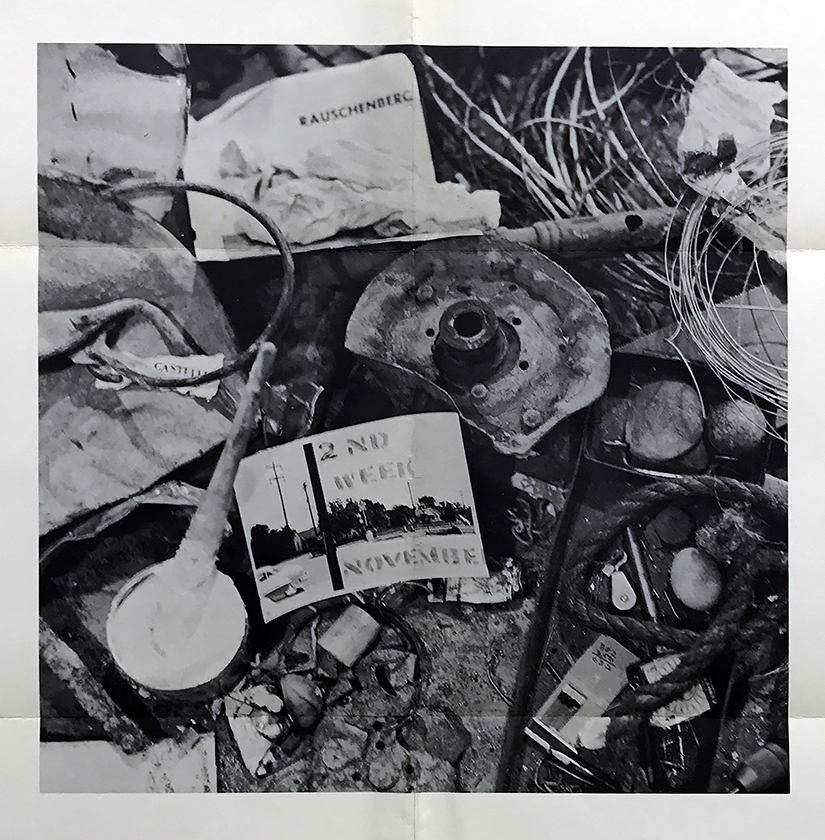
Poster for Leo Castelli’s November, 1961 show, showing folds which was the way it came. *Photo courtesy of Alden Projects.
What could be more Rauschenberg then to see the announcement for the show, and it’s title, among a pile of debris, where they, too, become “found objects”- like his materials? Not to mention it’s also a great Photograph, and appears as such in the book, Robert Rauschenberg: Photographs 1949-62 1, though it was, no doubt, taken with the intention of being used for show publicity.
The Jewish Museum piece is both historically important, being for the first ever Rauschenberg Retrospective (the Artist was all of 37), a major event being the first such show at the museum. It was followed by a similar show for Jasper Johns, who also created a wonderful “Flag” Poster which is included in the show, the next year.
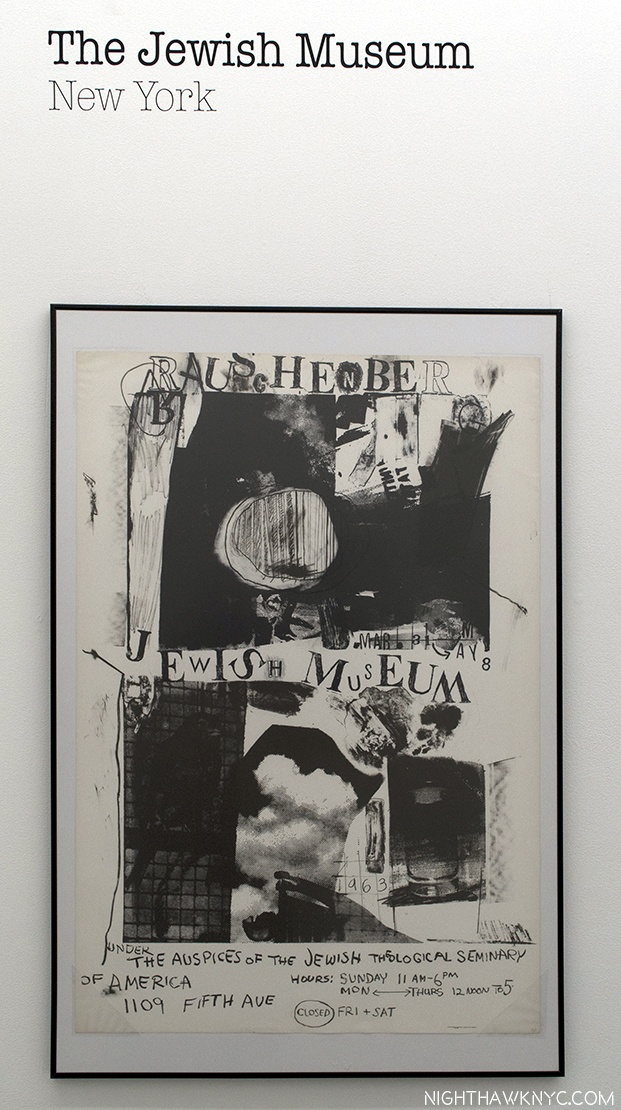
Rauschenberg’s rare Poster for his now legendary Retrospective at the Jewish Museum in 1963 features a work unique to this Poster, and the accompanying lithograph..
An audacious work. Rauschenberg was in the middle of his Silkscreen Paintings period, yet this work seems to me to have even more rawness than they do. His handwriting has an edgy look, too. Speaking of “edgy,” stylistically, it presages “punk” rock posters by 13 years. The lettering of his name on the top reminds me a bit of the “game” he played with his name in signing Ace, 1962, with the R separated from the “auschenberg” by 3 entire panels (see Part 2). Here he moves the “G,” and mirrors the first “R,” leaving “auschenber” looking a bit stranded. The mirroring of the “R” could be seen as mimicking his fondness for including mirrors of various kinds in his works. Given the historical importance of this show- the first retrospective of his work, in 1963, only 10 years after the Arno River incident I led off Part 1 of this series about, and the first retrospective presented at the Jewish Museum, it’s a remarkable piece all around. The only familiar image from the Silkscreen series Rauchenberg brought with him to this Poster appears to be the partially filled glass of water, which could be a reference to the fact that at the time, the Artist was only 37 and had been creating for about 13-15 years. He would go on to create for another 45 years. The glass of his career was barely 1/3 full by that point.
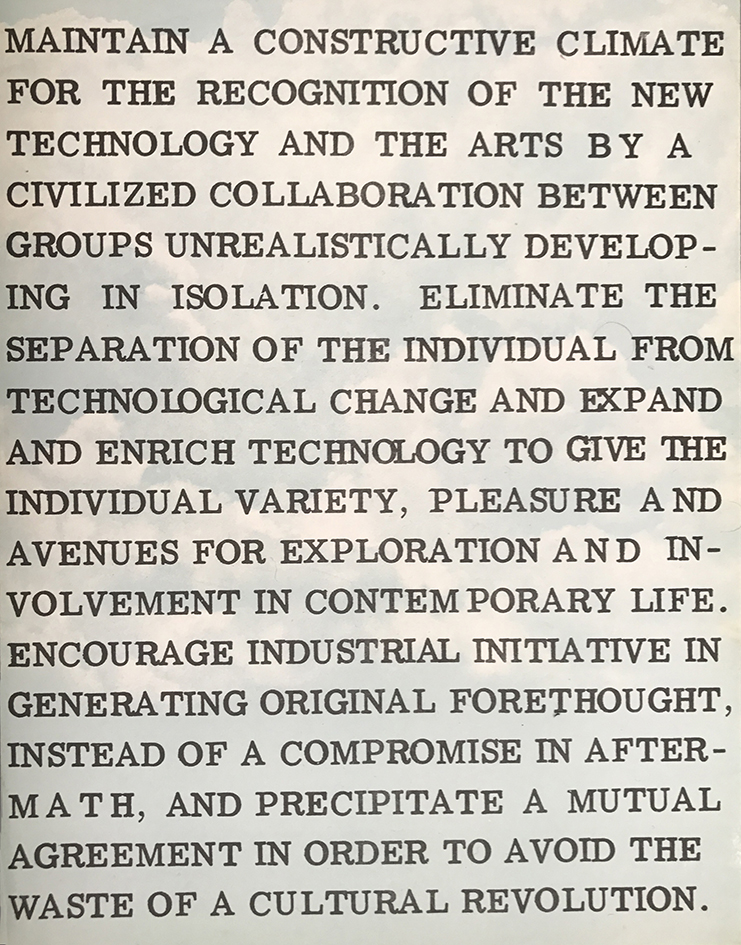
Prophetic. Rauschenberg “Art & Technology” Letterhead, from around the time of “9 Evenings” (1966), an epic series of theatrical collaborations between Artists & Bell Lab engineers at the 26th Street Armory. Rauschenberg’s piece was the infamous “Open Score” tennis match, used technologically enhanced rackets that controlled the lights in the Armory. One of the two players was Artist Frank Stella. “Open Score” may be seen here. *Photo courtesy of Alden Projects.
Over at Rauschenberg: Outside the Box, at Jim Kempner Fine Art in Chelsea, this large work served to be another example of Rauschenberg bringing the viewer into his work, something he does often, as I pointed out in Part 1. In this case, not only is there a chair as there is in Pilgrim, 1960, which I wrote about in Part 1, by 1990, Rauschenberg has become fascinated with reflective/shiny metallic surfaces, which, as seen below, reflect (mirror) whatever is in front of them, bringing the room, and the viewer into the work (and making Photographing it challenging).
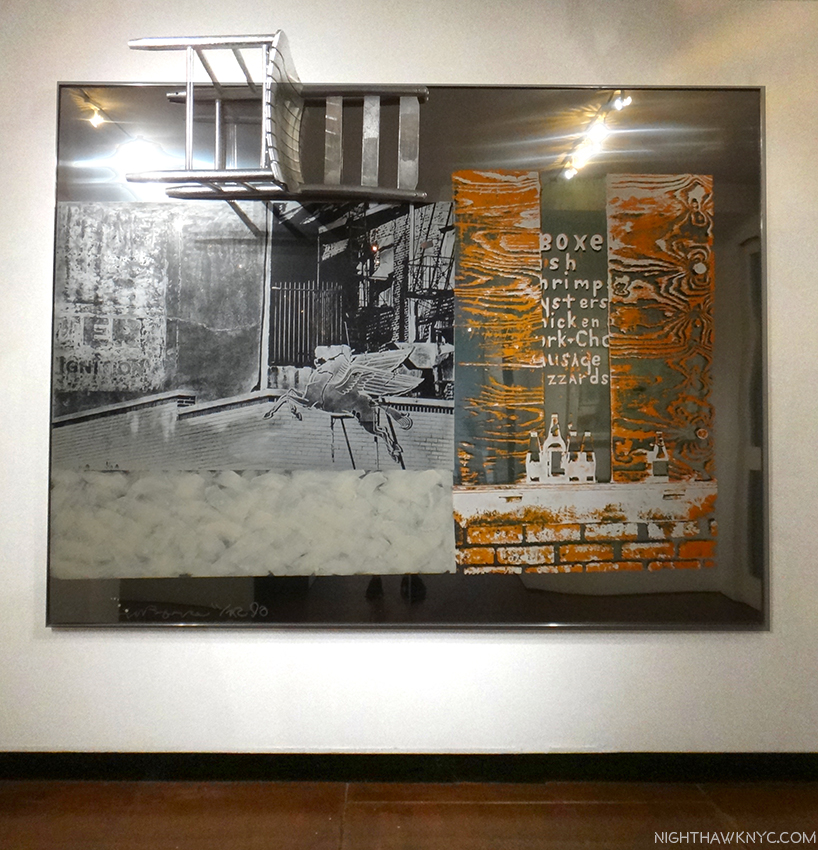
Pegasits, from ROCI USA (Wax Fire Works), 1990, Screenprint, wax, polished steel with painted wood chair. 8 feet by 6 feet.
Susan Weil: Now and Then at Sundaram Tagore Gallery. The first collaborator of Robert Rauschenberg, as was beautifully shown at MoMA’s Among Friends, where Susan Weil is Rauschenberg’s collaborator, and subject, of their large blueprint piece, Sue, ca. 1950, (which I showed near the beginning of Part 2 of this series), married Rauschenberg in the summer of 1950. They had a child, Christopher, now the head of the Rauschenberg Foundation, but separated almost a year later, and divorced in 1953, though they remained close after separating. Sharing much of the same Art education background with Rauschenberg, including both going to Black Mountain College beginning in 1948, her Art career had a solid foundation. So, it’s no surprise that she has continued creating, now, for almost 60 years. Their romantic relationship now looks like a small part of her long career.
So, what has she been up to since? A selection of her work from 1972 to date was on view at Sundaram Tagore Gallery this past June, into July, though it was heavily slanted to newer work, with 12 of the 24 pieces on view being from 2016-17.
A number of recurring themes were included. Hands- seen in Leftovers, below, which extrapolates the hands from da Vinci’s Last Supper, and Percept Prespect, shows three views of a cupped hand in the shape of triangles, with each succeeding one receding into space/getting closer to the wall. The effect is akin to falling into the open palm, complete with a sense of space within the work. Trees were, also, the subject of a few works. Her work often has a sculptural element to it, as if it is coming out from the wall to meet the viewer. Many of the works reveal a fondness for using unusual materials and taking images apart. Also on view was a vitrine containing a selection from her journals, which she has been keeping all along.
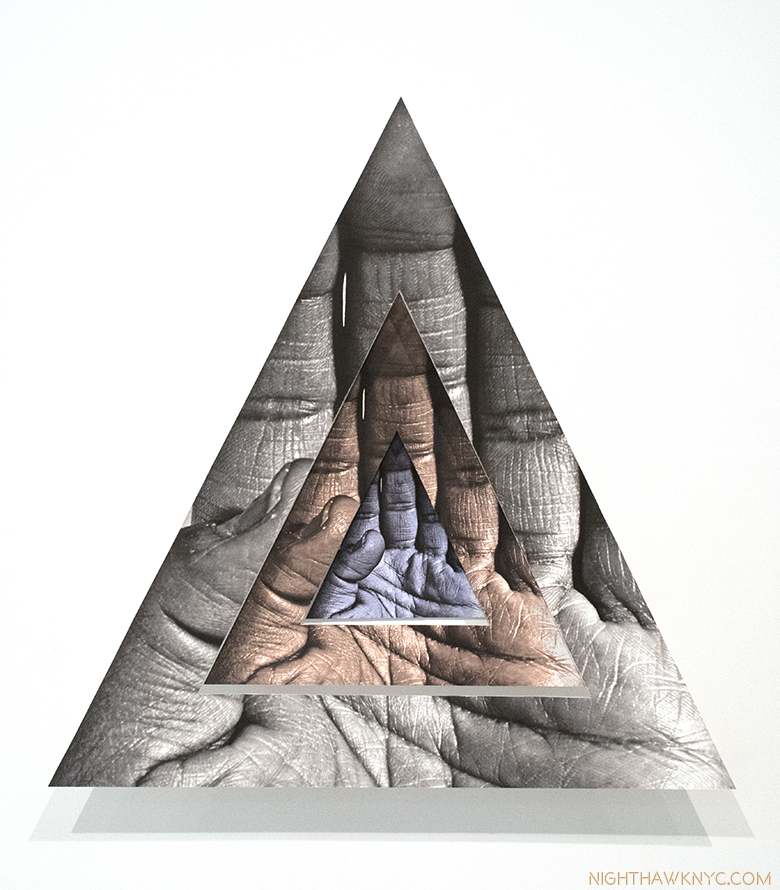
Susan Weil, Percept Prespect, 2015-16, Inkjet print mounted on paper mounted on Dibond, Each shape is set at different receding distances from the wall, large to small.
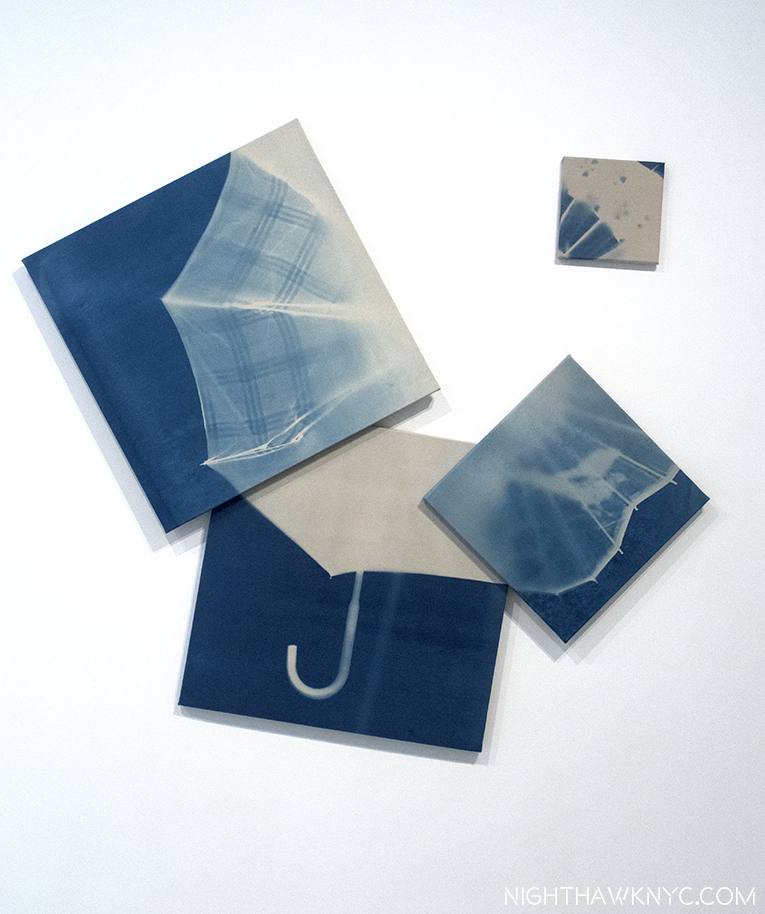
Coming full circle. As she had begun doing with Rauschenberg in the late 1940’s Susan Weil has continued making Blueprints. Here, Penumbrella, 2009, Blueprint. Umbrellas, also, appear frequently in Rauschenberg.
It might be tempting to look for Rauschenberg in her work, but that would be doing both of them a disservice. Susan Weil was “there at the beginning,” and they collaborated for a good many of both of their formative Artistic years. Personally, though there may be some “intriguing echoes” in her work, I don’t see anything more to it than that. She has continually stood on her own and followed her own path, and it was a rare pleasure to see such an interesting overview of her accomplishments.
In thinking about the “sum” effect (sorry) of these 5 shows, the name Man Ray came to mind. They have quite a few things in common. They both worked in an extremely wide range of mediums and broke boundaries in every one. Both had Artistic friends who were associated with various Art “movements,” yet they, themselves, remained beyond category. Both have areas of their achievement that is under-known. Yet, in all the research I did Ray’s name never came up as an influence, or, in fact, was never mentioned in the Rauschenberg interviews I’ve seen, though Man Ray only died in 1976. Of course, some have compared Rauschenberg to Picasso, also because of that wide range of mediums, and because of how innovative both were. While Rauschenberg saw Picasso’s work early on in Paris, and wanted to meet him, I don’t know if he ever did. Rauschenberg strikes me as an Artist who, primarily, especially early on, was living in the moment, perhaps as influenced by his creative friends (including older friends/acquaintances who were Abstract Expressionists) as by Art history (some of his works from the mid-1950’s on feature pieces of masterpieces from the past, like “Bellini #4, 1988, shown earlier, though there is more visual evidence to say that more recent Art history may have been an influence on him- as something to break away from, while he adapted some of it’s techniques). Though Man Ray worked in many mediums, and is, perhaps, best known for his Photographs, he, like Rauschenberg, considered himself a Painter. In 1961, Ray said this about Photography and Painting- “I paint what cannot be photographed, that which comes from the imagination or from dreams, or from an unconscious drive. I photograph the things that I do not wish to paint, the things which already have an existence2.” It’s hard not to see Rauschenberg in that, too..
“Now I’m standing in a doorway with my overcoat on
It really feels like summer’s gone”*
Making 25 trips to these shows from June 1, though their closing on September 30th, these Posts could well be titled “What I Did This Summer.” Taken as a whole, I think these 5 shows could be summed up in one word- “Surprise.” One of the magical things about looking at a Rauschenberg is that you never really see all of it. Certain parts of it speak to you one time, something else the next. It looks different…new to you, each time you see it. Then, there are the works you’ve never seen, since he was so prolific for so long, that surprise you for being unfamiliar. On my first visit, and on my 25th visit there were surprises- new details that altered my thinking about a work, new connections with other works, recent or past, and, new possibilities from them for the future.
I’m not alone in seeing those “new possibilities.” Right now? I can’t think of another Artist who is more influential on other Artists based on what I see in shows these days than Robert Rauschenberg. Not even Picasso.
As the elevator doors closed on my final visit to a Rauschenberg related show this summer, as shown above, I was reminded of his quote from the 1959 MoMA catalog for the show 16 Americans, “Painting relates to both art and life. Neither can be made (I try to act in the gap between the two).” In that “gap” is where I spent my summer.
*-Soundtrack for this Post is “Summer’s Gone,” as recorded by The Kinks. Words & Music by Ray Davies, publisher unknown. R.I.P.-Tom Petty.
Thanks to Gina Guy & David White, of the Robert Rauschenberg Foundation, for their assistance
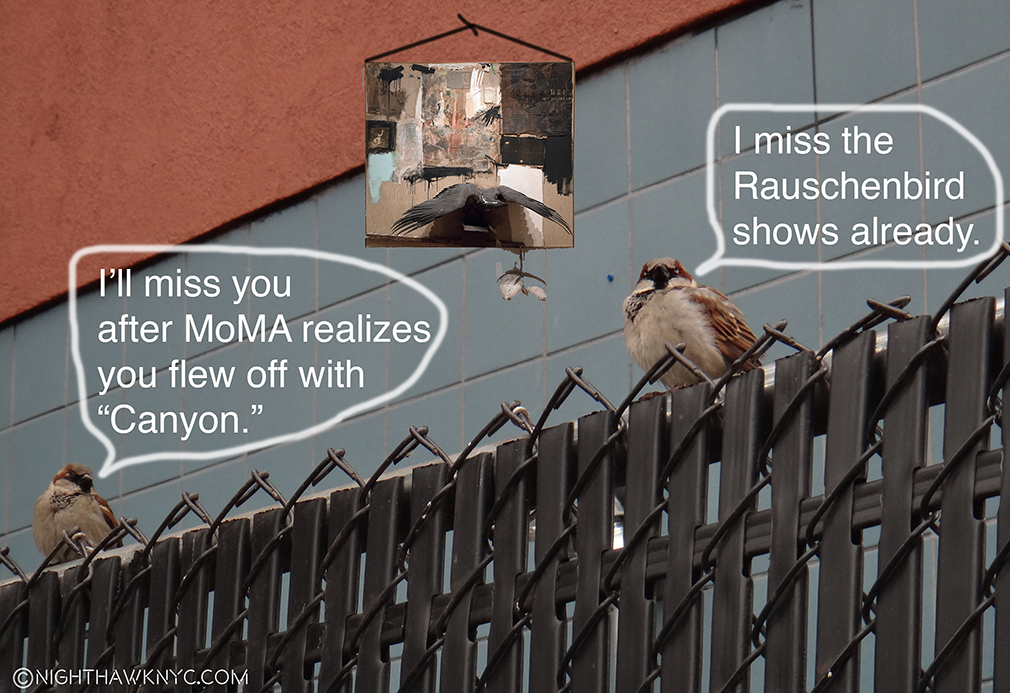
“On the Fence,” #12, The Mind the Canyon” Edition. (The Postscript to this episode follows, below.)
NighthawkNYC.com has been entirely self-funded and ad-free for over 6 years, during which over 250 full length pieces have been published. If you’ve found it worthwhile, you can donate to keep it going & ad-free below. Thank you!
Written & photographed by Kenn Sava for nighthawknyc.com unless otherwise credited.
To send comments, thoughts, feedback or propositions click here.
Click the white box on the upper right for the archives or to search them.
For “short takes” and additional pictures, follow @nighthawk_nyc on Instagram.
Subscribe to be notified of new Posts below. Your information will be used for no other purpose.

